THE BUSINESS PRESIDENT


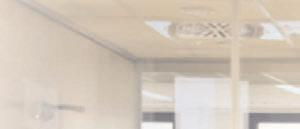







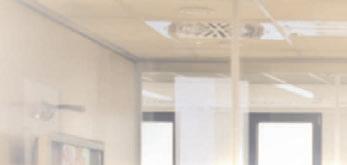

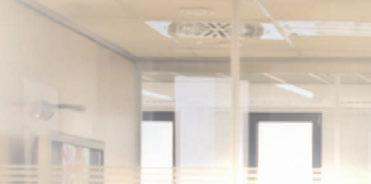













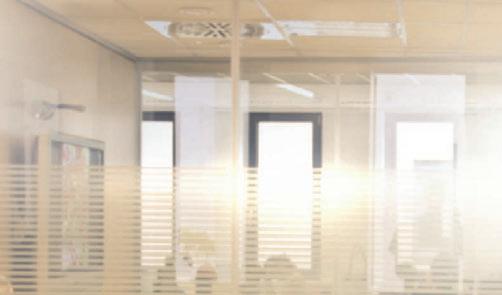










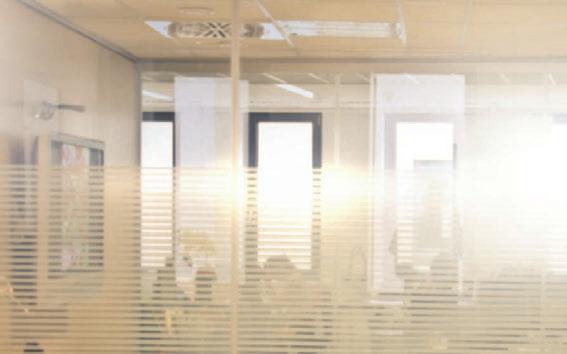
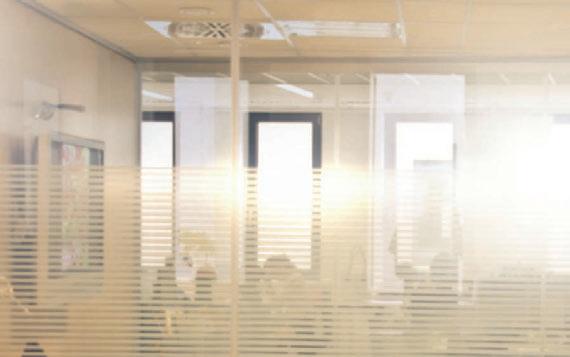
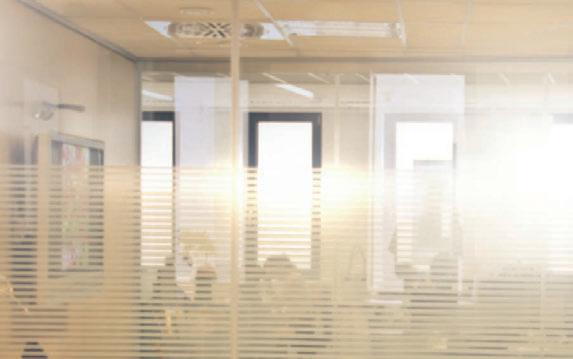



Inaugurated as the 45th President of the United States of America, Donald J. Trump held a speech characterized as “combative, populist and nationalistic” by the Diplomacy&Trade analyst who is of the view that the world best brace itself for a more aggressive and assertive United States, with a businesslike approach to complex international issues.
SEE ANALYSIS ON page 7









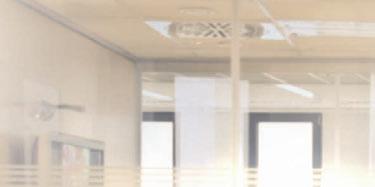







FOCUS country






























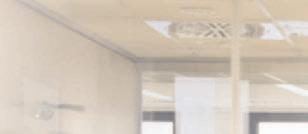

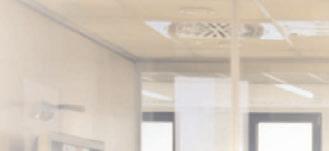
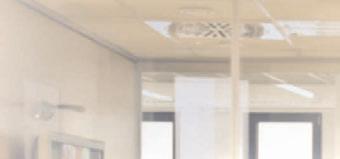
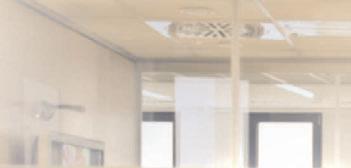
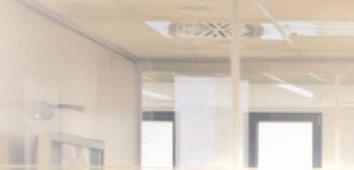


























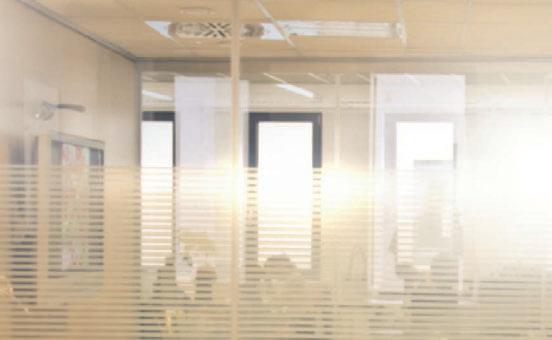



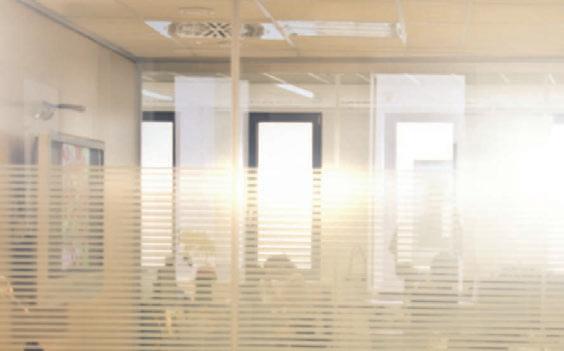

The Netherlands
“My real ambition here has been to make sure that Hungary gets even more cemented into the European fabric, that family of nations that call themselves together the European Union,” the Dutch Ambassador to Hungary, Gajus Scheltema tells Diplomacy&Trade. In an extensive interview, he also talks about transparency as a very important element of a democratic society, an element that has a strong influence on decision-making for Dutch investors, who make up the second biggest investment community in Hungary. “

Mutual Attraction

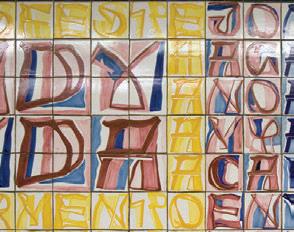






















In our WittyLeaks series, diplomats accredited to Budapest share personal accounts of their experiences on ‘excursions’ into Hungarian culture, art, gastronomy & scenery. This month, the Portuguese Ambassador to Hungary, Maria José Morais Pires elaborates on the diverse connections and mutual attractions between Hungary and Portugal.

977155898070017002 FEBRUARY 2017 HUF 1710 EUR 6

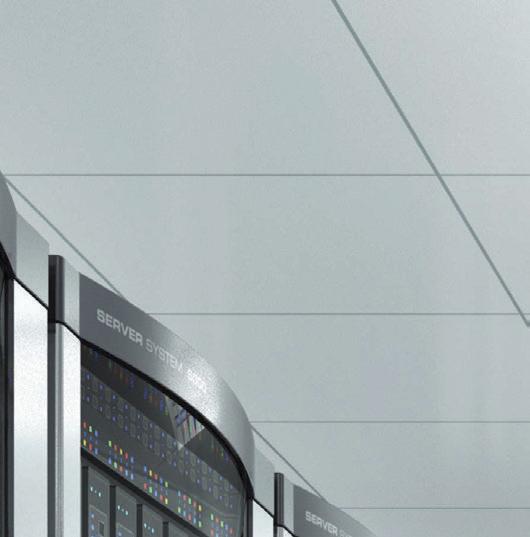


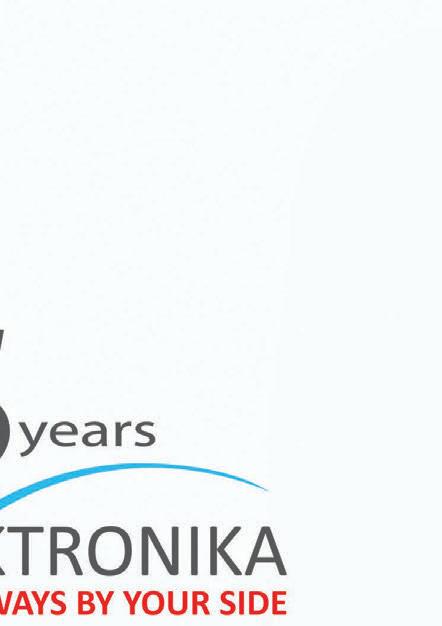

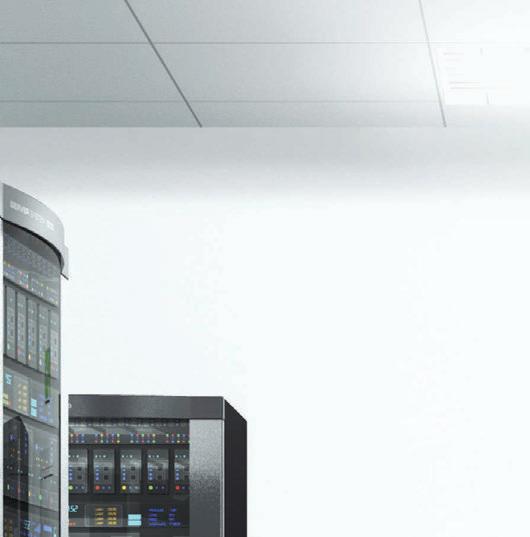



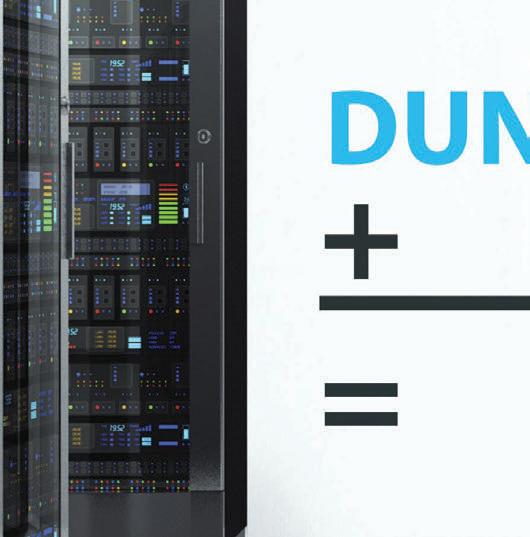

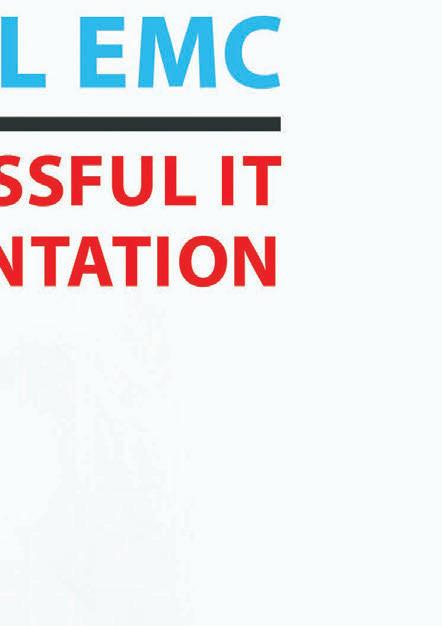




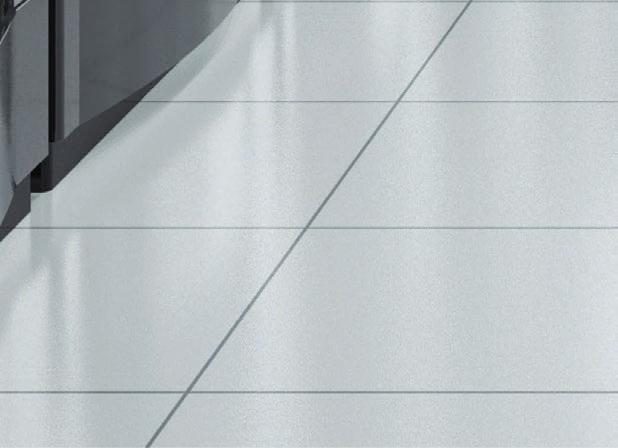



letter from the publisher
Earthquakes are not as common in the US as the rest of the world, but on January 20th at 12 noon (EST), Washington D.C. was the epicenter and the whole world shook as Donald J. Trump was sworn in as the 45th President of the United States. The aftershocks continue as, in fact, in just the first week of his presidency, President Trump signed a record breaking number of Executive Orders, pretty much in line with his campaign promises. Our international affairs analyst predicts the world can expect a “combative, populist and nationalistic” Trump presidency.
Netherlands is the country in focus for this issue of Diplomacy&Trade. A country half the size of Hungary in area but, with a population 70% larger. It is also one of the biggest sources of investment for Hungary. The Focus features an interview with the Dutch Ambassador to Hungary, Gajus Scheltema who discusses issues of economic relations (including trade and investment) as well as cultural, social and civil ties. He places special emphasis on transparency, as a very important element of a democratic society, an element that has a strong influence on decision-making for Dutch investors. We also present the Netherlands-Hungarian Chamber of Commerce and some of the largest Dutch companies present in Hungary as well as Dutch businesspeople living and working in this country.
Our culture page reviews ‘The Citizen’, a new Hungarian movie about a good-hearted man from Africa who wishes to be a Hungarian citizen.

This month’s WittyLeaks article is authored by the Portuguese Ambassador to Hungary, Maria José Morais Pires, on diverse connections between her country and Hungary.
 Peter Freed PUBLISHER
Peter Freed PUBLISHER

06 COMPANY BRIEFS
07 ANALYSIS Not even a ‘Honeyday’
08-23 HOLLAND FOCUS
Interview with Ambassador Gajus Scheltema; Dutcham; Heineken; Schiphol Airport; KLM; ING Bank; Irota Ecolodge; Budapest Marriott Hotel GM; Flower Power; Autobinck; Port of Rotterdam; Alsmeer Flower Market, Affidea; Circular economy; Duna Incentives
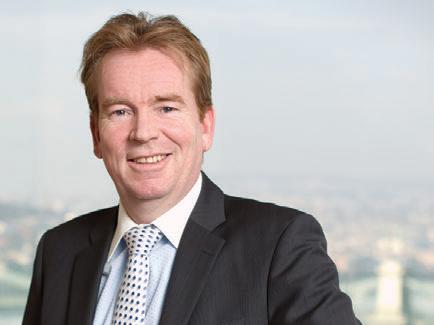
24 WITTY LEAKS by Portuguese Ambassador Maria José Morais Pires
25 GIFT PAGE
26 MOVIE
New Hungarian film: The Citizen
27 SOCIETY
28-29 WHAT’S ON
Concerts, festivals, events and exhibitions in and out of Budapest
30-31 GASTRONOMY & VINE
Furmint February; Bocuse d'Or, Valentine’s Dinner at Baraka, Vince Budapest 2017; 7th Prestige Award Ceremony; Diplomats’ Wine
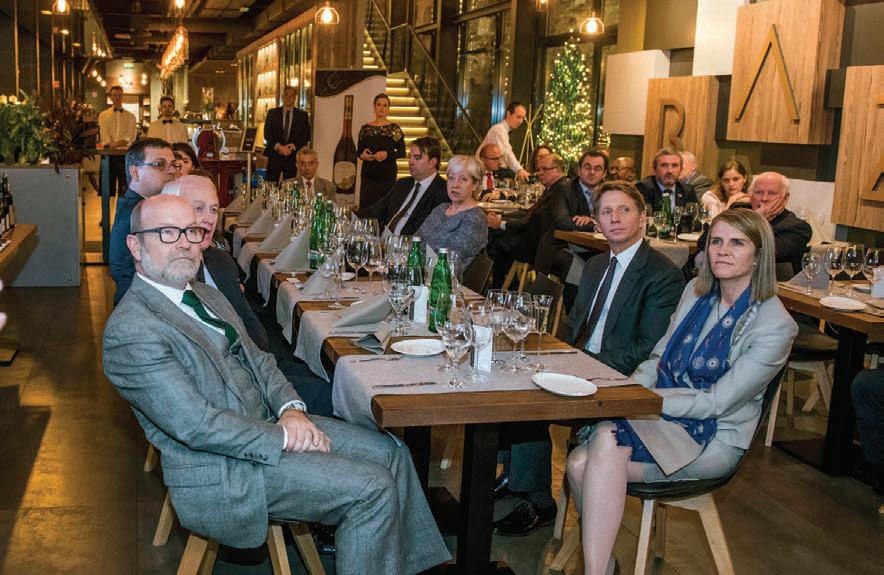
PUBLISHER: Peter Freed EDITOR: Réka A. Francisck COPY EDITOR: Joyce Freed PHOTO EDITOR: Dávid Harangozó
SALES & MARKETING DIRECTOR: Tamás Varga DISTRIBUTION MANAGER: Tibor Ocsenás
ADMINISTRATION: Judit Ludányi ASSISTANT: Ágnes Rapaport
CONTRIBUTORS: Sándor Laczkó, Tamás Magyarics, Réka A. Francisck, Maria José Morais Pires, László Doszpod
PHOTO CONTRIBUTORS: White House Photo (Cover), Shutterstock.com, Pixabay.com, Can Stock Photo Inc., 123RF.com, Csaba Pelsőczy, Invitech, Prologis, Sándor Csudai, U.S. Air Force/ Marianique Santos, Creartphoto.hu, KLM, Herman Wouters, Affidea, Márton Tordai, Laura Nagy/Prisma, Eveline Eijkhout, Mariëtte Harms, Lennard de Klerk, Embassy of Portugal, Lili Ország, Prestige Reserve Club, Furmint Photo, Zsolt Batár, Tamás Géza Róth/MSÚSZ, Ing, Mark van den Brink, MTI Photos: János Marjai,
CZECH FOCUS - COMING SOON
Diplomacy&Trade is preparing a special Focus section on Czech-Hungarian relations. The Czech Republic is Hungary’s 8th most important trading partner and a fellow member of the Visegrád cooperation. The Czech economy is one of the fastest growing in the European Union, boosted - similarly to the Hungarian - by the automotive industry. Our Focus will feature an interview with the Czech Ambassador to Hungary, Juraj Chmiel discussing issues of economic relations (including trade, investment and tourism) as well as political, social and cultural ties. The section will also include a presentation of the activities of the Czech-Hungarian Business Club that encourage the development of bilateral trade and business relations.
 Noémi Bruzák, Szilárd Koszticsák, Zsolt Szigetváry
Noémi Bruzák, Szilárd Koszticsák, Zsolt Szigetváry
cont en ts FEBRUARY 2017 |DIPLOMACY & TRADE www.dteurope.com 4 Copyright 2004-2017 Duax Kft., all rights reserved | ISSN 1589-8075 This magazine is produced by Duax Kft. The opinions published in the magazine do not necessarily reflect the opinions of Duax Kft.
Budapest Marriott Hotel General Manager Rick Enders pages 17
photos by CSABA PELSŐCZY, DÁVID HARANGOZÓ, PIXABAY.COM We welcome inquires for advertising in this issue. PLEASE CALL TAMÁS VARGA FOR FURTHER INFORMATION +36 209350250 - tvarga@budapestweek.com AND DON’T FORGET monthly in print - daily on the web www.dteurope.com
New Hungarian movie, 'The Citizen' pages 26
COPIES ARE AVAILABLE AT SELECTED RELAY AND INMEDIO OUTLETS IN MAJOR HUNGARIAN CITIES. NEWSSTAND PRICE: HUF 1,710 or EUR 6 - Subscriptions are available for an annual fee of EUR 72 in Hungary, or EUR 90 to all other destinations. SEND REQUESTS AND INQUIRIES TO DUAX KFT. H-1034 Budapest, Bécsi út 60. TELEPHONE [+36-70] 320-3051 | FAX [+36-1] 350-5660 E-MAIL editor@dteurope.com | ADVERTISING adsales@dteurope.com
05 ON THE RECORD
Members of the Budapest diplomatic corps at the presentation of Diplomats' Wine page 31
on the record
PHARMABOSSCHOSEN MANOFTHEYEARINHUNGARY
Erik Bogsch, CEO of the Hungarian pharmaceutical giant Gedeon Richter, has been chosen 2016 'Man of the Year' in Hungary by the business weekly Figyelő in recognition of positive financial and moral performance.
The choice was not easy: at the Figyelő TOP200 gala held last fall for over 400 business decision-makers, more than 150 nominated a candidate for the ‘Man of the Year’ award.
From the ten most nominated candidates, the editorial board of the magazine chose the leader most worthy of the title. The weekly magazine does not only select from among business people, as many exceptional achievements could be found last year also in scientific, cultural and sports life.
The business magazine’s intention was to recognize an industry and a company, that preserves decades of tradition and strives to keep its research and development activities in domestic centers in one of the most future-oriented industrial segments, the pharmaceutical industry. In 2016, Gedeon Richter (under the leadership of Erik Bogsch), achieved a level of development that enabled it to purchase - with the accumulation of its own values - a foreign (in this case, Swiss) company that well matches its profile. The other achievement that the weekly emphasized is that Gedeon Richter has been able to break into the very strict and critical US market with its proprietary pharmaceutical product, cariprazine.
DEPARTINGUSAMBASSADOR RECEIVESHUNGARIANSTATE AWARD

The US Ambassador to Hungary, Colleen Bell received the Middle Cross of the Order of Merit of the Republic of Hungary awarded to her by President János Áder for her work in the interest of developing bilateral relations. The award was handed over, a few days before the Ambassador’s departure, by Minister of Foreign Affairs and Trade Péter Szijjártó who said the US Ambassador is a good friend of Hungary. He was of the view that Ambassador Bell’s commitment was absolutely essential for rebuilding cooperation between the US and Hungary, and that the US diplomat demonstrated unconditional respect towards Hungary. The Minister highlighted that Colleen Bell arrived in Budapest two years ago at a time which was not the best period in bilateral political cooperation, but that now the situation has changed significantly. Upon receiving the decoration, Ambassador Bell said that, beyond doubt, the Transatlantic community is facing a great many challenges today, which draws attention to how important it is to forge alliances, to make joint efforts and to stand up for the values that we regard as important. She reiterated that when US President Barack Obama appointed her to the position of Ambassador to Budapest, she said she would travel around the whole country, and would visit every county and national park as well as smaller and larger localities. She did so in order to build even further relations between the Hungarian and American people.
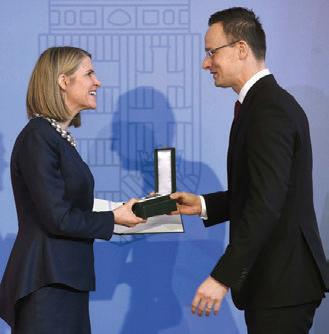
HUNGARIANATHLETES OFTHEYEAR2016
Three-time Rio Olympics champion swimmer Katinka Hosszú and saber fencer Áron Szilágyi, also an Olympic champion in Rio de Janeiro last year, have been elected Hungary’s 'Athletes of the Year 2016' by the country’s sports journalists.
At the 2016 Summer Olympic Games, Hosszú was the most successful member of the Hungarian team, pocketing three gold and a silver medal by winning the women’s 200- and 400-meter individual medley events (smashing the world record in the latter) as well as the 100-meter backstroke and finishing second in the 200-meter backstroke. She was also voted the third best European athlete of the year in a survey involving 27 European news agencies. Finishing ahead of her were Real Madrid's Portuguese footballer Cristiano Ronaldo and British tennis player Andy Murray.
Hungary’s top male athlete of 2016, Áron Szilágyi, arrived in Rio to defend the men’s individual saber fencing Olympic title he won in London in 2012. He achieved that by defeating Daryl Homer of the United States.
The Coach of the Year title went to Hosszú’s American coach and husband Shane Tusup. In the team category, it was Hungary’s national football (soccer) team that triumphed with its qualification for the top 16 at the European Championship.
The Athlete of the Year title has been awarded in Hungary since 1958.


PÉCSTO RECEIVEUNESCO RECOGNITION
UNESCO announced that the southern Hungarian city of Pécs has been chosen as one of the 16 recipients of the UNESCO Learning City Award 2017 making it the first Hungarian city to receive this recognition.
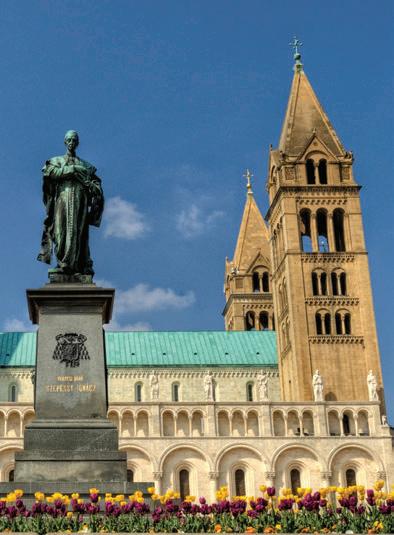
According to UNESCO, this award is conferred on cities that demonstrate exemplary commitment to promoting inclusive education and lifelong learning at the local level. While learning cities share certain characteristics, every learning city is unique. A statement by the UNESCO Institute for Lifelong Learning (UIL) points out that “Pécs has initiated a forum to serve as a platform for experts and stakeholders to further learning city development.”
The statement quotes UIL Director Arne Carlsen’s remarks to the awardees: “I would like to congratulate the awarded cities for their great efforts and devotion to promoting access to education and lifelong learning opportunities for their citizens. These efforts are impressive and go a long way towards ensuring improved living standards for everyone. I hope the UNESCO Learning City Award will motivate the awardees and other cities worldwide to continue working towards inclusive overall development in order to make lifelong learning for all a reality.’
The award will be presented during the 3rd International Conference on Learning Cities in Cork, Ireland, to take place between September 18 and 20.
February
March
BANKOFCHINACONCLUDES AGREEMENTSINHUNGARY
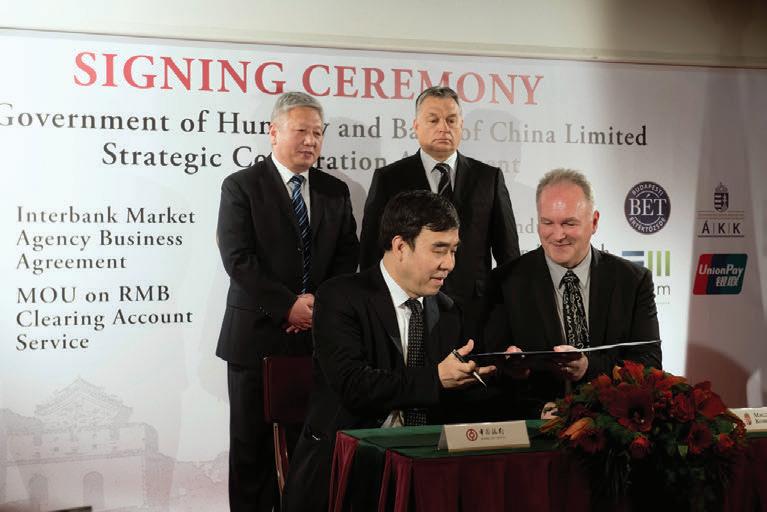
China’s biggest commercial bank, the Bank of China (BoC) has concluded a number of cooperation agreements in Budapest.
A strategic cooperation agreement with the Hungarian government was signed by Minister of State for Parliamentary Affairs in the Ministry of Foreign Affairs and Trade, László Szabó and the President and Chairman of the board of the Bank of China, Tian Guoli. Hungarian Economy Minister, Mihály Varga was of the view the agreement would help further intensify Hungarian-Chinese economic relations. Other agreements were signed with the National Bank of Hungary, the Budapest Stock Exchange, the State Debt Management Agency and Eximbank. Chairman Tian Guoli was quoted by the Hungarian News Agency MTI as saying that BoC and China Unionpay, a financial services corporation headquartered in Shanghai, will jointly issue a yuan debit card in Hungary. This will be the first yuan bank card in Central and Eastern Europe, he stressed. The cards will be managed in Hungarian forint and Chinese yuan and will be accepted by more than 2,000 points of sale and hundreds of ATMs, the chairman pointed out. The Bank of China plans to introduce the yuan bank cards in Prague, Vienna and Belgrade as well. BoC Chairman Tian Guoli also addressed the participants of the 4th Lamfalussy Lectures Conference in the Hungarian capital.
The Bank of China opened a regional headquarters in the Hungarian capital in December 2014.
NEWINNOVATIONCENTER INBUDAPEST
US-based investment management company BlackRock is to open a service and innovation center, setting up an innovation center in Budapest and creating 500 jobs. The new innovation Center is said to deal with product development and the management of client data, as well as creative marketing. BlackRock managing director Patrick Olson said the company had picked the Hungarian capital as a venue because of the local education system, the quality of infrastructure, security, quality of life and the government’s commitment to the endeavor, and it aims to build a ‘significant presence’ in Budapest by the end of 2017. The Hungarian government promised to provide an incentive grant in the amount of HUF 280 million (appr. EUR 900,000), which is to be spent for training new hires.
www.dteurope.com DIPLOMACY & TRADE| FEBRUARY 2017 5 photos by JÁNOS MARJAI/MTI, NOÉMI BRUZÁK/MTI, CAN STOCK PHOTO INC., SZILÁRD KOSZTICSÁK/MTI
NATIONAL DAYS
UPCOMING
6New Zealand National day 15 Serbia National day 16Lithuania National day 24 Estonia National day 25 Kuwait National day 28 Egypt Independence day
1Bosnia&Hercegovina National day 3 Bulgaria National day 6 Ghana Independence day 15 Hungary National day 17 Ireland National day 20 Tunesia Independence day 21 Namibia Independence day 22 Morocco Independence day 25 Greece National day
9 Georgia National day 17 Syria Independence day 18Zimbabwe Independence day 30Netherlands National day
April
company briefs
CHINESE FUND TO BUY HUNGARY’S INVITEL
Hungary’s leading alternative telecommunications service provider Invitel is to be sold by its current owner Magyar Telecom (not to be confused with Magyar Telekom, Hungary’s largest telco provider!) to the ChinaCEE fund (which is backed by China Exim Bank and invests in Central and Eastern Europe) for an enterprise value of EUR 202 million. Mid Europa Partners (MEP), which holds a 51% stake in Magyar Telecom, has agreed on the sale while the approval of Matel Holdings Limited (with 49% ownership), is being solicited via a consent request. Invitel is Hungary’s second-largest incumbent fixed line telecommunications and broadband internet services provider, with more than 1 million homes served, and serves both residential and corporate customers. Commenting on the sale, David Blunck, the Invitel CEO pointed out that “under Mid Europa’s leadership, we have strengthened Invitel’s position in the Hungarian market and we are grateful for their support. We look forward to further developing the business under the ownership of CEE Equity.” CEE Equity Partners is the investment adviser to the China CEE Investment Cooperation Fund, which was established by China Exim Bank in partnership with other institutional investors in central and eastern Europe.
MAJOR INVESTMENT BY HUNGERIT IN SZENTES

Hungarian family-owned HUNGERIT Poultry Processing and Foods Ltd. is implementing an investment of more than EUR 16.4 million in Szentes, SE Hungary, resulting in the creation of 120 jobs by the end of 2018. The expansion consists of interconnected and mutually supportive project elements, involving building and technological development, and including, among others, the construction of a new coating hall, the installation of a filleting machine – the first of its kind in Hungary – and the implementation of a biological wastewater treatment plant, the Hungarian Investment Promotion Agency (HIPA) reports. By building on decades of tradition in poultry processing in Szentes, HUNGERIT – founded in 1990 by Hungarian, German and Italian investors – has developed into a recognized, popular brand, not only in Europe but also in many countries around the world. The company, which is now owned by a Hungarian family, employed more than 1,600 people and realized sales revenue in excess of EUR 160 million in 2016, which makes it one of the largest enterprises in the Hungarian poultry sector. Domestic and foreign annual sales revenue is equal. Exports are shipped to more than 30 countries; the processed products – including the Valdor product family – are offered not only on European shelves, but also in many Asian and African countries as well as in America. The Hungarian government provided aid in the amount of HUF 1.78 billion (appr. EUR 5.7 mn) by way of an individual government decision.
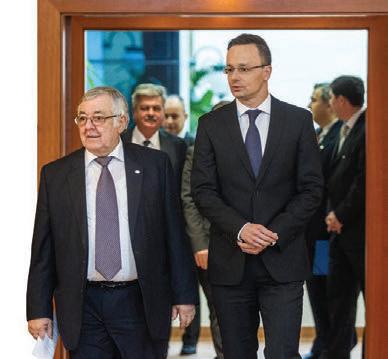
PROLOGIS ACQUIRES M0 CENTRAL BUSINESS PARK IN HUNGARY
Prologis, Inc., the global leader in logistics real estate, announced that Prologis European Properties Fund II (PEPFII) has acquired M0 Central Business Park in Hungary from IDI Gazeley.







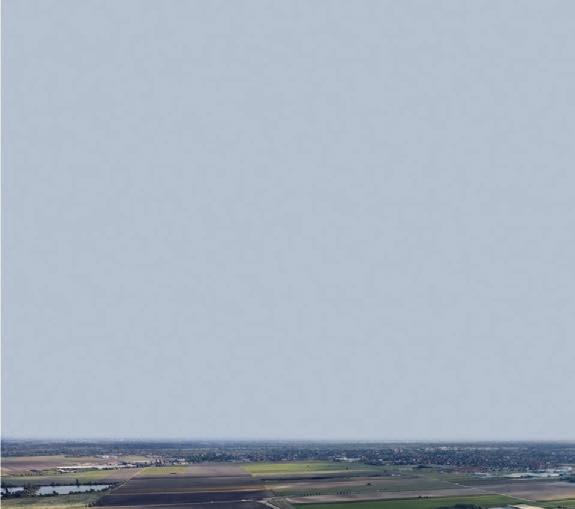
Two newly acquired, 100% let facilities totaling 31,443 square meters will become part of the adjoining 98% let Prologis Park Budapest-Sziget, which currently comprises seven buildings totaling 150,000 square meters. The park is southeast of Budapest in the sought after industrial zone of Szigetszentmiklós, which has direct access to national and international road networks via the M0 ring road. Customers of newly acquired facilities include Easi Uplifts, FM Logistics, Quality Logistics Management, United Performance Metals CEE and UTi Hungary. According to senior vice president and country manager for Prologis Hungary, László Kemenes, “Szigetszentmiklós is a core location for us in the Budapest market, and we have seen strong leasing activity there over the past 18-24 months. This acquisition gives us full control of the park, and we anticipate that it will provide new opportunity for us to create additional value in the future.”
SZIGET FESTIVAL STAKE SOLD
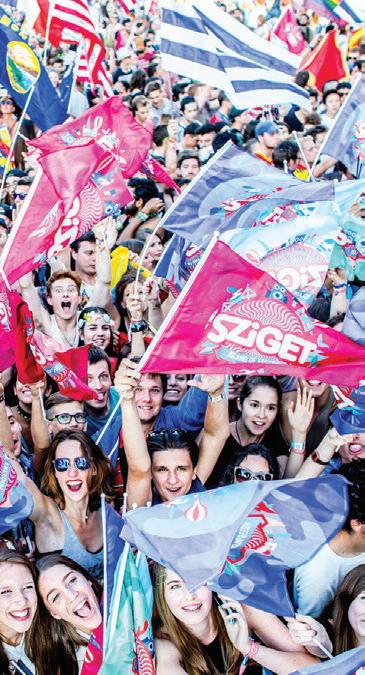
Global asset management firm Providence Equity Partners is buying Hungary’s Sziget, the organizer of the country’s largest festivals, aiming to expand the events internationally. Financial details about the transaction have not been made public. As the Reuters news agency reported, Sziget draws about 500,000 people every year to its flagship event held on an island (hence the name) of the Danube River in Budapest and hundreds of thousands more to half a dozen other festivals around Hungary. Now in its 25th season, it has received several ’best festival’ titles from the European Festival Awards. According to the website of the Hungarian edition of Forbes Magazine, the U.S.-based private equity firm Providence - which has total assets of about USD 47 billion under managementbought a 70% stake in Sziget. The new investors will help "further the development of the Sziget festivals and support Sziget's ambition to take its festival brands global", the statement said.
"We will be able to make a giant leap forward and embark on the ambitious projects that have been in our pipeline for some time," commented Sziget founder and owner Károly Gerendai, whose team will retain a 30% stake in the company.
PREMIUM CHOCOLATE FACTORY TO BE BUILT IN HATVAN

The first chocolate factory in Hatvan, east of Budapest, will be launched with a EUR 24.4 million investment of Ghraoui Chocolate Manufacturing Plc. The new unit will produce high quality chocolate for the European and Middle Eastern markets. The Hungarian Investment Promotion Agency (HIPA) provided professional assistance to support the investors during the whole investment process, from the site selection to finding the best suppliers. After the implementation phase of the green-field investment in 2017, the chocolate factory of 12,000 square-meters is planned to start operation in early 2018. 95% of the manufactured premiumquality chocolate products will be exported, but the investors have long term plans to enter Asian markets as well. Most of the 540 new jobs created in the next six years require special knowledge and training, which is covered by the company's training plan. According to a statement by the Hungarian Investment Promotion Agency (HIPA), Hungary offered a favorable investment environment, the strategic geographic location of the country and the reliable labor force that were considered as the key factors. While HIPA provided professional management consultancy services, the Hungarian government provided a subsidy based on an individual government decision through HIPA to the investment.
MAGYAR TELEKOM SELLS MONTENEGRIN UNIT

Hungary’s largest telecom services provider group Magyar Telekom (MTel) has signed an agreement with Hrvatski Telekom d.d. for the sale of its majority (76.53%) stake in Crnogorski Telekom A.D. Podgorica. The value of the package is about HUF 38 billion (some EUR 123.5). MTel said in a statement on the website of the Budapest Stock Exchange (BSE) that “the disposal of this stake is in line with Magyar Telekom’s renewed focus on its Hungarian operations where efforts are underway to further strengthen the Company’s position in the mobile market and its ICT capabilities, alongside maintaining investment in our fixed networks and raising penetration levels in those areas already served by high speed internet access." The statement goes on to say that Magyar Telekom also expects the transaction to accelerate the recent downward trend in its net debt ratio (net debt/total capital) such that by the end of March 2017, it will be within the targeted range of 30-40% as set out in its dividend policy. “As of September 30, 2016, the Company’s net debt ratio stood at 41.6%.” Following the closing of the transaction, expected by the end of January 2017, the Montenegrin operation will no longer be consolidated into Magyar Telekom Group’s financials. After the announcement of the sale, MTel rose 1.4% to HUF 517, a new 4.5-year high, on the Budapest Stock Exchange (BSE).
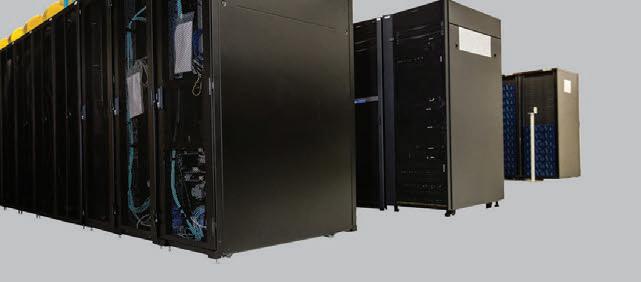

FEBRUARY 2017 |DIPLOMACY & TRADE www.dteurope.com 6 photos by INVITECH, ZSOLT SZIGETVÁRY/MTI, PROLOGIS, SÁNDOR CSUDAI, SHUTTERSTOCK.COM
analysis
NOHONEYMOONNOTEVENA’HONEYDAY’
BY TAMÁS MAGYARICS
The paraphernalia of the inauguration of the 45th President of the United States followed a time-honored ritual. There were bands, music was played, a gun salute welcomed the new president, religious leaders said short prayers, and at 12:00 noon on January 20th, Chief Justice John Roberts read the words of the short oath of office, which were duly repeated by Donald J. Trump. However, a somewhat unwritten tradition was broken right after it when the new President delivered his ’maiden speech.’ Although, information leaked from the Trump-camp had indicated that it would be a ’philosophical’ restatement of the major campaign themes, the speech was everything but philosophical. It was a fierce call to arms for the Trump troops to reclaim the power from the ’self-serving’ politicians (especially in Washington). President Trump did not really tone down his attack on his political opponents, and turned his guns on the members of the political establishment - who were sitting behind him, with three former presidents among them. He painted a dire picture of the ’state of the union’ with rusting and gutted factories, rampant violence, declining living standards, a ‘very sad depletion’ of the military, and the like.
Combative, populist and nationalistic
The President did not waste words on the Republican Party, the U.S. Congress, the federal agencies and organizations within and without the government; it was about him alone: ”I will fight for you,” declared Donald J. Trump referring to the ’people’ all over America. He promised a bright future in contrast to the dark past and present: jobs, better health care, more safety; an America that will be ’great’ again. He again promised to exterminate the Islamic State ’root and branch’ (in fact, he did not use this pre-English Civil War vintage expression), and stated that the U.S. would not try to impose its standards and norms on other peoples, which is a departure from the two previous administrations’ attempts around the world. In short, the speech was combative, populist and nationalistic (even, in the words of Douglas Brinkley, ’jingoistic’). The world best brace itself for a more aggressive and assertive United States, with a businesslike approach to complex international issues. Though the name of Calvin Coolidge or, for that matter, no other historical figures’ was mentioned, one cannot but recall Coolidge’s famous comment on the post-World War I extremely complicated financial situation when he simply said of the British and French debts owed to the U.S.: ”They hired the money, didn’t they?” Another of his memorable dictums was that he wanted to see “more business in government, and less government is business.” More ’business’ in the Trump-administration is represented by people
such as likely cabinet members Rex Tillerson, Wilbur Ross or Steven Mnuchin, not to mention his own son-in-law, Jared Kushner, who is widely regarded to be the éminence grise in the White House. ’Less government’ will most likely be deregulation of areas such as energy production, health care, and even education – the likely Education Secretary Betsy DeVos is an ardent supporter of school choice among other things.
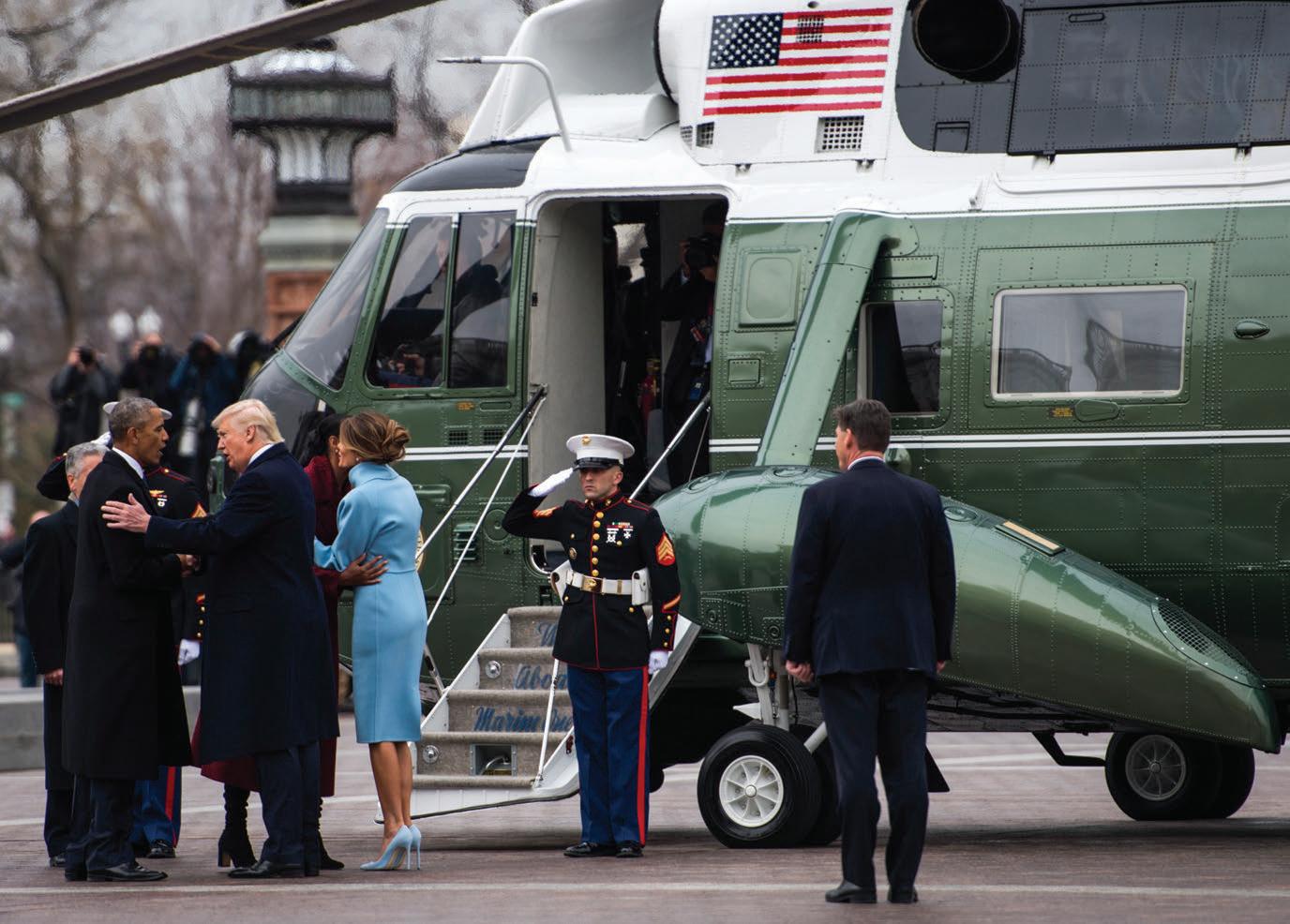
Against the Republican mainstream These programs may be termed mainstream Republican ideas, but President Trump’s foreign and security policy views are running counter to decade-old Republican policies. It is especially the new President’s approach to Russia, and personally to President Vladimir Putin that has sent shivers down the spines of such Republican hard-liners as John McCain and Lindsay Graham. His assessment of the importance of the military allies of the U.S. inside and outside NATO looks very much like that of a bookkeeper’s; in reality, these alliances are much more than merely associations for common military actions. They are pillars of America’s hegemonic position in the world. An American ’go it alone’ posture would be bound to fail in no time. President Trump’s
antipathy towards free trade agreements also runs counter to mainstream Republican trade policies. A trade war with China, or even with Germany and Japan, the three countries which have the highest trade surplus in their trade with the U.S. may as well result in rather nasty consequences for both sides – and for the smaller economies dependent, either directly or indirectly, on the current trade agreements starting with the WTO to such regional agreements such as NAFTA.
More uncertain times
The foreseeable clashes with key Republican constituencies on Capitol Hill and elsewhere can be a cakewalk as compared to the Democrats’ inveterate hatred felt towards Donald J. Trump.
First, the great majority of the Democrats believe that Trump is not a ’legitimate’ President (e.g., Representative John Lewis), which is factually incorrect. Second, they were almost certain that Hillary Clinton would win hands down, and their disappointment and frustration were all the more extreme when it happened otherwise. They declared almost to a man by paraphrasing William Shakespeare that they are ’determined to prove a pest’ to President Trump no matter what issue is at stake. In fact, the noble undertaking
to try to kill each and every initiative coming from the White House is not their copyright. It was Sen. Mitch McConnell, currently the Majority Leader in the Senate, who told everyone with disarming frankness that the Republican Party’s only goal would be to make Barack Obama a one-term President. The Republicans were as good as his words, and their behavior contributed to a large extent to the deadlock in Washington and the unpopularity of politicians in general, which gave rise to Donald J. Trump. What we are likely to see in Trump’s Washington will be an even more bitter partisan fight, and if the Democrats can win either or both of the Houses in the midterm Congressional elections in 2018, then the history of political stalemate of the early 2010s will repeat itself. From our point of view, this scenario may result in a more active President Trump abroad, where he can act more freely from the domestic political shackles (á la Richard Nixon after Watergate), or conversely a more passive one, because his energies will be eaten up by the domestic tug-of-war. Nevertheless, what we can be certain is that we are heading for more uncertain times than the past few years were with ’No drama, Obama.’
www.dteurope.com DIPLOMACY & TRADE| FEBRUARY 2017
7
photo by U.S. AIR FORCE/MARIANIQUE SANTOS
THE START OF THE TRUMP PRESIDENCY
BY SÁNDOR LACZKÓ
“I basically begged my government in The Hague to be sent to Budapest as I had known Hungary before when I was posted in Slovakia, and I have never regretted this request: it is a wonderful place to live, a wonderful place to be,” Ambassador Scheltema tells Diplomacy&Trade. He adds that politically, it has always been a bit challenging for him “because of the position that the Hungarian government takes on a number of issues, particularly within the European Union, that do not necessarily coincide with our position. But I think that is part of our job and that is part of the challenge
that we have as diplomats, that is, to try to bridge the differences in views on issues like migration or the rule of law and transparency.”
Open communication
As regards the objectives he set to himself when taking up this ambassadorial position in Budapest, he points out that “first of all, you should not try to be overambitious because a diplomat’s role is somewhat limited by definition. My ambition here has been to make sure that Hungary gets even more cemented into the European fabric, that family of nations that call themselves together the European Union. If I can contribute to the dialog on this issue, explain to people
what we think about the EU, what we think about the position of Brussels, then, I think I have at least partly achieved my goal. Of course, I’m also here to support the Dutch business environment, Dutch companies, Dutch investors. And, I’m here to support all expression of ‘Dutchness’, including Dutch culture and values.” He stresses that Dutch-Hungarian political relations are basically good. “We had our foreign minister, Bert Koenders here last fall. He was in the Hungarian capital for nearly a day and had the chance to meet with his counterpart, Minister Szijjártó as well as the Speaker of Parliament, László Kövér. They had a very open exchange of views on all the points of the agenda. I think the chemistry between the two ministers worked very well and I believe you can communicate openly only if you have this sort of chemistry between negotiating partners. Nowadays, ministers of EU member states see each other very often in Brussels and it is one of the strengths of the European Union to have these kinds of ministerial meetings, where you have opportunity to discuss all issues with your counterparts on a regular basis.” Dutch voters go to the polls this spring - as do the French and the Germans. It is hard to predict the outcome, but the Ambassador does not think the Dutch elections - or the others - will lead to a rearrangement of the political structures in the European Union. “Power structures in the end are based on economics and it is quite clear where the economic engine of Europe is. I’m not as pessimistic as some other people regarding a radical change of the political structures in the EU. I don’t think, in the Netherlands, people will vote for any substantial shift that would bring the populists into a governing position,” he says.
Economic relations
“If you go back to the early 1990s, you may remember that we were among the first foreign investors to enter the Hungarian market when it was opening up. It was because we realized that you needed transformation and support. We came in with big investments, which, I think, made a strong difference. Just look at Shell, Unilever or Philips, not to speak of the banks and insurance companies. They really made a difference here and they helped to reshape the Hungarian economy from 1990 onwards. They have remained here ever since. When I talk to Dutch companies here I feel that they are really at ease, quite happy with their investments and that explains why we are one of the very biggest investors in this country - according to some statistics, we are No. 2, even ahead of Austria. But then again, I am not a fanatic of statistics”, Ambassador Scheltema highlights.

He adds that he has been saying for the last two years that it is important to keep a very transparent investment climate. “Transparency means predictability in legislation, in taxation; it implies openness in every sense; it means you create a level playing ground for companies. There was criticism about that, of which I hear less nowadays. I think the situation has somewhat stabilized in that respect.”
The Netherlands is also one of Hungary’s biggest trade partners. The Ambassador points out that “you can see growth in bilateral trade but there are a number of things which we can take further. We have top sectors like water management, transport, agriculture, life sciences and health, with a considerable amount of innovation and know-how which can be shared with the Hungarian business sector.”
The Royal Dutch Embassy regularly publishes a business newsletter. “It is a way to focus - for Dutch companies in particular - on issues that we think are important for them. So, if you look at the newsletter, it reports on the Embassy’s activities, the Dutch companies’ success stories and the Hungarian business environment with a special focus on the aforementioned top sectors. So, we are supporting the Dutch businesses and their business environment here - together with The Netherlands-Hungarian Chamber of Commerce, which is smaller than the German or American chamber, but has found a strong niche to serve its members' needs efficiently,” the Ambassador explains.

Due to the UK vote to leave the EU, many international companies are likely to move their headquarters out

FEBRUARY 2017 |DIPLOMACY & TRADE www.dteurope.com 8 photos by DÁVID HARANGOZÓ, SHUTTERSTOCK.COM
EXPRESSING AND PROMOTING ‘DUTCHNESS’ IN HUNGARY
INTERVIEW WITH GAJUS SCHELTEMA DUTCH AMBASSADOR TO HUNGARY
of London - with Amsterdam being one of the logical relocation choices. Ambassador Scheltema believes that “Brexit is a mistake, it is a ‘lose-lose’ case. Personally, I don’t think that we should be rejoicing about the fact that companies may want to leave London and go to Amsterdam or elsewhere. Of course, if companies decide to move - because of the Brexit or not -, then we can provide a good alternative investment environment. It is very difficult to predict at this stage what is going to happen in the coming years.”
Dutch EU Presidency


Most important in Dutch diplomacy in 2016 was the country’s Presidency of the Council of the European Union during the first half of the year. The Ambassador believes it was a successful Presidency, “although, we were also overshadowed by some unfortunate events, like the Brexit vote in the United Kingdom. I would like to recall that, a year ago, we managed to strike the famous deal with Turkey, which effectively stopped the great influx of migration into Europe. Within two weeks, the number of refugees and migrants arriving to our continent was reduced to a trickle, compared to before. I’m still very proud of the fact that luckily, we could actually stop this flow and focus on support to the refugees in the region. The Dutch Presidency for us was also a fun period during which we organized a number of events with which we thought we could highlight some of our social, economic and cultural values.”
One of the main issues carried by the 2016 Dutch EU Presidency was the circular economy with the Dutch Embassy promoting this issue in Hungary. “I think the idea is already rooted here quite well. When I talk to company managers and see the number of companies represented at events which we organize on the circular economy, I am very impressed. I am happy with the quality of the dialog and examples of circular economy emerging in Hungary. We have a very strong view on the circular economy. We really think that we need to change our behavior. Through the two conferences that we helped to organize on this matter last year, we tried to bring the point forward that the circular economy is a necessary game changer. For the sake of future generations,
dutch focus

and maintain a transparent environment. He has also frequently attended forums where this issue was discussed. He stresses that “transparency is an essential element of a dynamic society and neglecting it can back fire on the whole society. In a debate about the functioning of the Brussels bureaucracy, that of the Commission, for instance, it always revolves around the issue of transparency, about who is deciding what. So, I think transparency is a very important element of the functioning of a democratic society and it has a very important influence on decision-making for investors. As I said before, investors want transparency and predictability because that is the environment that they feel safe in, safe enough to invest in a particular economy. If they have the feeling that things are murky or there are crony deals being made, instead of doing things in an open way, it will shy away money - at least, the ‘right kind’ of money. That is why civil organizations that promote transparency like Transparency International are so crucial. Transparency enhances the confidence of the public and the investors as part of good governance.”
Inclusive culture
we have to switch from linear to circular economy to preserve the natural resources that have been given to us by Mother Earth,” he adds.
Transparency
During his term in Budapest, Ambassador Scheltema has often spoken about the need for government and the civil society to join forces in order to create
“I am fond of culture. I’m always happy when we, as an embassy - with our relatively modest means - are able to support culture, especially cultural exchange. By culture, I do not only mean classical culture as ballet, opera, music, literature or theater but also urban development, the role of citizens in building up local projects which have a social-cultural dimension, creative industries, urban planning - so,
it is a very broad area,” the Ambassador explains. “In all modesty, we have been quite successful and quite active in our efforts. I think many people in Hungary have realized that we have created a breeding ground for many different new experiments in this field.
Due to the fact that in the Netherlands, we have a multicultural society, and that we have all kinds of new energies, new ideas, new dynamics coming into our society. All this has enriched society as a whole. So, I’m very proud to present that culture to the Hungarians,” he adds.
Ambassador Scheltema is leaving his post in the summer of this year and “out of my respect for Hungary and the cultural traditions of Budapest, I’m now working on a book, which is simply called ‘Andrássy út’, focusing on that street through atmospheric and artistic photographs. This UNESCO World Heritage site has connected Budapest’s downtown area with Heroes’ Square and the City Park for one and a half centuries now. Its visual experience in the book will be supplemented by interviews with personalities who talk about very diverse aspects of Andrássy út and its Hungarian history.”
During the three and a half years of his posting in Budapest, Gajus Scheltema had many opportunities to travel through Hungary. As an avid birdwatcher, the first place that he mentions as his favorite is the Kiskunság region, with its national parks on the Great Hungarian Plains, south of Budapest. “I like the Alföld plain, the open horizon and I also like the túzok (the great bustard), that impressive bird, of which you have by far the most important population in Central Europe. Hungarians are doing a great job with this treasured heritage as the population is increasing year by year. Nature management is so crucial to preserve the traditional Hungarian landscape”. This January, the Ambassador had the opportunity to take part in an official bird count with local rangers. As for his favorite dish, he mentions the Hungarian pancake ‘palacsinta’ and the very similarly sounding Hungarian fruit brandy ‘pálinka’. “I am also a great admirer of Hungarian wines: the reds from Szekszárd and Villány or the whites from Pannonhalma and the furmint from Tokaj – they are big assets to this country,” he concludes.
9 photos by PIXABAY.COM, SHUTTERSTOCK.COM www.dteurope.com DIPLOMACY & TRADE| FEBRUARY 2017 FACTS COMPARED HUNGARY THE NEDERLANDS AREA 93,028 sq km 41,543 sq km country comparison to the world 110 135 POPULATION 9,874,784 (July 2016 est.) 17,016,967 (July 2016 est.) country comparison to the world 91 67 POPULATION GROWTH RATE -0.24% (2016 est.) 0.4% (2016 est.) country comparison to the world 216 167 BIRTH RATE 9.1 births/1,000 population (2016 est.)10.9 births/1,000 population (2016 est.) country comparison to the world 207 181 LIFE EXPECTANCY AT BIRTH 75.9 years 81.3 years country comparison to the world 92 25 NET MIGRATION RATE 1.3 migrant(s)/1,000 population (2016 est.)1.9 migrant(s)/1,000 population (2016 est.) country comparison to the world 57 50 GDP - PER CAPITA (PPP) $26,200 (2015 est.) $49,200 (2015 est.) country comparison to the world 70 24 UNEMPLOYMENT RATE 6.8% (2015 est.) 6.9% (2015 est.) country comparison to the world 79 82 TELEPHONES - MOBILE/CELLULAR 11.786 million 20.809 million country comparison to the world 76 58 AIRPORTS 41 (2013) 29 (2013) country comparison to the world 104 120 Source: World Factbook
dutch focus
SERVING MEMBERS IN AN INFORMAL ATMOSPHERE
DUTCH-HUNGARIAN CHAMBER CELEBRATES TH ANNIVERSAR
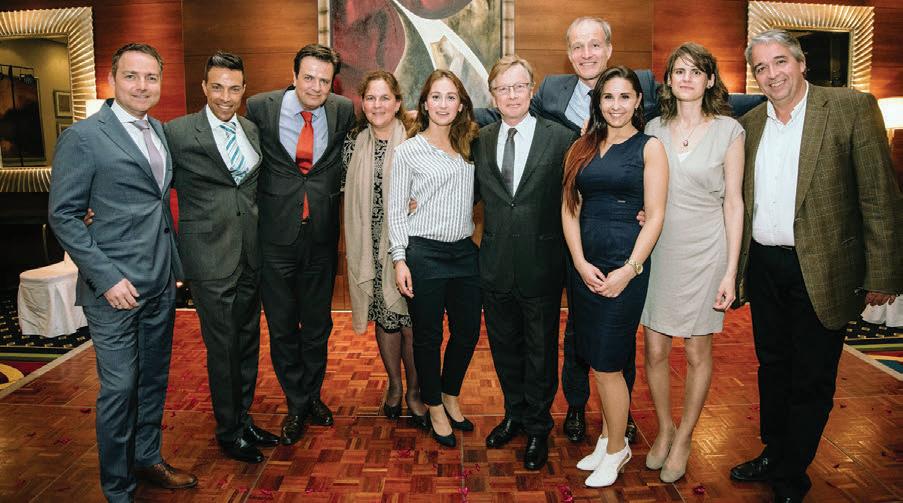
“I believe, that Dutcham has found its place among the bilateral chambers in Hungary in the past years. My goal as the newly elected chairman was to refresh and strengthen what we had been good at before,” Lóránt Kibédi Varga tells Diplomacy&Trade, summing up his first year as elected Chairman of the Netherlands-Hungarian Chamber of Commerce (Dutcham). Founded in 2002, Dutcham is celebrating its 15th anniversary this year. Since the chamber’s inception, Hungary has welcomed a multitude of expats which has changed the corporate climate and the role of Dutcham as an organization. The main role has shifted towards advocating for and facilitating local business. Considering these changes, Dutcham has developed a ‘member-to-member’ approach. This new and innovative facilitation of networking improves the member experience. “We try to do our best and provide several platforms for our members to meet, exchange views and get to know each other better, even on a personal level,” he points out. “In addition, Dutcham has launched a new website and entered the social media scene to keep up with the trends of digitalization. We are still in the learning phase but the incoming feedback suggests that members appreciate these ‘upgrades’ and novelties,” the Chairman adds. Although his name suggests otherwise, Lóránt Kibédi Varga is a Dutch citizen, as well. He is half Dutch and was raised and educated in the Netherlands. He started working there at ABN AMRO Bank and relocated to Hungary in 1994 after the bank opened a branch in Budapest. His Hungarian language knowledge made him a perfect match for the position. Currently, he is the Managing Director of the world leading commercial real estate advisor firm CBRE Hungary.
CSR – building trust
As regards the attractive features of the Netherlands-Hungarian Chamber of Commerce,
he mentions two things: informality and the caring for social causes. “We are not a very formal and hierarchical organization. There is open communication between us and board members can be reached easily,” he says. In the field of social responsibility, he stresses that “Dutcham donates in an unconventional manner. We don’t just check the CSR box but rather follow a particular group of people who are in need of support. We have been developing an incredible co-operative relationship with a school that teaches children with disabilities and orphans in Budapest’s 3rd district for over a decade. We know the teachers and the children and try to understand their daily issues and struggles.
This co-operation is not just about monetary donations, but about trust, and resolving issues through our network of members.”
Membership – ‘Don’t have to be Dutch to keep in touch’
The Netherlands-Hungarian Chamber of Commerce is nearing 100 members, mainly from the manufacturing and service sectors.
Dutcham Executive Beáta Rakos-Szegleti explains that “we are proud to have the largest Dutch companies present in Hungary among our members and there are also companies with international backgrounds, having a Dutch local managers, who would like to belong to the Dutch community in Hungary. In the recent past, we experienced numerous Hungarian companies joining us, mainly due to our open attitude and the vast network we can offer.”
The Chairman stresses that “we are not a large lobby organization. If an industrial sector has a problem to resolve, we join forces with other chambers and voice our position together on the given matter.”
Beáta Rakos-Szegleti points out that Dutcham often acts as an ‘information hub’. “We are working in close cooperation with both the Royal Netherlands Embassy in Budapest and the Hungarian Embassy in The Hague. We often have requests from companies on various matters and we usually facilitate the communication towards our member companies with one of the embassies. For instance, Hungarian companies turn to us in case they have a financial dispute
with a Dutch venture. In such cases, we are able to suggest lawyers who speak Dutch or connect them with the Hungarian Embassy in The Hague that helps to resolve the issue.” Dutcham provides additional professional services by organizing seminars (HR seminars, real estate seminars and tax seminars). “Having numerous companies from different sectors, we have a great amount of know-how, we organize these seminars to exchange knowledge and accommodate others on the given subject,” Lóránt Kibédi Varga highlights. He adds that “at Dutcham, we believe in the quality and not quantity of the contacts. We are not the largest chamber, but we invest the most to improve interactions.” Dutcham also contributes to this information flow by sharing members’ news, press releases, announcements, etc. via its online marketing channels.

Environmental consciousness
The Netherlands-Hungarian Chamber of Commerce supports the activities of the Business Council for Sustainable Development in Hungary (BCSDH). According to the Dutcham Executive, “we help promote their events, we agree with the principles they represent. Environmental consciousness is not only a topic that we support, we also practice it in our office by reducing paper use, changing to e-invoicing as of this year, and using an electric taxi service to go to events.” The plan is to secure the smooth operation of the chamber in the long term by engaging current members and attracting new companies who wish to ‘keep in touch with the Dutch’. photos by DÁVID HARANGOZÓ,
FEBRUARY 2017 |DIPLOMACY & TRADE www.dteurope.com
10
CREARTPHOTO.HU
dutch focus
HEINEKEN: HERITAGE AND INNOVATION
INTERNATIONAL EXPERIENCE BLENDED WITH HUNGARIAN BREWING TRADITIONS
“Our business has always been about heritage and innovation. Heineken is a company with 140 years of heritage through its flagship brand, Heineken, and Sopron brewery (that joined the Heineken group in 2004) is not much younger with its 120 years of history. The company has achieved a lot on this very competitive market burdened by high taxes: the flagship beer of the brewery, Soproni, has become the most popular beer brand of the country; the very first socially responsible beer brand in Hungary, yet brewed of 100% Hungarian barley,” the Managing Director (MD) of Heineken Hungária Breweries Plc., José Matthijsse explains to Diplomacy&Trade. The Sopron Brewery, that has become a reference brewery for Heineken globally, produces and - due to its favorable geographical position - exports Heineken to many European countries including Germany and Austria. But even with this remarkable legacy, she stresses, “the company is still making continuous effort to stay modern and relevant to our times and responds well to the challenges of the fast changing market through innovations that bring enjoyment to consumer’s lives.”
Innovation in the beer market
The Managing Director believes that the best way to keep the heritage is through innovation. “Innovation is in our DNA, we strive to wow consumers with great and exciting products, and also to constantly improve our processes. The Sopron brewery was one of the most modern plants in the country when it was established in 1865. The brewery had electric lights before the city had them. And that is the heritage we are willing to take on. We were the first company to launch radlers, multipacks, new pack types such as the re-closable PET bottle for NaturRadler and also, last year, we were the first big brewer to come up with a beer specialty, the Soproni American Pale Ale (A.P.A.) Most of these innovations were followed by our competitors and brought a revolution to the beer market. As consumer preferences change, we also move into newer solutions.” The company’s efforts last year were recognized with the ‘Heineken Global Sales and Distribution Award’.
Close to the consumers
The presence at various festivals (big and small) is important for Heineken not just in terms of direct sales but also to strengthen of its brands. In fact, Heineken is the biggest partner of Hungarian festivals. The company sponsors and supports 70% of the festivals in the country, which means more than 100 events per year. According to the MD, “besides the big, strategic festivals, such as Volt and Balaton Sound, we try to support startup festivals and local jewels.” She adds that partnership is key in shaping the market, the goal is to provide experiences to visitors, “we work very closely with the organizers to wow our consumers and create unforgettable moments.”
Heineken in Formula One
Last year, Heineken and Formula One Management signed an agreement for the Heineken brand to become a Global Partner of Formula One and the F1 Event Title Partner of Formula One Grands Prix. José Matthijsse says that “in order to further fuel our future growth on global level, we need to engage with new consumers and make the brand meaningful across new geographies.” She adds that Heineken sees F1 as a unique opportunity to reach premium consumers in important new markets. “It delivers in three specific areas: strong commercial opportunities; opportunity to expand our moderate drinking platform, in new and exciting ways; and it enables skills transfer between F1 and our employees, particularly Global Supply. This partnership complements our existing global platforms, enabling us to reach F1’s huge spectator numbers and 400 million unique television viewers every year. “
Connected to this is a campaign (‘When You Drive, Never Drink!’) with Scottish F1 legend, Jackie Stewart. It builds on Heineken’s long standing commitment to use its flagship brand to convey the responsibility message. The company invests 10% of the brand’s global media spending on dedicated responsible consumption campaigns. According to the Managing Director, “central to the partnership will be a clearly articulated and compelling ‘responsibility’ message. The Formula One global platform will provide Heineken with even greater opportunities, globally and locally, to
drive positive change. Consumers are left in no doubt that Heineken and Formula One are both clear: when you drive, never drink!"
Dutch heritage with Hungarian mindset
As José Matthijsse highlights, “the great thing about Heineken as a company is that we are proud of our Dutch heritage as it is still a family company but with a true global footprint. However, we really define our strategy based on local mind-set. It is crucial for us to be an integral part of the communities where we operate, and strengthen each other in every sense: economically, socially, emotionally, all this with the highest respect to the environment.”
Heineken is the only beer industry player to operate two breweries in Hungary (in Sopron and Martf roducing over two illion hectoliters a
year. The company is committed to contributing to these communities financially (mainly through local business tax and donations) and with the employment of people (more than 500 directly and 430 indirectly, through its supply chain). Considering multiplier effects, Heineken Hungária provides livelihood for about 6000 people.
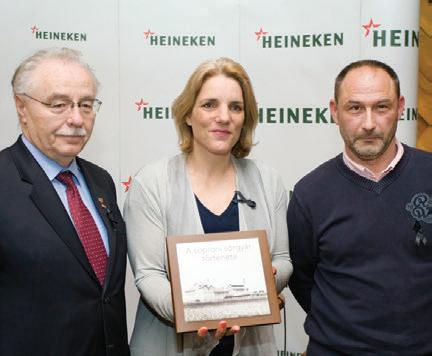
In Sopron, Heineken Hungária is proud to be one of the few breweries in the world certified to brew Heineken. The high-quality Heineken produced in Sopron is exported to six countries including Germany, Austria or the Czech Republic. Hungary’s leading beer brand Soproni is now made of 100% Hungarian barley. The MD says it is a result of technological developments that Heineken accomplished with local malt suppliers. Another product, the Strongbow apple cider uses 80,000 tons of Hungarian apples for cider production, which corresponds to more than 10% of all apple crop in Hungary. “We keep on looking for opportunities to source more and more raw materials and processed products from Hungary,” she adds. Sustainable development is an important element for Heineken Hungária. “Sustainable innovation is our biggest opportunity to ensure a better future for our children. We have substantially reduced water consumption and CO2 emissions, increased the ratio of local suppliers to 86%, supported local communities with more than HUF 250 million in 2015 and reached more than six million people with programs promoting responsible and moderate alcohol consumption.
Cool workplace
José Matthijsse took over at the helm of Heineken Hungária in early 2016. She joined Heineken in the Netherlands in 2000 and worked in a number of areas across three continents in the fields of manufacturing, trade and business management. She arrived to Hungary from Haiti where she worked as the head of the local subsidiary of the company. Prior to that, she was commercial director for Heineken in the Democratic Republic of Congo.
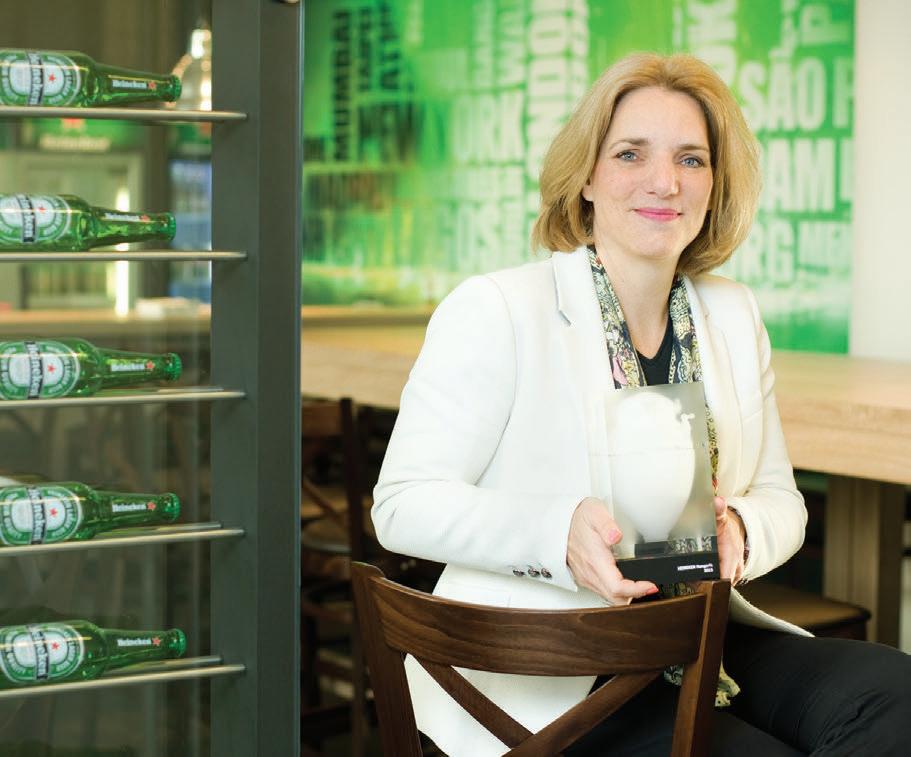
As she puts it, “I have really enjoyed the past ten months here. We have a small but fantastic young team whom I find really cool to work with. I love to show the historical heritage of Budapest to my children.”
She is looking forward to the new year that will bring “exciting new innovations and the further growth of the Soproni brand. We are also going to provide new choices, excitement and experiences to consumers, build more on the premium and radler segments, import some products of the Heineken group where we see potential on the Hungarian market. We are going to develop the beer culture together with the industry and our peers and definitely continue to progress with the Heineken company, making it an even stronger and better employer,” she concludes.
www.dteurope.com DIPLOMACY & TRADE| FEBRUARY 2017 11
photos by DÁVID HARANGOZÓ
▶ Heineken Hungária CEO José Matthijsse presenting the book ‘History of the Sopron Brewery’, with Sopron mayor Tamás Fodor (on the left) and Róbert Horváth whose archive collection served as a base for the book.
dutch focus
INSPIRATION FOR SUSTAINABILITY INITIATIVES
AMSTERDAM’S SCHIPHOL AIRPORT IS ONE OF THE GREENEST IN THE WORLD
As Chicago architect Clare Lyster (July 2013) writes in ‘Places Journal’, a publication on the future of architecture, landscape, and urbanism, the Dutch landscape firm WEST 8 developed and implemented (from 1992) a landscape master plan for Amsterdam’s Schiphol Airport with a strategy both strong and simple: rather than create a conventional park, the firm proposed that the airport plant groves of birch trees –25,000 every season for eight years – between buildings and throughout the open spaces of the complex. According to West 8 Principal Adriaan Geuze, the birch plantation will grow into an unpretentious green counterpart to the buildings, billboards and infrastructure.
Maarten Buijs, a project manager in the firm’s Rotterdam office, has recently confirmed that almost 200,000 trees were planted. He also noted that there are fewer trees today due to maintenance and pruning, and that birch trees were chosen partly for their ornamental quality, partly because their fibrous roots do not interfere with subterranean infrastructure, and also because birds don’t tend to perch on the soft thin branches (like many airfields, Schiphol struggles to manage bird strikes).
As part of a 2008 update to the airport master plan, Buijs described new measures that include planting wildflowers in areas that would previously have been mowed. The landscape of Schiphol – the ‘green counterpart’ to the buildings and infrastructure – underscores the value of providing a strong spatial identity to the airport, of enhancing rather than degrading the macro-environment, and of creating productive and multidimensional complexes that move beyond the utilitarian programs of the conventional airport. Ultimately, airport and airfield sustainability will depend upon deploying this holistic approach as much as upon selecting from a repertoire of green technologies, Clare Lyster concludes.
Going green
In November 2014, Amsterdam Airport Schiphol was recognized internationally for its work on sustainability and innovation. The airport’s corporate responsibility program was awarded the ‘Airports Going Green Award’ in Chicago, IL, in the United States by the Chicago Department of Aviation, which presents annual awards for the efforts made by airports towards sustainable aviation. The Department praised Schiphol for "the incredible sustainability achievements and innovations at Schiphol and in particular the contributions to the aviation industry" and called Schiphol a source of inspiration for sustainability initiatives at airports in the
DUTCH ELECTRIC RAIL FLEET TO BE POWERED EXCLUSIVELY BY RENEWABLES FROM 2017
Netherlands Railways (Nederlandse Spoorwegen - NS) has announced that all of its electric trains use clean energy as of January 1, 2017, one year earlier than the Dutch state-owned train operator originally planned. As electrans.co.uk reports, the renewable electricity used is generated by wind farms. NS is the first rail network in the world to reach such a clean-energy goal. The electric trains carry both passengers and freight. Renewables already provide about half of the electricity used by the network. Around 1.2 TWh of electricity is consumed annually to operate the trains, which is the same amount all households in Amsterdam consume per year. According to brightvibes.com, the energy company Eneco provides NS the energy to transport 600,000 people per day. That’s 1,200,000 train trips per day without any CO2 emissions. The partnership with NS (signed in 2015), allowed Eneco to invest substantially in the expansion of its wind turbine parks. The move is part of a wider push for Dutch commuters to take more sustainable transport options, shifting from ICE cars to EVs, bikes and public transport, which will also be made greener. This is also being backed by co-operation from the Ministry of Infrastructure and Environment and the Dutch employer’s federation (VNO-NCW). In addition, NS has committed to lower its energy consumption by 2% per year.
United States. Schiphol Group is planning for and investing in a sustainable future and is among the world's greenest airports. Earlier in that year, Schiphol Airport received international recognition in the form of an Airport Carbon Accreditation for its efforts to save the climate. Schiphol has a comprehensive program for reducing CO 2 emissions and also uses emission rights to compensate for emissions. Schiphol's Airport Carbon Accreditation (3+) is the highest possible. (To qualify for this level of accreditation, an airport must have analyzed all its emissions, drawn up effective reduction programs and implemented them successfully, and compensated
for any remaining emissions.)
The airport's efforts have earned it a place among the world's greenest airports. Examples of environmentally friendly measures taken by Schiphol include the use of biodiesel, reducing commuting by employees by encouraging work from home, and promoting electric transport.
In order to conserve energy, the terminal and car parks have been fitted with LED lighting. Schiphol is conducting tests with LED lighting on the apron where the aircraft are parked. These tests include the smart operation of this LED lighting, with the lights only switching on when needed. Schiphol uses 100% recycled asphalt on the airport's roads.
Electric taxis and buses

In a bid to reduce its carbon footprint, Amsterdam’s main airport has enlisted the aid of 167 Tesla Model S taxi cabs. The cutting edge taxis play just a small part in making the Schiphol airport one of the greenest in the world. The taxi service is operated by three competing companies, all of which will use the Model S. Numerous government incentives bring the price of the Model S down, so, the incentives are there, as is Tesla’s European assembly plant. Schiphol airport also uses electric buses to ferry passengers to and from aircraft. 35 electric buses started operating in June 2015, each of which has its own charging point at the airport, making Schiphol the biggest charging station for electric buses in Europe. The buses were designed especially for and in collaboration with the airport. The buses have a smaller battery tailored for the required action radius at Schiphol, allowing for spacious seating and additional baggage space. This, together with a design focusing on materials, colors, seats, poles and wrist straps has resulted in a chic look and generous traveler comfort – all this at the world’s oldest (established in 1916) international airport, which is also one of the greenest!

M CO EMISSION E UC ION WITH BIOFUEL
KLM announced last October that all its flights originating in Los Angeles will be using sustainable biofuel for the next three years. The biofuel is being produced from used cooking oil by AltAir, a local biofuel refinery, and delivered by SkyNRG. The airliner’s statement stresses that Los Angeles is the second airport in the world to include biofuel in its regular fuelling processes. Early in 2016, Gardermoen in the Norwegian capital Oslo was the first and KLM purchased biofuel there for a series of 80 flights.
The biofuel, delivered directly to storage tanks at Los Angeles airport, is mixed with the conventional kerosene supply before loaded into aircraft tanks. This helps reduce carbon dioxide emissions for all flights (including those by KLM) taking off from Los Angeles. Flying on biofuel will c ntri ute t aim t reduce emi i n by 20% per passenger in 2020 compared to 2011.
As a pioneer in the use of sustainable biofuel, KLM may rightly refer to itself as ‘Best in Class’ in fuel efficiency. In 2011, KLM was the world’s first airline to operate a commercial flight using biofuel. Since that first flight to Paris, it has used biofuel on a variety of flights and a variety of aircraft types.
Sustainable biofuel is twice as expensive as traditional jet fuel, however, thanks to companies participating in KLM’s Corporate BioFuel Program, it is possible to stimulate the constant production of biofuel. With help of these corporate partners, it is possible to bridge the price difference between biofuel and traditional jet fuel. KLM uses their financial assistance solely to purchase biofuel.
12
photos by HERMAN WOUTERS
FEBRUARY 2017 |DIPLOMACY & TRADE www.dteurope.com
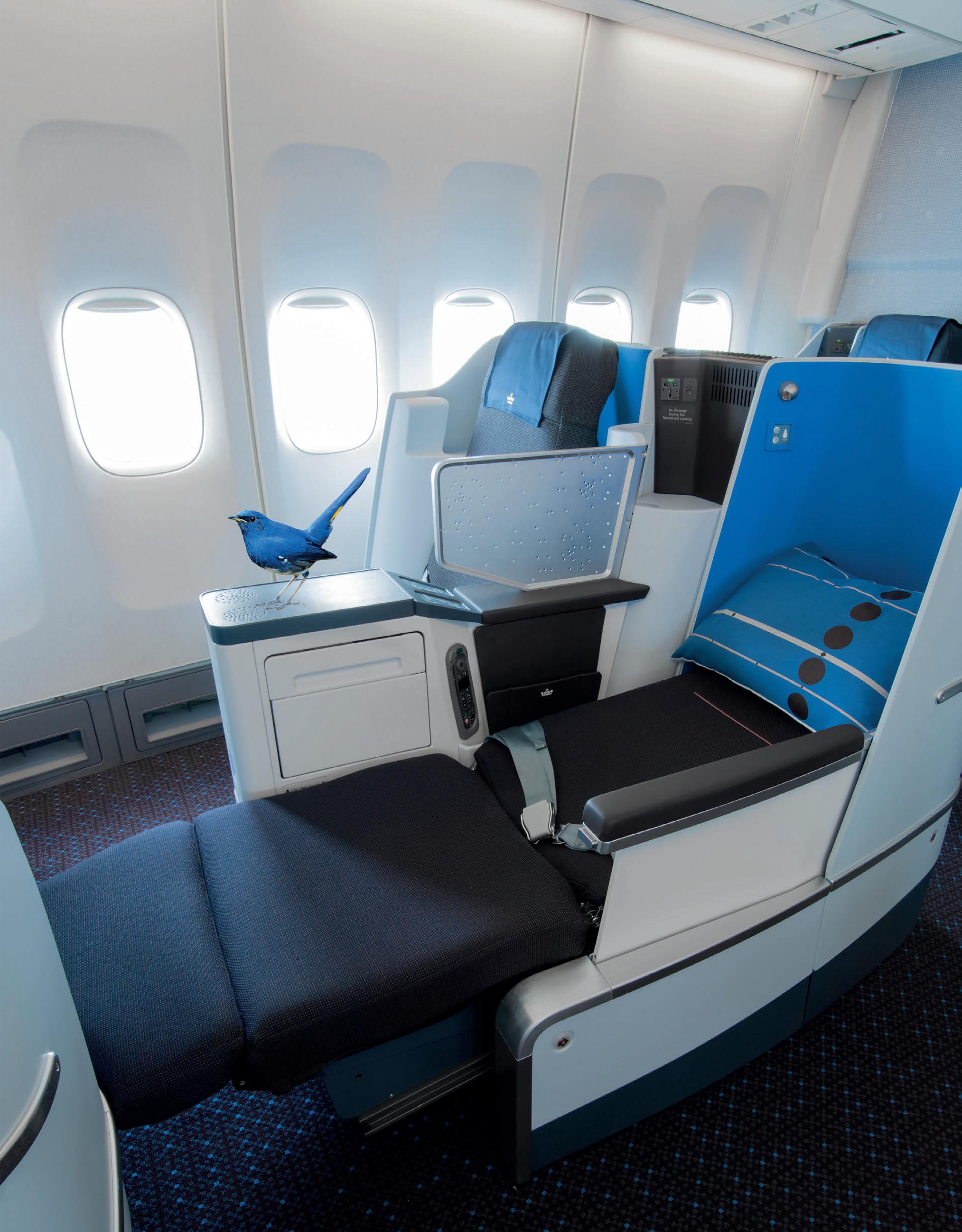
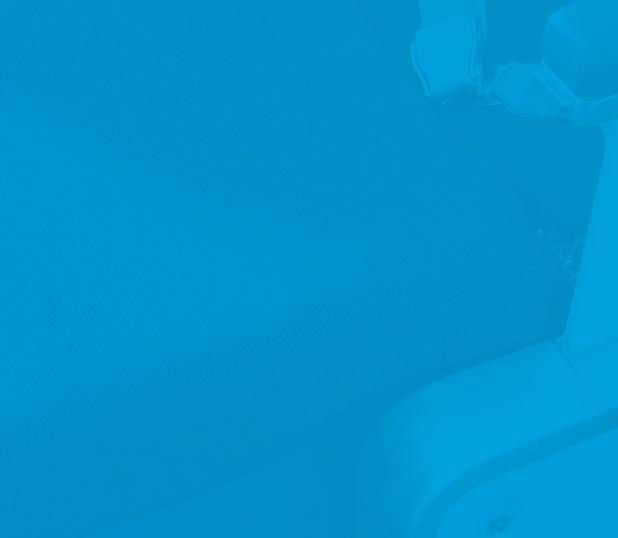



Unique comfort on Early Bird prices! Relax and enjoy your private space. Book early *, sit back and feel at home in our World Business Class. *Book 45-90 days prior to the departure For more information, please check our website - klm.hu Royal Dutch Airlines
dutch focus
PUNCTUAL AND SUSTAINABLE FLIGHTS
KLM CONNECTS BUDAPEST TO THE WORLD THROUGH AMSTERDAM
KLM Royal Dutch Airlines has been recognized as the most on-time airliner in Europe and it is known for its environmental policies. Diplomacy&Trade talked about the airline’s recent achievements with Air France KLM Country Manager for Hungary, Ildikó Kiss.
DIPLOMACY&TRADE According to the latest data, KLM carried 30.4 million passengers in 2016. To what do you attribute this new record?
ILDIKÓ KISS This new record means an increase of 6.4% compared to 2015. Our greatest increase was on European routes where we carried more than 20 million passengers for the first time. Also, our load factor rose slightly by 0.8 of a percentage point compared to 2015. Our customers appreciate our efforts and we are very thankful for that. We are constantly improving our products and services and expanding our network to make our customer’s travel more comfortable and easy.
DIPLOMACY&TRADE The 2016 Punctuality Report concluded that KLM had the best on-time performance among European airlines. What do you do to be so punctual?
ILDIKÓ KISS All our employees at KLM work very hard to make that happen, everyone is committed to make sure we deliver the best on-time performance to our customers. We have a lot of connecting passengers, some with very tight schedules, therefore, it is important to run such a reliable operation.
DIPLOMACY&TRADE It was about 14 months ago (in November 2015) that KLM welcomed its first Boeing Dreamliner aircraft. How has this improved your passengers’ experience?
ILDIKÓ KISS Currently, we have eight Dreamliner aircraft in operation. The Boeing 787 is one of the most advanced airplanes of its time, offering top-level quality and comfort by default. We added some extra improvements on top of the already amazing features of the aircraft, which allow passengers to be more relaxed and fit when they arrive at their destination. The 787 Dreamliner offers a quieter, more fuel-efficient and more sustainable experience. The World Business Class cabin features a 1-2-1 seat configuration, allowing each passenger direct aisle access. The Boeing 787 Dreamliner has 30 World Business Class seats and 264 Economy seats.
DIPLOMACY&TRADE KLM is known for its energy-saving and environmental measures. Please, tell us about your achievement in this field.
ILDIKÓ KISS In recent years, KLMtogether with Air France - has shown that it is taking a leading role in putting sustainable development on the agenda in the airline industry. For the 12th consecutive time, the Dow Jones Sustainability Index (DJSI) has listed the company, together with Air France, as the world’s most sustainable airline.

The airline industry is facing enormous challenges in terms of further enhancing sustainability in the future. KLM is seeking to strike the right balance between an efficient and qualitatively superior product for our customers and assuming responsibility for the environment in which we operate. Apart from investing in fuel-efficient aircraft and weight reductions on board, KLM is a pioneer in the use of sustainable biofuel. Sustainable biofuel is currently one of the most effective ways to reduce CO2 emissions in the airline industry. We are aiming to achieve a 20% reduction in CO2 emissions by 2020.
DIPLOMACY&TRADE KLM’s vision includes “pioneering new destinations.” What are the latest of these visions?
ILDIKÓ KISS KLM has always been a pioneer. Owing to our small domestic market, we have always looked across our borders and planned ahead. The main goal of our company is to offer our customers more direct flights from Amsterdam to destinations of their choice. In 2017, we will expand our network to 8 new European destinations: London City, Gdansk, Graz, Porto, Malaga, Split, Cagliari and Catania. KLM will then serve a total of 82 European destinations.
DIPLOMACY&TRADE Amsterdam-Schiphol is an excellent hub. How does KLM utilize this home base to connect different cities and continents?
ILDIKÓ KISS Schiphol airport has been KLM’s home base since the airline’s inception in 1919. Over more than nine decades since then, KLM has grown into an airline of global proportions. Despite its small domestic market, the airport services over 60 million passengers a year. Schiphol has grown into an international hub of flight connections, where 70% of KLM’s passengers transfer en route to their final destination. Schiphol is an entity comprising businesses and activities that mutually reinforce each other. This makes the airport, together with the region, an international hub for flows of people, goods, money, information and culture. Therefore, the activities that take place at Schiphol are an important driving force for the Dutch economy and for employment.
DIPLOMACY&TRADE What opportunities does KLM offer passengers travelling through the Schiphol hub?
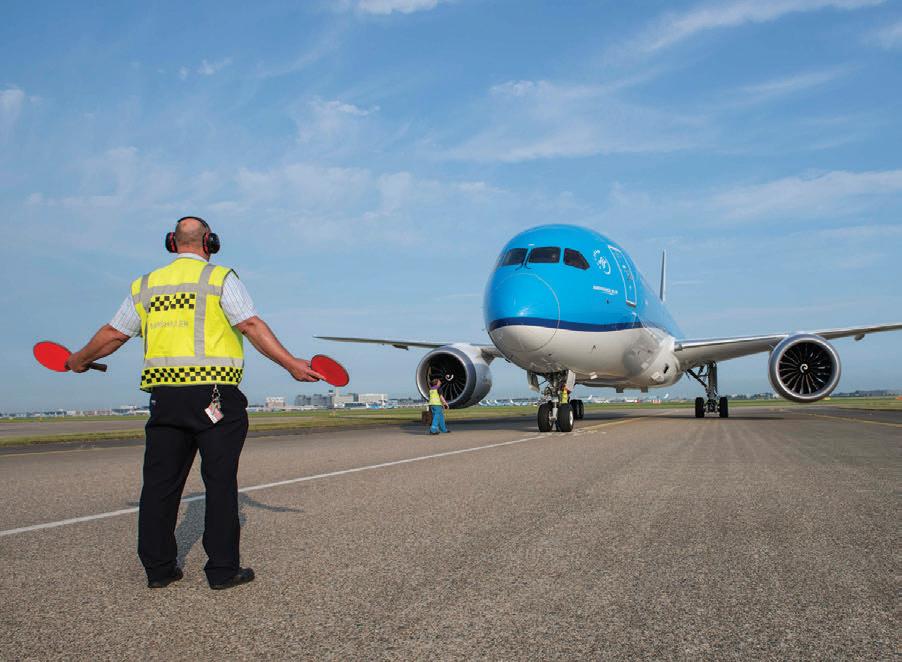
ILDIKÓ KISS At Amsterdam Airport Schiphol, it is extremely easy to transfer to KLM and other SkyTeam flights, and KLM’s innovative services make the transfer more convenient: for example, you can view your flight details and print out your boarding pass on a self-service transfer machine, or you can also download the KLM app before departure, which displays the route and walking time to the next gate. Besides its functionality, Amsterdam Airport Schiphol has a great atmosphere - the leading,
highly efficient airport that provides the full range of services required by visitors, 24 hours a day, seven days a week. Schiphol has always retained the one-terminal concept, making it a compact, passenger-friendly airport where it is easy to find your way around.
The Airport regularly wins prestigious prizes, such as best airport in Europe, and even the world.
DIPLOMACY&TRADE
You have recently introduced a new business class and new services! What is the feedback from travelers about these?
ILDIKÓ KISS Our travelers are highly impressed with our new World Business Class product. Almost all aircraft types at KLM are fitted with new cabin interiors. Designed by a famous Dutch designer, it makes our passengers truly feel at home on board with us. They appreciate being given priority at check-in, baggage drop-off, security checks, customs, boarding and baggage pickup. Thanks to the convenient timetable and the new, super comfortable full-flat seats, which recline 180 degrees and are 207 cm (81.5 inch) long, our customers can arrive at their destination well-rested, which is crucial for business travelers. We also get very positive feedback about our crew who always ensure special attention and deliver personalized service at every moment of the travel. Our Business Class travelers are delighted to have a delicious three-course menu prepared specially by top Dutch chefs. All meals are served on Marcel Wanders crockery and accompanied with a glass of fine wine or other beverage of your choice.
DIPLOMACY&TRADE SMEs are an important segment for KLM. What specific program do you have for such passengers?
ILDIKÓ KISS BlueBiz is the corporate benefits program from Air France, KLM and Delta Air Lines, which enables small and medium enterprises to earn additional savings on their travel budget. Once you sign up for free, your company can start earning Blue Credits on flights with Air France, KLM, Delta Air Lines and our partner airlines. With BlueBiz, employees earn Blue Credits (1 Blue Credit = EUR 1) for their company on every trip. Blue Credits can be used towards air tickets and more, making the most of a company´s travel budget. BlueBiz is not only a great choice for the company, but employees also benefit from the program: employees of the company who are members of the Flying Blue program or our airline partners’ Frequent Flyer Programs also earn miles on their personal accounts.
by
FEBRUARY 2017 |DIPLOMACY & TRADE www.dteurope.com
14
photos
KLM
dutch focus
PRUDENT AND RESPONSIBLE BANKING
ING Bank has been recognized by the magazine World Finance with the ‘Best Commercial Banking Hungary 2016” Award. Diplomacy&Trade talked to Tibor Bodor, the newly appointed Country Manager of ING Wholesale Banking Hungary, a member of ING Group, which is of Dutch origin and belongs to the top 20 financial institutions in Europe. He points out that “established in September 1991 and started as one of the first 100% foreign-owned banks in Hungary, we have recently been celebrating our 25th anniversary in this country. With regard to several products and services, ING Wholesale Banking in Hungary has achieved a leading position in the field of corporate and investment banking in its niche market. It is a market leader in foreign exchange transactions, and has outstanding results trading in government securities.”
As a branch, ING Wholesale Banking Hungary has access to major ING knowledge centers worldwide and operates as an integral part of a global network. According to the Country Manager, “in Hungary, we have clear and pure wholesale banking portfolio.”

Inside Business
He adds that recently, they have introduced a new service called ‘Inside Business’. “This is based on our omni-channel strategy that will allow our corporate clients to bank with us across countries through a single point, having access to the services and products they need, wherever they are in the world, via safe apps. This is a technology-driven sector and we have to comply with the needs of our customers. I can build on our strengths that include a well-known, strong brand with positive recognition from customers in many countries, our strong financial position, an omni-channel distribution strategy and an international network. In addition, I would like to join our sister companies in other countries by leveraging on digitalization of our services and internal procedures. We will continue to streamline these procedures and channels to make daily banking easier and faster for our clients.”
Corporate services
More than 90% of ING Wholesale Banking
Hungary’s corporate clients derive from the global network of ING Group, and the same look and feel is provided for ING’s international clients as in every other country globally.
“We offer banking services to the top 500 corporates in Hungary. Product-wise, we offer cross-border cash management, international cash pooling and global trade finance services are also available in Hungary. Being a network location for ING and adding value to ING’s global Transaction Services, ING Wholesale Banking has one of the strongest European presence of all international banks in 28 countries, including Hungary. It is strong in local products and support as well as international solutions, and so it is in a front-runner position in Benelux and CEE. ING offers the ability to deliver cross-border solutions
on the backbone of ING’s wide international network, along with senior support to further develop and strengthen the transaction and lending services franchise,” Tibor Bodor highlights.
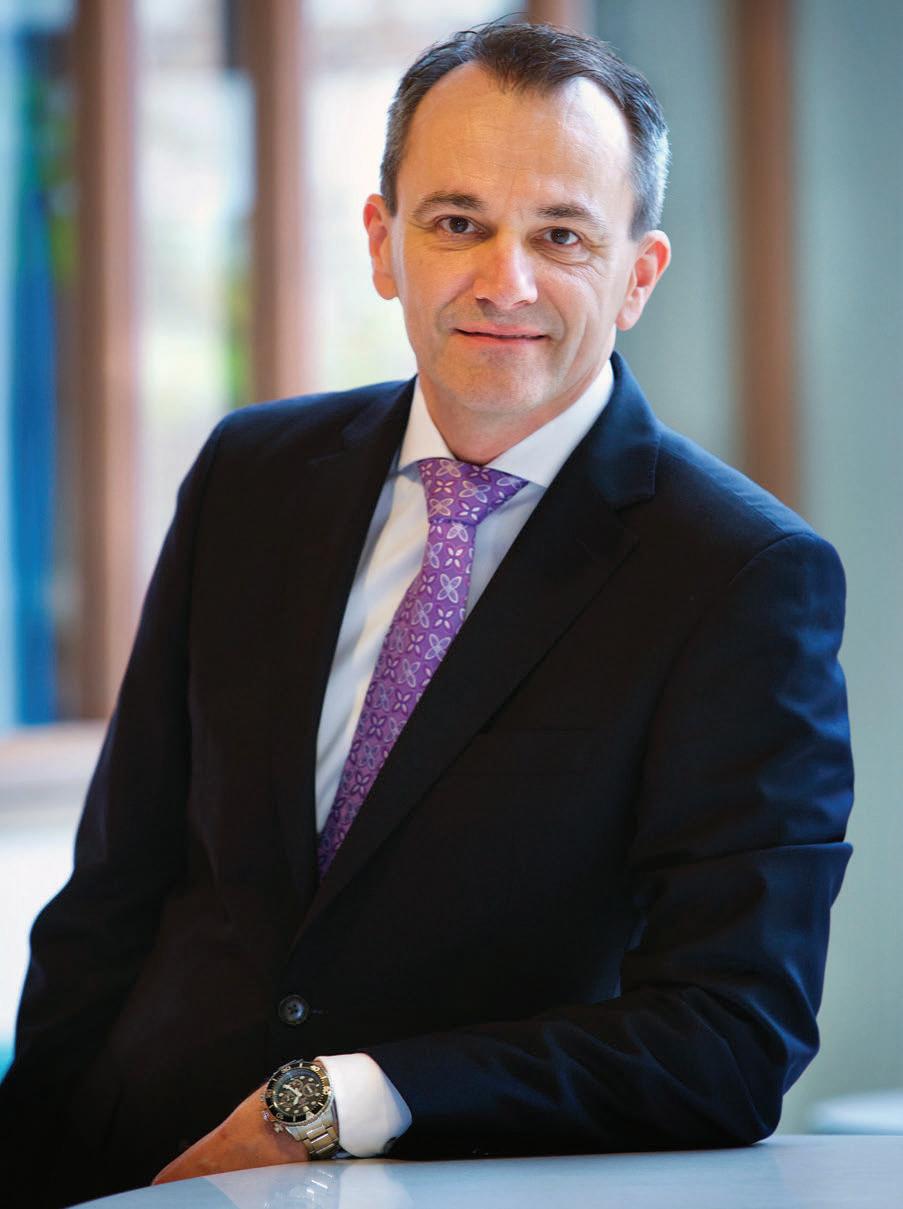
As for the Dutch business values they apply, the Country Manager points out that the banking business centers around people and trust.
“The values we follow therefore are clear: our core value is integrity, and that is above all values. We are honest, we are prudent and we are responsible. These are the values around which the business of ING Wholesale Banking in Hungary is also built, and this is what we require from all of our staff as well.”
Sustainability highlighted
Ranked by Corporate Knights, the world’s largest magazine focused on sustainability and responsible business, ING features fifth on the
2017 list of the world’s 100 most sustainable corporations in a report ranking over 4,000 companies on 14 key performance indicators (KPIs) covering financial, employee and resource management, and supplier performance. It considers companies all around the world and in every sector. Priority KPIs for the banking sector included energy, greenhouse gas, water, waste, employee turnover and the ratio CEO/employee pay. Other Dutch companies in the top 10 included Philips and DSM. Tibor Bodor stresses that ING has developed stance in animal welfare, climate, defense, energy, extractive industry, fisheries, food speculation, human rights, income taxes, maritime sector, palm oil, resource scarcity, transparency and issues annually a detailed report on sustainability. Also, ING is one of 52 firms recognized in the 2017 Bloomberg Financial
Services Gender-Equality Index (BFGEI). This index, announced in London a few days ago, measures gender statistics, employee policies, gender-conscious product offerings as well as community support and engagement.
“In Hungary, we have started the sustainability transition in our own operations, i.e. we have drastically decreased office paper used during the last years (benchmarking it to our Head Office), not only by e.g. changing the default printing process on the printer machines, but also by reengineering, re-designing our internal processes. We can now say that we are a paperless office. We are renting our office space, however, we have managed to agree with the landlord on various modifications in the office that have led us to work in a Green Building. We know that knowledge and business go hand in hand. ING has tremendous knowledge, just let me give you one example: the ING Water Report. Water is life, and this report provides country based (also for Hungary) analyses on e.g. water usage, water intensity, water stress and is available for everyone interested in this matter,” he says. ING is a major player in sustainable finance, and in supporting sustainable transitions regarding its corporate clients. Thus, ING believes that businesses should, and can go through a transition to be more sustainable, and that this is a process that has to be started. “Customer relations, projects are all evaluated on their social-environmental risk: our financing and investment policies, as well as our broader business ambitions, are structured around strongly embedded social, ethical and environmental criteria (ESR). An extensive ESR policy framework is there to guide ING’s decisions regarding client engagement and assessing finance proposals. The ESR policies are applicable to all of our products and services, including corporate loans, project finance, investments for own account (e.g. bonds issuance), and asset management/private banking services. Each policy defines risk management procedures for its specific operational area. All ING Bank entities, therefore ING Wholesale Banking in Hungary also are under this control and are to uphold these,” the Country Manager explains. As regards future plans, Tibor Bodor expects business and regulations to be more predictable in the future, ensuring a steady business flow.
“I have witnessed some positive changes in the banking sector in the recent quarters, however, amidst a low volume and low yield environment, the structural profitability of the banking sector will be under pressure. The main challenge is to remain competitive and costefficient. Generally speaking, economic activity could strengthen in 2017 due to domestic factors, such as investments and consumption. In my opinion, the biggest challenge for Hungarian business has been the recently started structural change from a cheap labor force driven economy to a more efficient, more capital based, digitalized economy.”
www.dteurope.com DIPLOMACY & TRADE| FEBRUARY 2017 15
photos by ING, MARK VAN DEN BRINK
ING WHOLESALE BANKING HUNGARY LEADER IN CORPORATE AND INVESTMENT BANKING
dutch focus
A CLIMATE-NEUTRAL, PEACEFUL RESORT
IROTA ECOLODGE SUITABLE FOR FAMILY HOLIDAYS AND BUSINESS PURPOSES

Ten years ago, two Dutchmen, Jeroen van Drunen and Lennard de Klerk, moved to Hungary and came up with the idea of creating a luxurious, eco-friendly holiday resort here.



Back in 1993, Jeroen spent half a year in Hungary studying and he “absolutely fell in love with the country and Budapest and I always vowed I would be back one day. Later, I spent ten years in the Dutch diplomatic service. Meanwhile, my partner, Lennard, who had a business trading CO2 emission quotas. We ended up in Budapest in 2007. I was working on my PhD and, in the meantime, met an old friend of mine, an American guy who happened to have a holiday home in the village of Szalonna, close to the Slovak border up in the northeast. He was renovating that place, we offered our help and that was the reason we first went to that area, to enjoying our time there almost every week-end during the summer,” he explains to Diplomacy&Trade. He adds that they had already been thinking of setting up a business in rural tourism, featuring luxury and eco-friendliness with the big question always being ‘when’ and ‘where’.
Eco-business in rural tourism
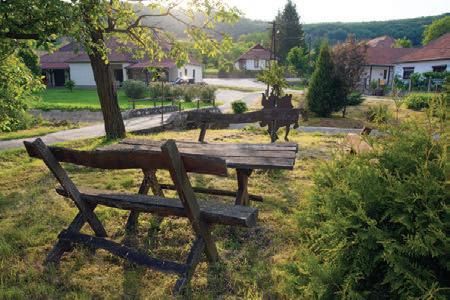
Lennard de Klerk says that with the ‘where’ largely decided as they liked the landscape where they helped their friend, they were looking for a mansion that they could renovate and make it into the home they were dreaming about. “We found one that had been empty for two decades in Irota, a dead-end village of less than a hundred inhabitants situated in a valley. It took us 2-3 years to renovate it. As I was in the environment business, it was very interesting for me to put ecology into practice, applying new technologies.” After they finished the renovation of the mansion, they continued with the construction of the resort. The walls of the ecolodge resort’s three separate villas (each reflecting a different style) are made of wooden-frames in which cellulose, made of used newspaper, has been blown as insulation material. On the outside, wooden soft board plates have been used to increase thermal insulation. “We installed a large stove in the central room, fed with locally grown firewood, to provide heating, which is sufficient due to the insulation we have used including the triple glazing and in general, we applied much of the experience gained when we renovated the mansion.” In the ecolodge, rainwater is collected to be used to flush the toilets, to wash the laundry and fill the
swimming pool, which means 50-60% savings on water consumption. Water is heated by solar collectors while the electricity provided by solar panels is more than enough, so, the surplus is fed to the grid of the electricity company. Jeroen stresses that no chemicals are used in the swimming pool as it has a separate reservoir in which reed cleans the water. Also, each villa is equipped with a biological wastewater treatment unit that uses bacteria to clean the water before it is re-introduced to nature, which is important as the village – like most of them in the area – does not have its own sewage system.
Local attractions
The Dutchmen also contribute to the local community by “employing two ladies who help us in cleaning the villas and two gentlemen who do the upkeep of the swimming pool and help us with small repairs,” Jeroen says. While Irota, itself provides the peaceful setting guests come for (the place is on a national hiking path and the ecolodge owners provide mountain bikes for free), Lennard explains that the recently renovated palace that can be visited in nearby Edelény, Aggtelek (with its famous Karst caves) is a UNESCO World Heritage Center and the world-renowned wine region, Tokaj are not far away, either. “We have an arrangement with a sommelier to give a guided tour in local wineries (including wine tasting) to those interested but if requested, he can also bring the wines to Irota.” Another local feature is the wide array of bird species awaiting bird watchers from Hungary and abroad. The resort is suitable for corporate purposes, as well. “The houses (each providing accommodation for up to six people) are technically wellequipped. In case of a team-building trip, the one in the middle can be used for meeting with the other two for sleeping. The place is self-catering
(with outdoor kitchen including the overall favorite Hungarian cast iron goulash kettle ‘bogrács’), but we also have a lady in the village who is a very good cook, so, she can prepare traditional meals on request,” Lennard adds. Construction of the premises was finished last year. As to what sort of feedback they have from guests, so far, Jeroen proudly says that “everyone has left the place happy. We have had very good reviews on travel websites, as well. People especially like the fact that they can have luxury in a remote place where they would never expect it. Funnily enough, we mainly expected foreign visitors but 90% of them have been Hungarians. Basically, from the moment we opened to the end of the season, we were fully booked.”

He adds that “for longer periods, I would expect more people from Western Europe, especially those looking for the unspoiled countryside. It would also be very interesting for expats in Budapest who are looking for a place to stay far from the hustle and bustle sites where people usually go to.”
Look around the Ecolodge For more info, see: www.irotaecolodge.com
FEBRUARY 2017 |DIPLOMACY & TRADE www.dteurope.com
16
photos by EVELINE EIJKHOUT, MARIËTTE HARMS, LENNARD DE KLERK
dutch focus
ANCHORED IN BUDAPEST, FOR A WHILE
RICK ENDERS IS MORE CONCERNED ABOUT THE HUMAN FACTOR THAN THE TIDES
A few years ago, an interesting theater production was staged by a DutchHungarian company of three actors, who fiddled with the fictitious idea of what would happen if a tsunami overwhelmed Holland and the six million Dutch living in the danger zone were all evacuated to Hungary. I thought I should ask a native Dutch to give his opinion on the matter – someone, who has been living in Budapest for a while, and might feel like elaborating on such a topic. My choice fell on Rick Enders, GM of Budapest Marriott Hotel & Millennium Court, Marriott Executive Apartments, who agreed that indeed, safety against floods is one of the main issues in The Netherlands, where half of the country’s population lives below sea level.
“Holland has been fighting back water for more than a thousand years when farmers first built dikes to protect their land from devastating coastal floods. Water and its logistics and the development of flood management technologies are the main sectors for which the Netherlands is world-known. The Dutch are proactive and amongst them, are the best construction engineers in the world. I’ve read that not long ago, Dutch scientists created the world’s biggest human-made wave generator,” says Enders, who himself was born at -1 asl (above sea level), in a tiny village on the coastline in Abbenbroek, some 20 km from Rotterdam, to a very international family, with Belgian, French and German blood in their veins. “My grandfather was an English teacher, who worked in Indonesia at the time when it took six weeks to get there by boat,” Enders reveals, adding that he believes all Dutch are quite adventurous and, as a nation, like to travel. “In fact, did you know that the origin of the word ‘cruise’ is the Dutch verb ‘kruisen’, which means “to cross” or to “sail to and from”? We are one of the leading seafaring nations so it’s no wonder that so many English words relating to the sea or sailing, such as sloop, deck, pump, bow, skipper and yacht, have their origins in the Lowlands.” Enders says he was no more than 12 years old, when he already knew he was going to travel the world. “At the time of course, I did not know or care how. I knew one thing though: that I would need a lot of money to succeed,” he laughs, pointing out that when he made up his mind to knock on the door of a local restaurant to work for some extra pocket money, that was the first milestone in his career. “I was cleaning potatoes with a mission,” he laughs. Later on, at a pancake house, still at his teens, Enders was asked to replace the chef on the weekends to cook pancakes. Only then, he realized that the restaurant business is actually cool and he chose to pursue a career in the hospitality industry. “Finishing my studies, I started my ‘adult career’ as a chef, back on October 14, 1988, at the Marriott Bethesda in Maryland, and after 18 months I moved to the Grosvenor Square
property in London. I stayed in the kitchens of Marriott hotels in Frankfurt and Bremen, where I had my first executive position as Sous Chef and then catering manager. Then came Dubai. Three days after I arrived and started working as Director of Restaurants in January 1997, I was asked to team up with the chef of the hotel’s renowned JW Steakhouse – which really was the best in the UAE, it was full every night. A gastro-competition was coming up the next month, the Salon Culinaire competition. The challenge was to create and serve a three course meal from a surprise basket of meat (it was lamb) and whatever ‘surprises’ we found
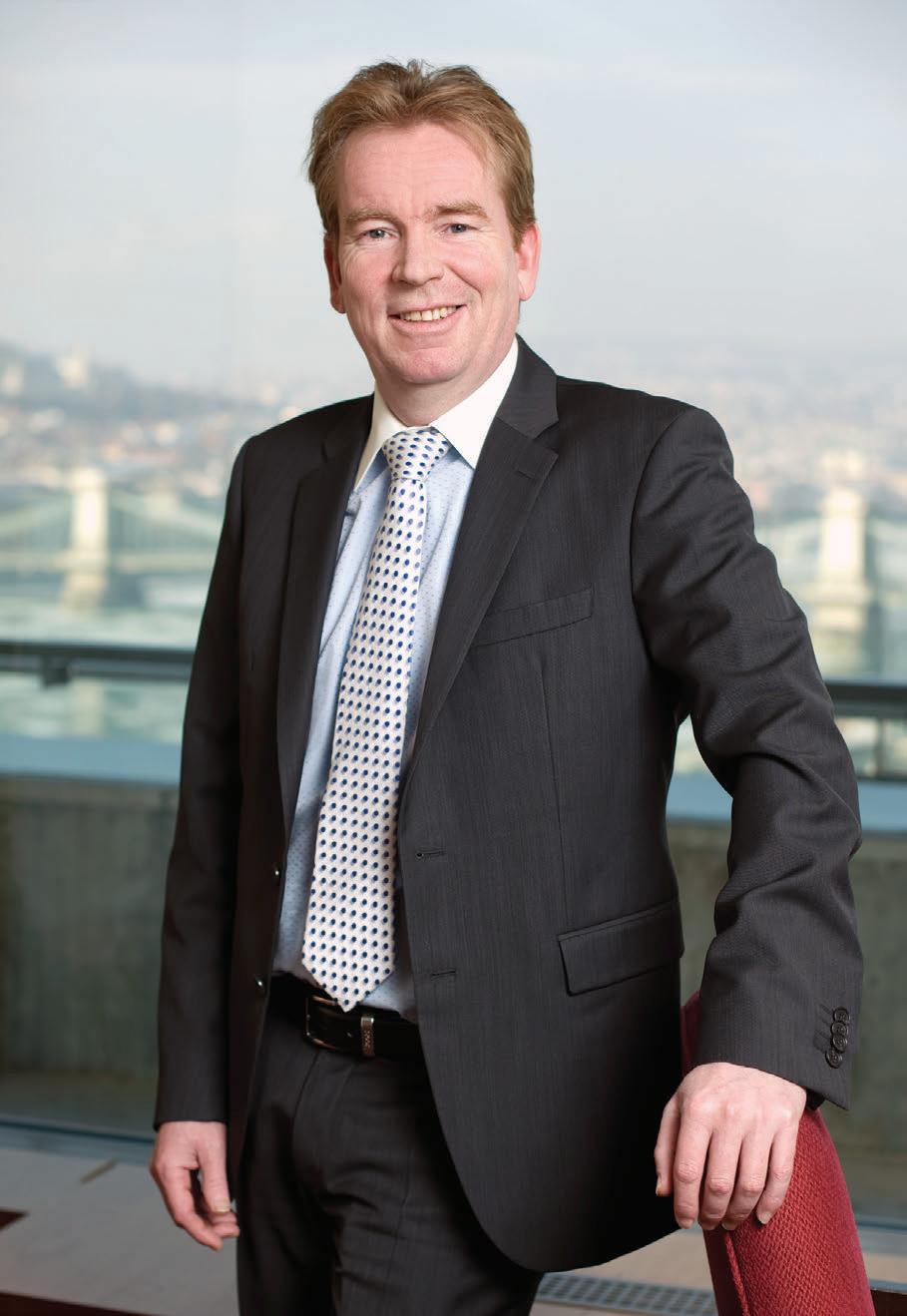
in the fridge. We won the Silver Medal,” Enders recalls. While at the Dubai Marriott, he managed to open eight new F&B outlets, bringing the hotel’s total to 14. “It was big. And, also, there I was, finally, traveling the world.” Still, when asked what career, other than this, would he love to pursue, his answer comes promptly: professional sailor. This might be some of the old Dutch vibe I’m looking to find in his character. As for stereotypes, Enders notes that along with most of his countrymen, he has the capability to adjust quite easily. “I left the Netherlands in 1988, and I have been traveling ever since, from the US to England, Germany, UAE, Egypt, China,
Switzerland, Poland, the Czech Republic and Hungary. But I never felt as an outsider, as a foreigner-foreigner, if you know what I mean. In Budapest, from the moment I arrived in March 2014, I have felt utterly comfortable – despite I don’t speak the language.”
Similarities and differences
Enders says he has noticed certain similarities between Hungary and Holland, or rather between the two cities of Budapest and Rotterdam, and its citizens. “Obviously not the maritime heritage (If you take size and tonnage into account, the port of Rotterdam is secondto-largest in the World, after Shanghai.), but the lively cultural and student life and world-famous architecture are something that these two cities have in common. Recently, Rotterdam was ranked eighth in The Rough Guide ‘Top 10 Cities to Visit’ and fifth in Lonely Planet's ‘Best in Travel 2016’ and was voted 2015 European City of the Year by the Academy of Urbanism. I know that Budapest too, is listed as one of the best cities in the world to visit by Condé Nast Traveler and other leading tourism portals, for the past few years. Rotterdam has earned the nickname ‘Gateway to Europe’, while Budapest is often referred to as the hub of the CEE region, thanks to its strategic location in the heart of Europe. Dutch and Hungarians love their soups, in every form and taste. We have our beloved green pea soup, the Erwtensoep, while Hungarians cherish their Goulash, and both nations often eat these as main courses,” Enders continues, adding he, on the other hand, is missing the unprecedented multicultural vibe of Rotterdam that hosts inhabitants of over 160 different nationalities and features a Moroccan mayor, Ahmed Aboutaleb. According to him, the Dutch really are open-minded and believe in letting people do pretty much what they want as long as it is reasonably ‘gezellig’. “This term doesn't have a direct English translation but roughly means a warm, cosy, homely feeling that you are doing the right thing by contributing to the wellbeing of all. For instance, am I going to change the global warming? It is unlikely. But I will do everything in my power to make it better. I believe life is too short to be miserable.” The GM, who, as of January 2015, is a board member of the Netherlands-Hungarian Chamber of Commerce, also misses the legendary Dutch directness that tends to be present even at the corporate level. “In the Netherlands you are likely going to hear a lot of statements that in other cultures politely fall into the category of ‘better left unsaid’. The Dutch have the desire to be upfront with everything and say things without the wrapping paper,” the GM continues, and, all of a sudden, asks if I knew, it was the Dutch who invented the word ‘boss.’ He explains, “As far as I’m concerned, the Dutch word baas was first used in the 1620’s as the standard title for a ship’s captain. The Americans may have taken the word on as their own to avoid the use of the word “master” which implied slave subordinates rather than free laborers.” On my question of what does a good Dutch boss do to run a hotel well, he replies, “I’m very approachable. I spend a lot of time on the floor, with the guests – trying to find out their needs. But this will give us the theme for another interview.”
www.dteurope.com DIPLOMACY & TRADE| FEBRUARY 2017 17
photo by DÁVID HARANGOZÓ
dutch focus
FLOWER POWER
A GREEN FINGERED AMBASSADOR AND THE PRACTICE OF TULIP SPECULATION

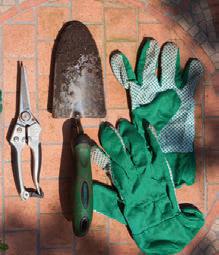
One day, a Dutch farmer went to the market, willing to buy a tulip. Finding the seller who carried the specific variety of flower he desired, our farmer entered into negotiations and finally agreed in the price both the seller and him deemed reasonable to pay for one single tulip-bulb: a thousand pounds of cheese, eight pigs, a dozen sheep, four tons of butter, four fat oxen, two loads of wheat and four of rye, two ox heads of wine, a bed, some clothing and a silver beaker. Such a high price for a tulip was not unusual during the so-called Dutch ‘Tulipomania’ in the 17th century. Widely available at modest prices today, tulips are still closely associated with the Netherlands. However, tulip is not a native Dutch flower. Scientists say that Inner Asia is the most important gene center of the plant. By Europeans, tulips were first seen in Turkey. Credit for this ‘discovery’ goes to a 16th century Flemish writer, herbalist and diplomat named Ogier Ghiselin de Busbecq, who witnessed blooming tulips growing in the gardens of Adrianople and Constantinople while he served as the Austrian ambassador to the Ottoman Empire. The ambassador was an avid collector, acquiring valuable manuscripts and apparently all kinds of rarities. He brought several bulbs and seeds of the curious flower back from his journey and gave some to a botanist named Carolus Clusius,
BEAUTY BY DISEASE
DID YOU KNOW?
• The most popular area of tulip related research is in the area of the scents of bulb flowers.

• During the Tulipomania, a sailor was allegedly sentenced to jail for months because he ate a tulip bulb that he mistook for an onion.
Access and demand
MEANING OF FLOWERS
“Language of flowers” was invented during the Victorian Era, when it became fashionable to exchange messages by giving flowers. Each flower has its own meaning, with different flower colors often representing new shades of meaning. Tulips are available in a wide range of colors, each with their own meaning. In general, tulips are thought to send a message of perfect love. The pink tulip specifically denotes feelings of caring, perfect happiness, or well wishes. Many florists consider this flower choice appropriate for all occasions. Blue tulips are thought to symbolize tranquility and peace, conveying a message of trust and loyalty. (True blue tulips do not exist. Blue tulips are either dyed blue, or are a hybrid of a lilac or blue violet.) Yellow tulips range greatly in their color, from bright yellow to an orange. Originally, yellow tulips meant "hopeless love"; however, they are now more commonly associated with thoughts of cheerfulness. Red tulips symbolize "true love."
another key figure of the history of European tulip
another key figure of the history of European tulip interest. Head botanist of the Dutch university in Leiden, Clusius started to experiment with the flower, producing new color variations. Some of these new breeds, such as the ‘Semper Augustus,’ were heavily over-priced, and consequently, became outstandingly fashionable: a luxury item people would like to possess, no matter what – and so the craze began. As the bulbs were usually sold by weight while they were still un-sprouted, speculations emerged.
In the 20th century, it was discovered that the frilly petals and dramatic flames that gave tulips a stunning look, in fact were the symptoms of an infection by the mosaic virus, caused by a louse living on peaches and potatoes. The healthy flower is supposed to be solid, smooth and monotone. Diseased varieties are no longer sold, what one can find is hybrids that look similar but are genetically stable. By now, almost 4,000 horticultural varieties have been developed. When celebrating its 90th anniversary in 2009, Royal Dutch Airlines KLM has received its own variation, a light green and white hybrid, called ‘Tulipa KLM.’
Some began selling promissory notes guaranteeing the future delivery of the tulip bulb. The buyers of these resold the notes at markedup prices. Promissory notes changed hands from buyer to buyer until the tulip became ready for delivery. The key was to be able to resell the note before the tulip could be delivered; the unlucky gambler was the person who could no longer resell the note because he now owned the actual tulip. This process became known as the ‘tulip wind trade,’ because transactions involved nothing more than thin air. As the mania increased, tulip prices soared to fantastic heights especially if the variety was rare or particularly striking. People actually converted their property into cash, and invested it in flowers. But, like every mania, the Tulipomania had begun its downfall, too. Bright colors and frilly petals were no longer that impressing. Over-supply led to lower prices and a universal panic seized upon the dealers. To end the frenzy, the Dutch government had to interfere by enforcing economic controls. It was declared that anyone who had bought contracts to purchase bulbs in the future could void their contract by payment of a 10 % fee. Attempts were made to resolve the situation to the satisfaction of all parties, but these were unsuccessful. In 1637, finally, the market crashed. It took a while until the commerce of the country recovered from the severe shock, caused by something as common as a flower. Even today, Tulipomania or tulip madness is used as a term for any economically absurd group craze where speculation borders with senseless gambling.
Today’s flourishing business
The bulb sector in the Netherlands is a world market leader. The flower auction at Aalsmeer is the largest flower market in
the world, with an annual turnover of EUR 4.6 billion. According to the Dutch Ministry of Economic Affairs, approximately 60 % of the global production and more than 80 % of the trade is realized within the country. Additionally, most of the production of flower bulbs abroad is in Dutch hands, too. Flowers are not only key export products of Holland, but they also draw many tourists from all over the world. In 1949, the first international flower show was held in Keukenhof. This place, dubbed ‘the world's largest flower garden,’ is still the country's main attraction with its velvety lawns, old trees, ponds, pavilions filled with exotic plants, birds and butterflies, and of course, millions of tulips. The Dutch, themselves, adore tulips as well. Every year, when the Pope delivers his Urbi et Orbi, they look forward to hear those magic words: “Thanks for the flowers from the Netherlands.”


FEBRUARY 2017 |DIPLOMACY & TRADE www.dteurope.com
18
photos by PIXABAY.COM
dutch focus
DUTCH VALUES IN CAR TRADE
AUTOBINCK SELLS EXPERIENCE TO CUSTOMERS RATHER THAN JUST CARSS
“The Dutch Autobinck Group, which nowadays has an annual turnover of around EUR one billion, has been active on the automotive market for over a hundred years, and thus, it adds two very important things to our work: the professional experience gathered over this long period of time and the capital strength. The Group’s three companies in Hungary have a combined capital of over HUF eight billion (appr. EUR 26 million) with staff of 102 people,” János Kerekes, the Country Manager & CFO for Autobinck Car Distribution and Retail Hungary explains to Diplomacy&Trade. Autobinck Hungary, with 100% Dutch ownership, includes three companies: one is the importer of Hyundai, another is the importer of Jaguar and Land Rover and the third (Autopalace), which operates three car dealerships in Budapest. This group of companies was launched in 2007 to import Hyundai vehicles for which it purchased a dealership the following year. In 2011, Autobinck won the tender to be the Hungarian importer of Jaguar and Land Rover vehicles for which it opened a dealership that year. In 2016, it opened a third dealership, its flagship for Jaguar Land Rover with a representative showroom.
János Kerekes joined Autobinck’s Hungarian team in March 2009 as the Chief Financial Officer (CFO) and then, in the summer of 2014, he assumed the leadership of the group as Country Manager, representing the owners, while also retaining the position of CFO. In 2011, a tender to import Jaguar and Land Rover vehicles was announced because the then importer was not able to comply with the expectations of the factories. János Kerekes recalls that India’s Tata Group purchased Jaguar and Land Rover from their respective owners in 2008. Coming with Land Rover from BMW was CEO Ralph Speth who initiated massive product developments at Jaguar Land Rover (JLR) with new plants, new technology, new models – all this with German quality in mind. Along with this came the recognition of the importance of distributors in different countries as the manufacturers realized that the development of good cars with good price is not enough if the representation is not adequate. Thus, the importers were replaced in 16 countries (including Hungary). The manufacturers’ expectations were clear: they were looking for firms with past experience and capital strength that could ensure the level of representation in dealerships and marketing activities worthy of these brands.
“Autobinck was already the Hyundai importer to Hungary but winning the JLR import tender did not cause a conflict of interest as, for the moment at least, Hyundai is not a direct competitor for Jaguar and Land Rover,” the Country Manager points out.
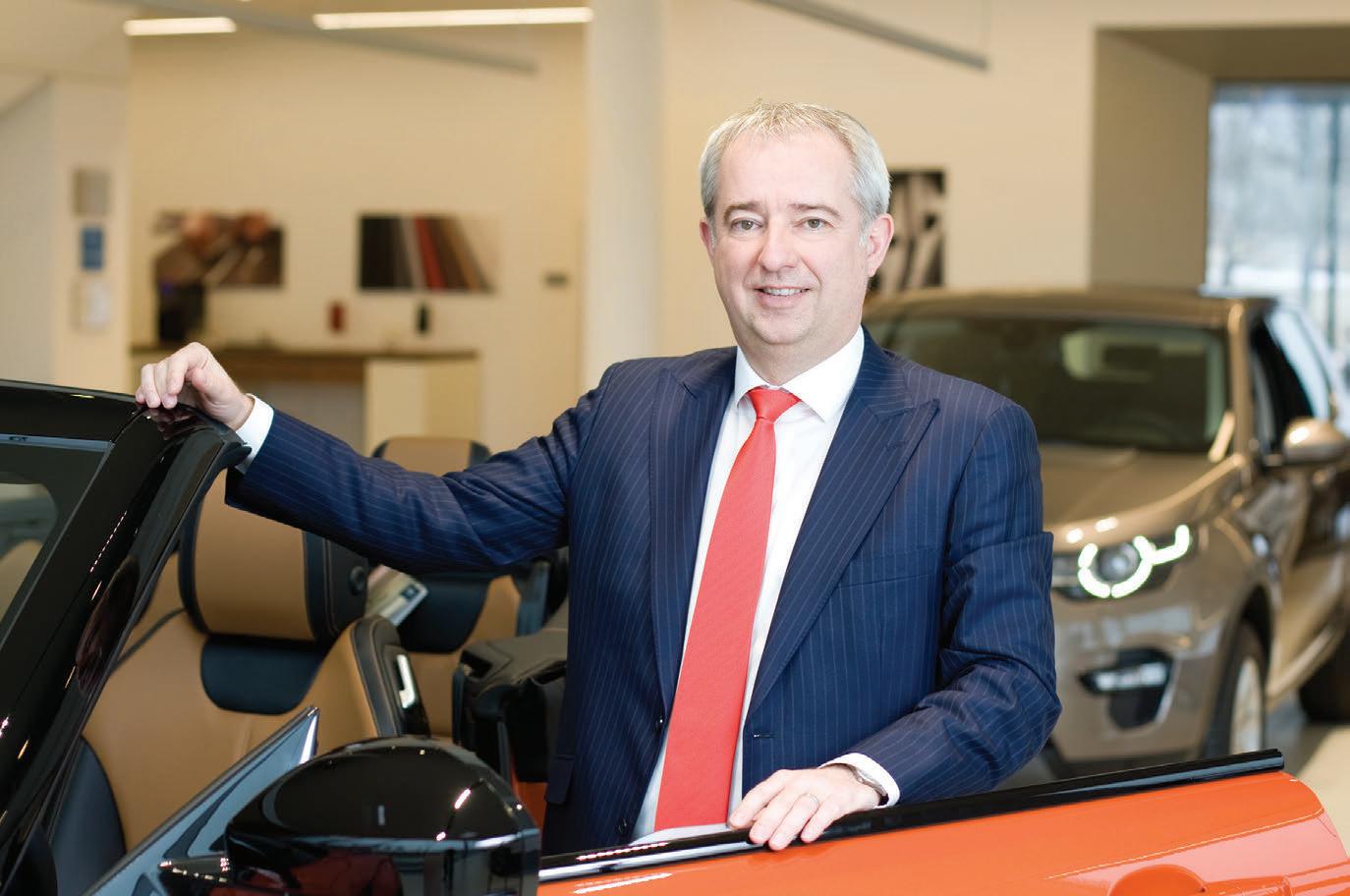
Hyundai eyes premium segment
“However, speaking of Hyundai, I can say that the factory has clear attempts to move the brand towards the premium category. This is clearly seen on models released year after year. The first Hyundai model in which I had
the feeling of being in a premium car was the Tucson, a smaller SUV, which became deservedly successful,” he stresses.
He adds that the new Hyundai i30, of the same category as the Opel Astra, is a huge step forward compared to the previous i30 model.
“I was amazed to see both the exterior and the interior of this car, the use of materials, the design and feel the vehicle’s capabilities. With the premium segment in sight, it will also feature a ‘fast back’ sports coupé version.” He finds it important to say that while other automakers perhaps neglected somewhat the development of electric cars, Hyundai came up with its Ioniq model, which is a car with quite a long drive capacity (250 kilometers with one charge). In addition, this is the first car in the world that is manufactured with three different powertrains: hybrid, plugin-hybrid and fully electric. “I believe it is the right direction: a car’s comfort and interior should not depend on what kind of engine it has under the hood.” At the same time, Hyundai did not neglect the fuel-cell, either. This system is so much in evidence for the company that there are fuel-cell driven cars and vans in service around its office in Frankfurt, Germany. “In Hungary, we concentrate on the electric vehicles, especially with the recently introduced state subsidies in mind,” he highlights.
Innovative technologies at Land Rover
The CEO believes that on the Jaguar Land Rover front, one can expect big things from
Land Rover this year. One of the best known traditional models is the Land Rover Discovery, which maximally expresses the brand’s slogan ‘Above and beyond!’ It replaces the old Discovery Four model, which is popular with many drivers, especially because it has real terrain capabilities besides being a large family car with a large luggage compartment. “This philosophy was also followed when the new model was designed and created. It has become a large SUV, a family car that has large space for baggage even after seating seven people –something uncommon in this category. It also features a couple of innovative technologies, like the world's first ‘Transparent Hood Concept’ allowing a new level of driver awareness with a 'see-through' augmented reality view of the terrain ahead, making the front of the car 'virtually' invisible from inside the cabin. This can come in handy on rocky terrain, for instance. Another feature expected to be very successful in this model is the range of engines from a two-liter diesel one to three-liter diesel and petrol engines. The other novelty concerns the Range Rover Sport, the most successful model of this range. Its smaller, ‘baby’ version is to come out this fall and is expected to be a great success with the younger generation.”
Dutch business values
János Kerekes says he likes to attend the events of the Netherlands-Hungarian Chamber of Commerce because he feels good in the world of Dutch values. “Among these,
I would like to emphasize transparency first, the clear and unambiguous communication with no behind-the-scenes, crony deals, etc. Another thing is that it is probably the Netherlands that has the longest commercial tradition in the world. Having good personal relations with the owner of the Autobinck Group, the 78-year-old Rolf Lauret, enables me to experience a lot of this great commercial culture, which could mean tough negotiating position but, at the same time, correctness, as well. The Dutch are profit-oriented but fair business partners.” He adds that the Autobinck Group’s mentality is characterized by environmental consciousness and innovative thinking. Within the group, an important cooperation began in 2015-16 with firms that operate in these sectors. Thus, the Group acquired a substantial stake in a pan-European network of electric charging stations as well in a company producing solar panels. As for innovation, it has ownership stake in ‘Snappcar’, a carsharing company in the Netherlands. Autobinck is not simply selling cars but providing comprehensive service to customers. “The creed of our company is that most of our customers wish to buy not only a car but to actually buy an experience. This is what guides us in our work. It helps that through the dealership we own, we have direct relations with our customers whose feedback is very important for us,” the Country Manager concludes.
www.dteurope.com DIPLOMACY & TRADE| FEBRUARY 2017 19
photo by DÁVID HARANGOZÓ
dutch focus
BIG PORT – GREEN PORT
THE PORT OF ROTTERDAM AIMS TO BE THE WORLD’S MOST SUSTAINABLE PORT

The Port of Rotterdam has the ambition to be the most sustainable port in the world. By breaking new ground in the way it operates, which includes the development of Maasvlakte 2, a major civil engineering construction project of a new port and supporting infrastructure on reclaimed land, it aspires to be at the forefront of sustainability and accessibility. “This way, we strengthen Dutch and European competitive power and make Rotterdam Rijnmond a region where people like to live, work and have recreation. By sustainability we mean working towards greener industry and logistics and enhancing the quality of our environment. We cannot simply say goodbye to fossil fuels overnight, but we can develop sustainable alternatives in the meantime. Wind energy, solar energy and energy from biomass provide a viable alternative to fossil fuels,” the port authority says in a statement. Port of Rotterdam Authority believes the only way for the port area to grow in a balanced way is by caring about its surroundings and the environment. They wish to do this by adopting a three-level approach: improving the performance of the Port Authority, fostering sustainable enterprise in the port area and calling for sustainable innovation in the entire supply chain. There are already various projects in progress to make it the most sustainable port in the world.
Wind energy
In the Port of Rotterdam, numerous types of energy converge: not only coal and natural gas, but also biomass, heat, steam, solar and wind. As the supply, production and distribution of energy is used extensively, sustainable energy generation is an important development. Currently, the total capacity of wind turbines installed in the Rotterdam port area is 200 megawatts (MW). This represents
about 10% of the total wind energy capacity in the Netherlands. The Dutch government has decreed that 14% of Dutch energy production must be generated from renewable sources by 2020 and 16% by 2023. The Port of Rotterdam Authority supports this through the ‘Agreement on Realization of Wind Energy in the port of Rotterdam’ (2009). In accordance with this agreement, at least 150 MW of new wind energy will be generated in public port areas by 2020. In the Port Vision, the Port
Authority and various partners have agreed to achieve a total installed capacity of 300 MW by 2020. As a result, Rotterdam is well on its way to achieving its ambition to become the sustainable power plant of Northwest Europe.
LNG as an alternative fuel
LNG is an attractive alternative fuel for seagoing vessels, inland vessels and trucks. The port of Rotterdam is a strong supporter of LNG and plays a pioneering role in its introduction. The port takes a leading role in adapting the regulations and creating the necessary infrastructure and in doing so also serves as an example for other ports. When liquefied natural gas is used as a fuel, fewer polluting substances are emitted. For that reason, vessels using LNG as a fuel comply with the emission standards for the maritime sector in the North Sea and the Baltic Sea, which were tightened in 2015, without the need for additional measures. Advantages of LNG as a fuel include lower emission of particulates, sulphur and nitrogen oxides and CO2; it meets the more stringent emission standards (SECA); LNGpowered engines require less maintenance and are much quieter; it is cheaper than petroleum-based fuels; and it has higher energy value than other fossil fuels.
GREEN AGENDA IN FLOWER TRADE

AUCTION HOUSE IMPLEMENTS PROJECTS AIMED AT IMPROVING HEALTH AND WELL-BEING
Royal FloraHolland, a Dutch conglomerate of florists, is the operator of the largest flower auction in the world. Part of its corporate responsibility is participation in the Green Agenda in which knowledge institutes and entrepreneurs develop and test innovative green concepts. The company believes that over the next decades, society will face more extreme weather patterns, an aging population and increasing urbanization. Parallel to this will be a decrease in the quality of housing and work and living areas which will negatively affect people's health and well-being.
Royal FloraHolland is of the view that the fiveyear Green Agenda program can be part of the solution to these types of problems. The Agenda has several projects to help realize its objectives: The ‘Ecosystem services of tree nursery products’ project develops instruments that allow the advantages of green to be better taken into consideration in the decision making process. The project’s goals include developing instruments whereby the advantages of green ecosystem services can play a greater role in decision-making on design, policy and management of a green agenda. It can also increase knowledge which growers can use to develop and market their range to fulfil specific functions and it can create a closer link to the tree nursery and green management sectors. The ‘Green for grey’ project maps and quantifies the effects of green on the quality of life of
those suffering different stages of dementia. It attempts to answer questions like ‘Does green in the neighborhood affect the quality of life of those suffering with different stages of dementia?’ and ‘What type of savings could it deliver in health care costs and medicine
use?’. According to the Green Agenda, there is much knowledge and experience gathered worldwide on dementia gardens. The objective is to translate this knowledge to an innovative green concept and to apply this green concept in urbanized neighborhoods with vulnerable
senior citizens in the Netherlands. The costs and benefits for the senior citizens, their caregivers and society will then be quantified. The ‘Green health check’ project looks at the development of a tool that includes a spatial system that demonstrates the added value of a green environment. This project involves researchers, citizens, companies, the best of the Horticulture and Starting Materials Sector, health care professionals and local authorities. The collaboration generates a well-founded and shared understanding of the contribution made by streets, neighborhoods and districts green to the city. It also fosters understanding of the spatial possibilities and hindrances in which green ideas can best function. ‘Green healthy hospitals’ - this project maps the effects of a green environment in and around hospitals on the health and well-being of patients, personnel and visitors. A practice and learning network, still to be established, will enable stakeholders to learn from each other. Finally, the ‘Plants for a good indoor climate’ project quantifies the costs and benefits of green solutions in buildings in a way that changes the view of plants as ‘costs’ into ‘cost saving’. In the framework of this project, knowledge institutes measure both the physical parameters as well as the well-being of users over a long period. The data collected will underpin a model which will further assess costs and benefits and allow for the further development of innovative plant systems.
FEBRUARY 2017 |DIPLOMACY & TRADE www.dteurope.com
20
photos by PIXABAY.COM
dutch focus
AFFINITY, FIDELITY AND IDEA
AFFIDEA IS HUNGARY’S LEADING PROVIDER OF DIAGNOSTIC IMAGING SERVICES
The history of the company ‘Affidea Diagnostics Hungary’ dates back to 1991 when it established a diagnostic imaging center (under the name International Medical Center – IMC) at the MÁV Hospital in Budapest. “The significance of the place was that it had the second Magnetic Resonance Imaging (MRI) appliance installed in the country and that was where many radiologist professionals learned tricks of trade,” Affidea Diagnostics Hungary Country Manager György Leitner explains to Diplomacy&Trade. Nowadays, the company has 11 diagnostic imaging centers in Hungary and some 220 across Europe.
“We provide a full range of radiology diagnostic services, MRI, PET/CT, mammography, ultrasound, X-ray, etc., which is not very common among private service providers. For instance, Affidea is the provider of such services at two medical universities in Hungary (Szeged and Debrecen), where the requirements are high as our machines are not only used to diagnose patients who are treated there because of the seriousness of their condition but also because they are used in the education of the future generation of professionals. So, on top of the one million examinations we make in Hungary annually, we also provide an important contribution for Hungarian healthcare in medical education. One in seven radiologists in Hungary works for Affidea, which is interesting because radiologists are in great shortage of in this country,” he adds.
A fragmented market
He is of the opinion that the diagnostic imaging sector is a fragmented one, which means that there are a lot of service providers but there is only one other pan-European provider apart from Affidea. “This market is proceeding towards consolidation and concentration. We believe this is a good direction from a few points of view: quality insurance, patient safety and the setting of higher standards. The international background provided by the Affidea Group for Affidea Diagnostics Hungary also means economy of scale: it is more cost effective to buy the machines in bulk (e.g. an MRI appliance may cost EUR one million, depending on its features) and the auxiliary materials (like contrast substances). It is an incredibly fast growing sector, a real high-tech area. It could be due to the latter that while 20-30 years ago, it was mainly women who chose the radiologist profession (which then mostly meant being an X-ray doctor), nowadays, more and more are men who are attracted to high-level knowledge and information technology, which this profession is all about. The scale of the company is capable of ensuring more standardized and more efficient processes for the benefit of the patients. For instance, structured reporting is getting more and more important in evaluating the images. It is basically a structured process that leads the doctor through all the necessary stages, making sure that all rules are adhered to and the most possible information is extracted from the images in the interest of the patient. The development of this protocol is also

helped by the high number of processes provided by the 200+ centers we have. The same is true for the ‘fine-tuning’ of the necessary level of radiation in CT examinations. I’m very proud that six of the diagnostic centers we have in Hungary were awarded by the European Radiology Society for excelling in low-dose CT scanning.”
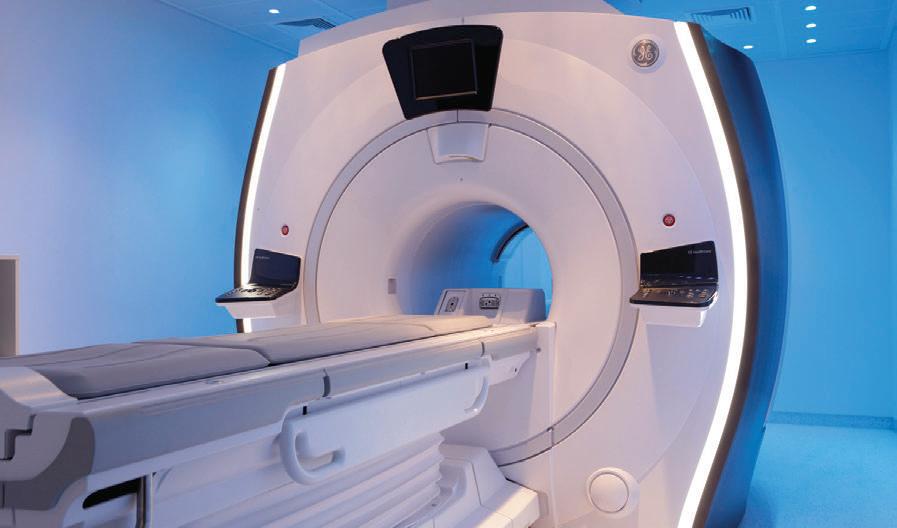
Affinity, Fidelity, Idea
The name Affidea is coined from the words Affinity, Fidelity and Idea. As to how these three things have helped the firm to become Hungary’s leading diagnostic imaging service provider, the Country Manager explains that the company has chosen to make its values appear in its brand name. “Affinity means a kind of sensitivity and paying attention to things and people.
That is how we approach the patients and our healthcare professional partners. This shows how important it is for us to see the patient leave with satisfaction. This is not the kind of place where people come with big smiles on their faces, as one usually encounters a healthcare service provider when he or she have some sort of problem. I wish I could see an even greater number of people willing to regularly go to health screenings, as its can greatly increase the chance of cure should they have any medical condition. Fortunately, statistics suggest that there are more and more people realizing this.
In order to ensure that the entire staff of Affidea Hungary (about 550 people) are aware of the importance of patient satisfaction, everyone went through a training process towards the end of last year. My conviction is that everybody – wherever they may be within our organization – has some sort of relationship with the patient and they have to be aware of this affinity.”
As for ‘Fidelity’, it is a kind of loyalty to the company’s partners and its values. “For us, it means that we work hard to gain the confidence
and for the trust of our patients and our healthcare professional partners. The third term, Idea, clearly means innovation skills. This company operates in the high-tech sector and it cannot afford to not keep pace with the constant innovation we see in our industry. These appliances become obsolete every 5-7 years and need to be replaced. Measured on a European scale, the average age of our companies’ 850 pieces of equipment is lower than in most European countries,” he highlights.
Services
Affidea Diagnostics Hungary provides diagnostic services for private patients, as well, but the other, bigger ‘leg’ is the provision of services for the National Health Insurance Fund (OEP), which accounts for about 80% of the firm’s total turnover. The Country Manager stresses, however, that the other 20% is very fast developing since the private health market is growing at an incredible speed. “Our research
shows that the willingness to use a private healthcare service provider is high even among lower middle class Budapest residents and it is getting stronger. Private healthcare is growing fast since none of the EU countries state healthcare is able to keep up with the increased demand of their ageing populations. What’s more, Hungary spends a relatively low amount on healthcare, only 4% publically, which is one of the lowest among EU countries. That’s the reason, why the proportion of money spent on private healthcare here is extremely high within the total healthcare spending – more than 30%.”
Business to business
Affidea also operates a VIP diagnostic center for corporate customers. According to György Leitner, they constantly seek contacts with corporate partners who have a large number of employees and are not satisfied with the annual health checks (blood test, EKG, etc.) for their staff but want more comprehensive examination for them. “For such corporate clients, we provide special screenings for age, sex, job type, etc.,” he says. He points out that that another very important circle of clients for them is that of private health insurance companies that constitute a market of roughly HUF 10 billion (EUR 32-33 million). “It is a very slowly growing market, although, it would be important to see more players in this sector as there are people who wish to have more, newer and/or different services, medicine, etc. than provided for them through the national health insurance system. Or simply, they wish to have quicker access to screening services. Nowadays, an average patient needs to wait 2-4 months for an MRI examination but even a simpler ultrasound screening has a waiting period of 6-10 weeks. Many people prefer to have a diagnosis in time, something they are willing to pay for. This is an out-ofpocket expense, which is not good because it is not necessarily part of self-care that one plans ahead for, nor it is an insurance-based expenditure. I very much hope that this sector is going strong in Hungary and will become an important partner for us,” he concludes.
www.dteurope.com DIPLOMACY & TRADE| FEBRUARY 2017 21
photos by DÁVID HARANGOZÓ, AFFIDEA
dutch focus
THE ART OF WINNING
INCENTIVES, TRAINING & EVENTS OFFERS DYNAMIC AND SURPRISING EVENTS FOR COMPANIES
Lóránt Imre Lakatos moved from the Netherlands to Hungary in 2005 to try his luck in the country of his father. “I was born in Holland to a Dutch mother and a Hungarian father and I graduated as an economist and logistics manager there. When I moved to Hungary, with not much idea of what to do, I got a call from a friend of Hungarian origin in the Netherlands who suggested that I should follow his example and get involved in organizing surprising events (indoors and outdoors) for companies. His company in Holland happened to be called ‘DUNA’ (a very creative and unique name there), that is where the idea came from to establish the firm ‘DUNA Incentives, Training & Events’ here. At first, I had no idea what it meant to organize a dynamic event, so I sat in my friend’s office for weeks listening and taking notes before starting the business here on January 6, 2005,” he explains to Diplomacy&Trade.
Dynamism and surprises
He adds that the Dutch approach is very analytic, step by step, they like to think ahead and “if we do event organizing, we obviously have to plan everything ahead. This is the experience I was able to apply in my new business here in Hungary, as well. We bring in the ‘DUNA spirit’, which means dynamism and surprises where content is more important than etiquette. We know that in Hungary, things are more formal, that is why we plan our events in a more interesting, surprising way. We have several adventure programs that we have been offering for years like ‘The Smuggling Route’, ‘The Search for Attila’s Sword’, ‘The Budapest City Survival’ and ‘The Management Expedition’.” As for the market, he says they had 4-5 years when the demand for such services was low but “we now feel that it is picking up again, companies are more interested in this field and we have more opportunities, too. Whatever the market, we have always depended on ourselves. The cake may be smaller than it was 15-20 years ago but if we have more slices, we are still better off!”
Champion on the team
The best-known staff member in DUNA is three-time Olympic champion water polo player Dr. Gergely Kiss. “We started working together in 2007. I was first invited by Lóránt as a guest in one of those ‘stepping-outof-the-ordinary’ programs. We organized waterpolo tournaments for company staff and even held a special meeting with selected guests on top of a hotel during the European Waterpolo Championship in the Netherlands. It turned out to be a very good cooperation. Since I have an extensive circle of acquaintances and Lóránt has this creativity and know-how, we thought these could complement one another very well. In addition, I am one of the program points on offer for our clients. We call it the ‘Art of Winning’, that is, how one can become better than others, how to achieve excellent performance.”
As for event organization, he adds that Lóránt carries out the operative tasks “while my job includes contact with clients. For instance, we have won the right to organize the annual ‘M4 SPORT – The Sport(wo)man of the Year’ gala hosted by the Federation of Hungarian Sports Journalists (MSÚSZ). I am bringing in sponsors from the automotive and health industries and my responsibilities include preparing contracts and managing media appearances. If we are speaking of cake, I would say that I am the icing on the cake while the cake itself is prepared and baked by Lóránt who does the bigger part of the job. I help with bringing in new partners.”

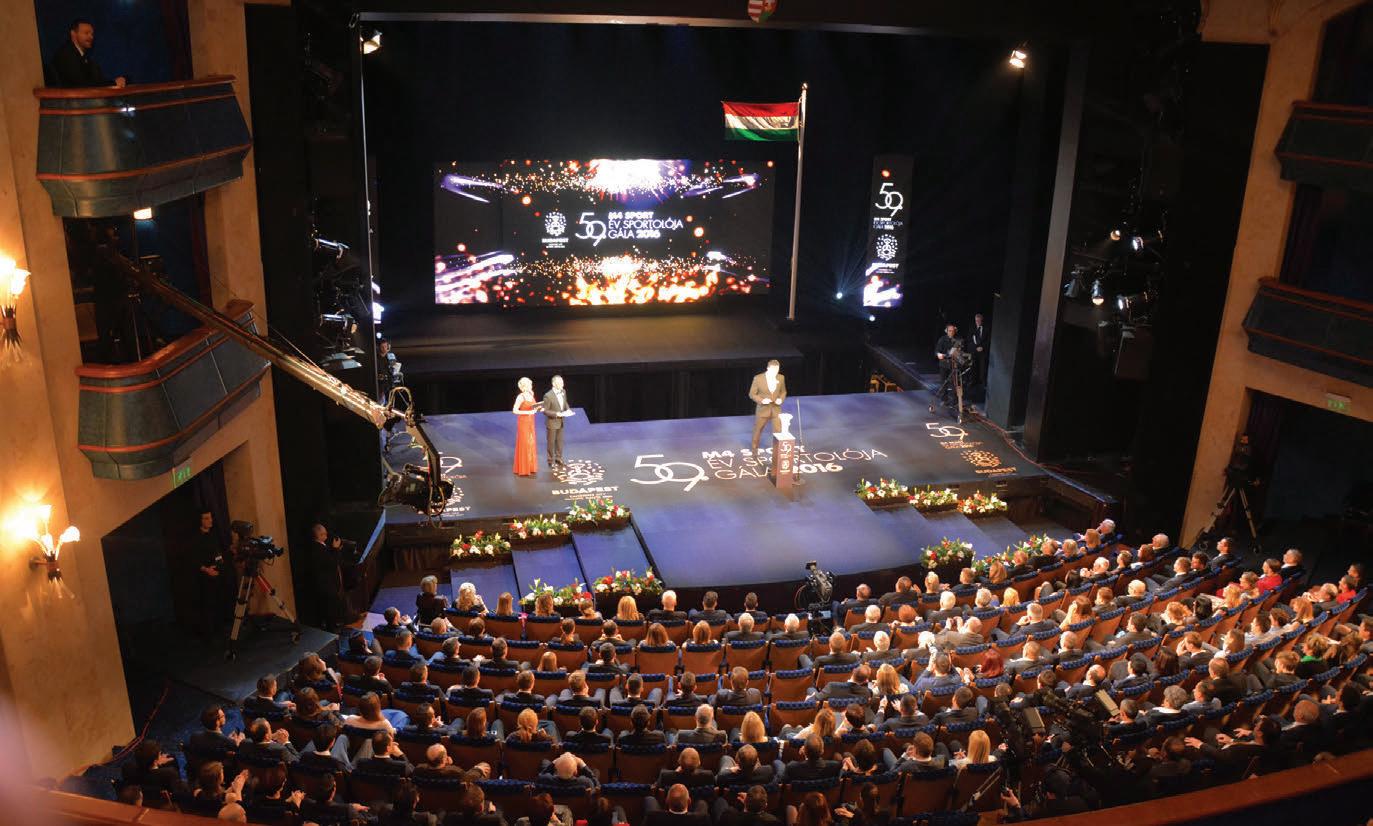
Maintaining success
In the ‘Art of Winning’ lecture, Dr. Gergely Kiss is often asked not only how to achieve
something excellent and reach the peak but also how to stay there, how to maintain that position. “If a company is market leader in any field of business – real estate, leasing, whatever – they wish to stay on top. During this interactive workshop, I can explain how all this worked in the successful Hungarian national waterpolo team winning consecutive Olympic titles while carrying the weight of being the favorite whom every team wants to beat. I also want them to understand that the ‘Art of Winning’ does not only include the gold medalists but also those who manage to be among the top actors in the field of many competitors. Another aspect is how to create a successful team, say, a new department from people of different age, experience and background. I can tell how
this worked for our team – not just from my own experience but also from books and studies on what the secrets are to teams, communities and individuals working together successfully. I want to mold all this – plus what I got from my teammates, coaches and sports leaders – into a recipe for success.”
As Lóránt Imre Lakatos points out, there are a lot of parallels between competitive sports and the everyday challenges in corporate life: “cooperation in teams, a lot needs to be invested before reaping the benefits, so we can use a lot of Gergely’s experience. We have several guest speakers in our portfolio, the first was Gergely. He understands what is important for different audiences, different teams, and since he knows what it takes to be a good lecturer, what sort of people we need for this job, he brought in several fellow Olympians who can be accessed for such programs whenever need be.” Regarding the secret of success of DUNA events, itself, Dr. Gergely Kiss says “the key to the ‘Art of Winning’ at the firm is Lóránt’s determination and his dedication to ‘we overcome every hurdle’, ‘we resolve everything’ – if we see a pothole, he finds a solution: he figures out how to step over it, get around it or cover it. The most important thing that we can achieve at DUNA is that even after ten years, a staff member at a corporate client of ours refers to a program of DUNA to a colleague: ‘Remember the Trust Expedition in the Danube Bend…’? It is good to hear from people years later that a piece of good advice we gave them at one of our events still comes up during a daily challenge.”
FEBRUARY 2017 |DIPLOMACY & TRADE www.dteurope.com
22
photos by TAMÁS GÉZA RÓTH/MSÚSZ, DÁVID HARANGOZÓ
DUNA
dutch focus




GREEN DEALS IN NEED
CIRCULAR ECONOMY: SUSTAINABLE FLOW MANAGEMENT IN AGRICULTURE

At a recent event of the Royal Dutch Embassy’s successful conference on circular economy, the main subject was sustainable agriculture. In his opening speech, Ambassador Gajus Scheltema stressed that the transition from a linear to a circular economy will be one of the greatest challenges of the 21st century. He added that this can only be accomplished through joined forces because of the complex effect on ecosystems and macroeconomic considerations. Even though,
the Netherlands may be considered a pioneer in their approach to - and innovative applications of - a circular economy, a real breakthrough will only be achieved with the help of EU partners, on a governmental and corporate level. According to an Embassy statement, Martin van Nieuwenhoven from the Dutch Ministry of Infrastructure and Environment presented highlights of the Dutch government’s new strategy for circular economy, particularly regarding agricultural resources. The objectives of this strategy are resoundingly ambitious:
by 2050 the Dutch economy has to be 100% circular. To achieve this goal, the use of primary sources (metals, fossil fuels, minerals) has to be reduced to 50% by 2030. One of the ways to achieve this is to conclude ‘Green Deals’, where the government signs agreement with entrepreneurial platforms. Speaking on behalf of the Hungarian government, Deputy State Secretary in the Ministry of Agriculture Zsolt Feldman emphasized that for a successful transition to a circular economy, further innovation will be needed in conjunction with an economically predictable business environment. Furthermore, cooperation between players in the food industry chain and the business sectors must be strengthened. He called attention to the BIOEAST program of the Ministry of Agriculture that started at the end of 2015. The main goal is to sustainably develop knowledge-based agriculture, aquaculture and forestry within a biomass-based economy in the Central Eastern European region.

Incentives, Training & Events organises tailor-made programs based on creativity and adrenaline. Our philosophy is to create a unique mix of cultural, culinary and interactive activities at our events.



provides unforgettable, exciting experiences at the most special locations in the world. Our starting point: adventure, fun and recreation at the same time. Our activities enhance effective communication, support mutual understanding within the team, and are perfect for both internal and external relation management.

is the contracted organizer of the M4 SPORT – Sports(wo)man of the Year Gala. The next gala will take place in January 2018 in the National Theatre. Please contact us to request your partner info package.

www.dteurope.com DIPLOMACY & TRADE| FEBRUARY 2017 23
Source: Centraal Bureau voor de Statistiek, Den Haag/Heerlen photos by MÁRTON TORDAI, CAN STOCK PHOTO INC.
ABOUT US INCENTIVE TRIPS TRAINING EVENTS TICKETS SPORT & BUSINESS TRAINING CAMPS GUEST SPEAKERS DUNA LOUNGE H-1052 Budapest |Semmelweis u. 4. I. em. 2. Tel.: +36 1 327 0400 | Fax: +36 1 327 0401 info@duna-events.eu | www.facebook.com/dunaevents | www.dunaevents.com DUTCH IMPORTS FROM HUNGARY DUTCH-HUNGARIAN TRADE (JANUARY-OCTOBER 2016) DUTCH EXPORTS TO HUNGARY EUR 1,000 % % EUR 1,000 1,691,079100.00total goods100.002,734,550 99,7605.90food and living animals 10.08275,695 7,1360.42drinks and tobacco0.7721,014 50,0592.96raw materials, not edible3.0583,331 10,7680.64mineral fuels, lubricants0.4111,258 30,0491.78animal and mineral oils0.6517,908 199,21211.78chemical products21.73594,242 143,2258.47manufactured goods11.83323,514 1,044,15861.75machines and transport equipment 42.511,162,379 102,6316.07 different manufactured goods 8.92243,847 4,0800.24not mentioned goods0.051,363
witty leaks
WITTY LEAKS
I arrived in Budapest a year and a half ago and I am feeling more and more at home. I recognize that this is not difficult in such a beautiful and interesting capital city, but besides the charms of Budapest and of the rest of the country – which I am still discovering –, I must also say that my work as the diplomatic representative of Portugal has been made easier by the friendliness and availability of all the people that I have met either at official or private levels. Both Hungary and Portugal can be proud of a very long history, a strong national identity and a rich culture. I have been particularly pleased and impressed by the large number of Hungarian students of Portuguese language and culture in several universities and secondary schools in this country and by the high level of their achievements. This shows that there is a mutual attraction despite the geographical distance. When studying Portuguese, an immense world perspective is opened to those engaged in such studies as these bring them closer to all the member-countries of the Community of Portuguesespeaking Countries (CPLP), with 220 million people spread out in four continents.
I was therefore particularly pleased to learn that Hungary had obtained the statute of observer at the CPLP summit in Rio de Janeiro last October. Building on this cultural proximity, I have been working, among other things, in bringing to the forefront some of our bilateral ties that are relatively unknown to the Hungarians. For example, one of the main architects who participated in the reconstruction of Lisbon after the terrible earthquake of 1755 and whose work and influence can still be found in many Portuguese 18th century buildings was the Hungarian-born Carlos Mardel (Marttel Károly). He certainly deserves to be better known today in his native country. One must recall the help provided by Portuguese diplomats in Budapest, in 1944, to hundred of Jews to escape to Portugal, among which the parents and sisters of Zsazsa Gabor. Closer to our time, the tragic events of 1956 were recently remembered in Portugal and also the many families who received in their homes Hungarian refugee children arriving through Caritas to Lisbon.
I should also mention the fact that the most remarkable Portuguese painter in the second half of the 20th century, Maria Helena Vieira da Silva, was happily married for 50 years to another painter, Budapest-born Árpád Szenes. The museum in Lisbon that houses today many of their paintings carries their names. Since both Hungary and Portugal are
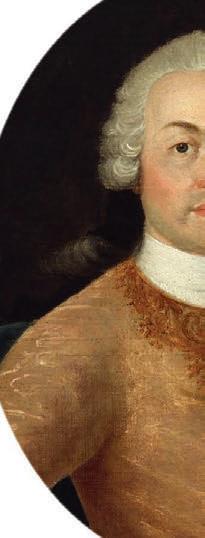
IN THIS SERIES,
SHARE PERSONAL ACCOUNTS
MUTUALATTRACTION
DIVERSE CONNECTIONS BETWEEN PORTUGAL AND HUNGARY
BY MARIA JOSÉ MORAIS PIRES, AMBASSADOR OF
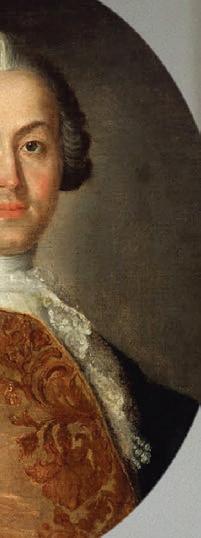

producers of very good wines, due probably to our shared Roman heritage, it is common knowledge that those wines must be preserved by high quality bottle stoppers. What is perhaps less well known is that the majority of Hungarian wine bottles use Portuguese cork for their stoppers. Furthermore, besides this traditional and very significant Portuguese export to Hungary, Portuguese cork products of modern design in many shapes have
found their way into Hungarian shops. Also in the area of civil construction, cork is a very useful and ecological insulating material. I understand that it was extensively employed in the beautiful Müpa (Palace of Arts) building in Budapest.
Portuguese exports and investments in Hungary have gone beyond traditional products, however. For example, some very visible if not noticed items are the garbage collectors and trash cans in use in Budapest which are
similar to the models that one finds in Lisbon thanks to a successful bilateral arrangement. In the world of sport, namely that of canoeing, many of the boats used in international competitions, like the Olympics, nowadays, by Hungarian athletes, have a Portuguese origin. And speaking of something quite different, the colorful tiles that one can see on the walls of the downtown metro station Deák Ferenc square are some of the famous Portuguese ‘azulejos’. They were a gift from the Lisbon Metro Company to its Budapest counterpart. Tourism is, of course, one of the thriving industries in both countries and it has been growing bilaterally in a very promising way.
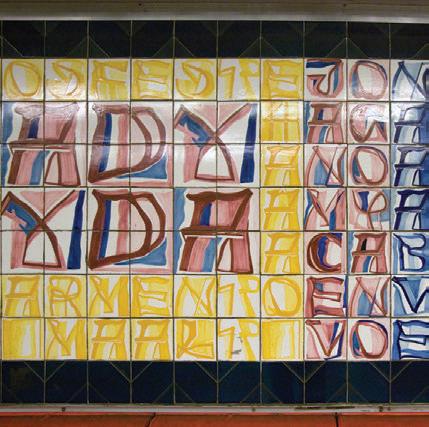
An amusing consequence that I have been told of is the large number of Portuguese tourists in Budapest, that see our flag on my official car, when I am attending some ceremony and enthusiastically ask my Hungarian driver, who is he carrying and to what function!
As my husband and I are music lovers, we have been having a marvelous time going to excellent concerts and operas. We have even been able to go to the theater despite the language barrier thanks to subtitles in English above the stage. In the musical context, I recently found a very informative article in a Portuguese magazine called Ilustração Portuguesa of 1911, written by a famous Portuguese pianist of that period, José Vianna da Mota, who was one of the last pupils of Franz Liszt. It recalls with great admiration his contact with the great Master. I had it translated into Hungarian, so that I can offer it to the Liszt Museum in Budapest. I hope that I have identified some of the less known areas that bring Portuguese and Hungarians closer to each other. They form part of my daily work as I strive to increase the bilateral contacts. It is a duty that I carry on, I must admit, with great pleasure in the friendly environment of Hungary.
FEBRUARY 2017 |DIPLOMACY & TRADE www.dteurope.com
24
DIPLOMATS
OF THEIR EXPERIENCES ON “EXCURSIONS” into Hungarian culture, art, gastronomy & scenery.
photos by COURTESY OF EMBASSY OF PORTUGAL
PORTUGAL IN HUNGARY
gift corner
Impressively

The Latitude 12 7000 Series is our thinnest and lightest 12.5" business-class 2-in-1, designed to go wherever work takes you. With an innovative magnetic connection for quick one-handed transitions, it’s always ready to flip into tablet mode at a moment’s notice.



Enjoy stunning resolution with the 12.5" Ultrasharp™ 4K UHD display, optimized for intuitive touch interaction. When you’re at the forefront of ingenuity, you get noticed. That’s why it’s no surprise the Latitude 12 7000 Series was honored at the CES 2016 Innovation Awards. The winning streak continues.

Perfection Consists Not In Doing Extraordinary Things
Located on the famous Andrassy Avenue an exclusive “Su Misura” service that goes beyond the regular standards of Men’s tailoring, Styling and Fashion.
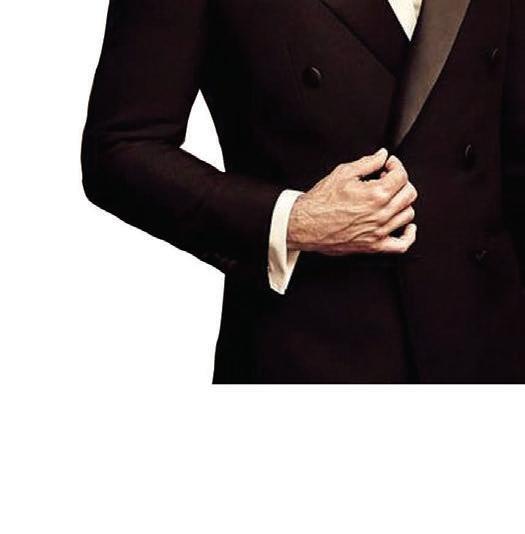

At STAN AHUJA, we believe that quality starts from the smallest and finest detail of any finished product. The first ingredient for any successful garment is the fabric it is made of and hence, this makes the cloth our most important feature. Our tailors with the help of our designers make sure to you get the perfect fit with most modern trends. May it be formal outfits like a Business Suit / Tuxedo or Winter Overcoat or even casual like Sports Jacket or Blazer we make sure you have what you need for the special occasion.The finer details like the placement of the pockets; the color of the thread used for stitching the inner lining and even the placement of the initials can be processed as per your request. Drop into our store or call us for an appointment and either way, we promise to make your STAN AHUJA experience an exciting and memorable one.
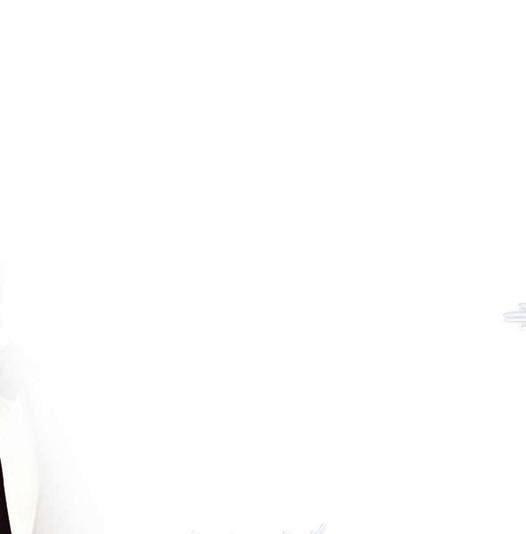
1061 Budapest, Andrássy út 38.
Design




iPhone


The US flag, completely new: Freddy Reitz transforms it into a kaleidoscope, hinting at the “melting pot” idea at the heart of the national symbol. In the background, a collage of newspaper and postcard clippings gives the stars and stripes painted over them a completely new note. Reitz calls her understanding of art “correspondent art.” She aims to engender a communicative bond between object and viewer. She layers collages and colors over one another until she has found the magical balance between boldness and subversion that characterizes her work. Freddy Reitz’s works are impressive messages of freedom dressed up in ravishing, colorful hues. Pop art at its best.


Silicone iPhone case with artworks of contemporary artist MSL. The cases are available for each iPhone model, such as iPhone 5, 6, 6plus, 7 and 7plus. The design shows the creation story of the first human couple as Eve hands the apple, the symbol of forbidden knowledge, to Adam. There is a pop-art and a black version, and it is lately also available in Renaissance style. The snake – under Eve's hand on the pop art version, and above Eve's head on the Renaissance style one – portrays the temptation itself, which promises that the possession of this knowledge will make them God.


www.dteurope.com DIPLOMACY & TRADE| FEBRUARY 2017 25 photos by COURTESY PICTURES, FREDDY REITZ, WWW.LUMAS.HU
New York Flag © Freddy Reitz, www.lumas.hu Painting, 100x185 cm, limited edition of 100, signed, € 2.849 LUMAS Budapest Galéria, 1051 Budapest Október 6. utca 21.
Latitude 12 7000 Series 2-in-1 Laptop agile. Sharply dressed.
www.lumas.hu www.facebook.com/mslcases www.msl.hu · 6th Generation Intel® Core™ M7 Processor · Windows 10Pro · 8GB Memory · 128GB Solid State Drive
New York Flag
Case www.dunaelektronika.com www.stanahuja.com
The Citizen (Az állampolgár)
FILM RUN 108 min



DIRECTOR Roland Vranik
SCREENPLAY Iván Szabó, Roland Vranik
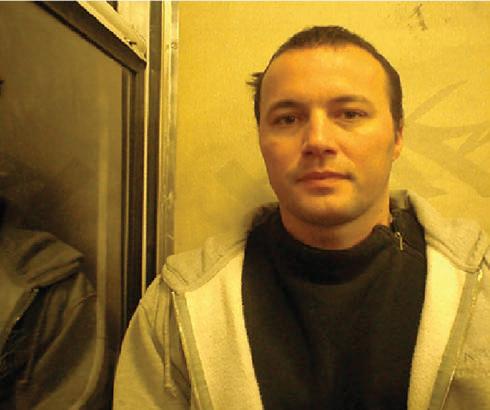
CINEMATOGRAPHY Imre Juhász
MUSIC Csaba Kalotás, Krisztián Vranik
CAST Dr. Cake-Baly Marcelo Ágnes Máh

Arghavan Shekari

PRODUCER Károly Fehér
PRODUCTION Popfilm
PREMIERS COUNTRYWIDE January 26 by Mozinet






ABOUT THE DIRECTOR
After graduation in 1987, Roland Vranik worked on several diploma films, shorts and national/international feature films as production manager and director's assistant in Budapest. Later he worked in the Netherlands where he directed four films and collaborated in several productions made by the students of the Dutch Film Academy. In 2000, he received a grant from the Balázs Béla Studio (BBS). He directed and wrote the experimental short film DOMINATOR 2000. The same year he was Director's assistant to Béla Tarr making the Werckmeister Harmonies. He also made some 30 spots and video clips before directing his first feature film.
Wilson (56) is an honest, good-hearted African man has been living in Budapest for several years. He came to Hungary as a political refugee, but subsequently found a home and works as a security guard in a supermarket. He wants to become a Hungarian citizen, however he repeatedly fails the basic constitutional studies exam. His life takes an unexpected turn when his colleague recommends her sister Mari (56), a teacher of Hungarian history and culture, to him as a tutor. During their private lessons a mutual attraction unfolds between the married teacher and Wilson. The twist comes when a mysterious stranger appears at Wilson’s doorstep, Shirin (26), a pregnant Persian girl who is a refugee illegally staying in Hungary. Award-winning Hungarian director Roland Vranik's film considers the many nuances of integration through the means of an unorthodox love story, poignantly dwelling on some of the most complex issues of modern society. With Spartan use of technology, a naturalistic and pared-down mise-en-scene and mostly unprofessional actors, director Roland Vranik emphasizes the complexity of human emotion and lets the universal vulnerability of the heart mirror the equally universal vulnerability of humanity. The director describes the film by asking people to imagine the main character’s experience in reverse: “Imagine that the Ukrainian conflict spreads (to Hungary), they slaughter your family, and you, with five thousand euros and a broken leg, take a boat from Croatia to Algeria. There, you start to learn Arabic, you learn about the constitution, and everything else, and you end up as a security guard in a small Algerian city at the age of 50. It’s really not quite the same thing as moving from Szeged to Debrecen (a 3-hour journey by car).”
The Citizen is the third feature by Roland Vranik, following Black Brush (which won Best Film at the 2005 Hungarian Film Week) and Transmission (which won awards at such festivals as Seville in 2009), unveiled as a world premiere at the 27th Stockholm International Film Festival, Northern Europe's leading film event.
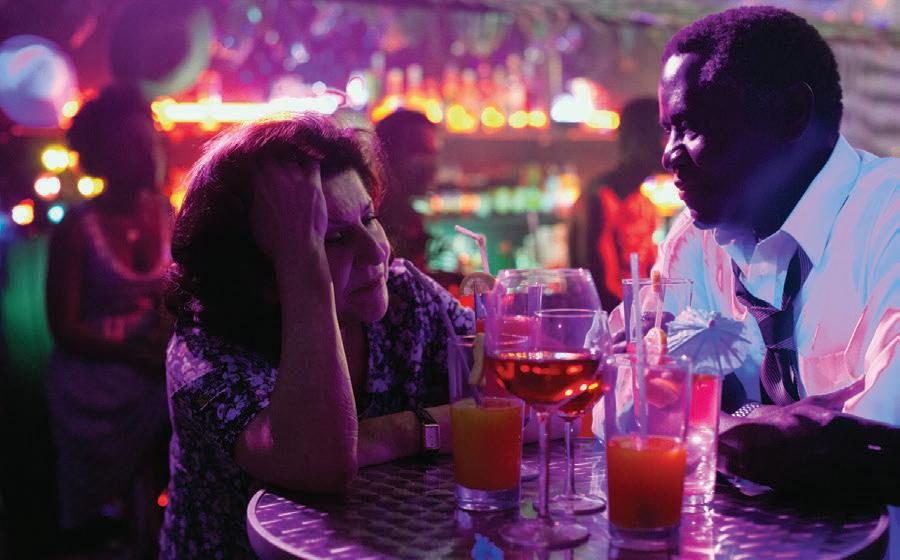

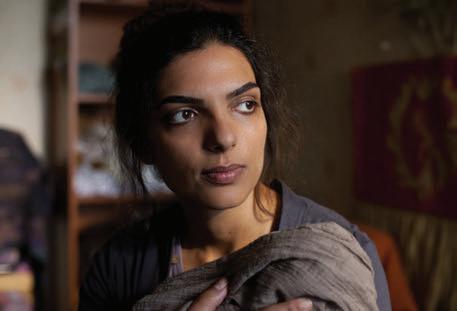
ABOUT THE LEADING ACTOR












The film’s star, Dr. Marcelo Cake-Baly himself is originally a refugee from Guinea-Bissau, and his life mirrors that of the character he plays in many respects. Fleeing war in Guinea Bissau, Cake-Baly went to Senegal, where he joined a school program that provided excellent students with a scholarship to go to Europe to complete their university studies. It was through this program that he came to Hungary. After earning a degree from Karl Marx University of Economics, Cake-Baly worked, for some time, as an economist for banks, while at the same time writing his PhD dissertation. He lost both of his positions in banking, however, due to the fact that he was not a Hungarian citizen. He eventually gained Hungarian citizenship, and has worked for Budapest Public Transportation (BKV) since 2005, after beating out dozens of other candidates. He currently helps direct the flow of traffic in the Hungarian capital. He is married with two children; the younger child, his daughter, is in 5th grade and suffers from health problems, while his older son has become involved in Hungarian politics, and is currently the director of the opposition party Dialogue for Hungary (Párbeszéd Magyarországért).

Our latest awards:
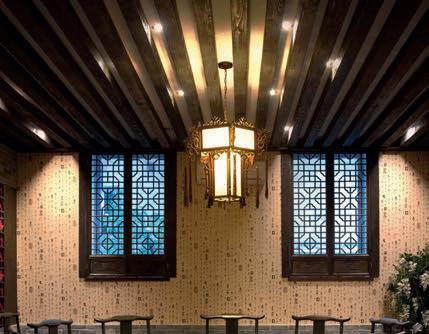


- Fine Restaurant Award (2015) - Best of Budapest & Hungary Award (2015)
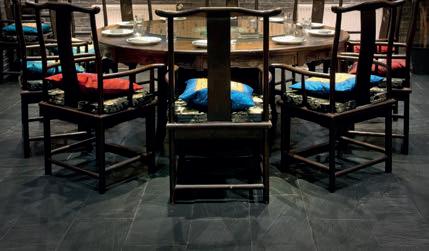



FEBRUARY 2017 |DIPLOMACY & TRADE www.dteurope.com
movie
photos by COURTESY PICTURES C Y CM MY CY CMY CityTaxi_Hirdetes.ai 1 2015.01.20. 8:26:22
正宗川菜
the true Chinese cuisine in the heart of Hungary! Enjoy the authentic flavours and the traditional design at Master Wang’s multi-award winning restaurant and experience the magic of the East in Budapest.
Our address: 1143 Budapest, Gizella út 46/a Reservation: +36 1 251-2959, or +36 70 419-5603
THE BEST CHINESE RESTAURANT IN BUDAPEST A LEGJOBB KÍNAI ÉTTEREM BUDAPESTEN
Discover
- Gault & Millau (2016)
society







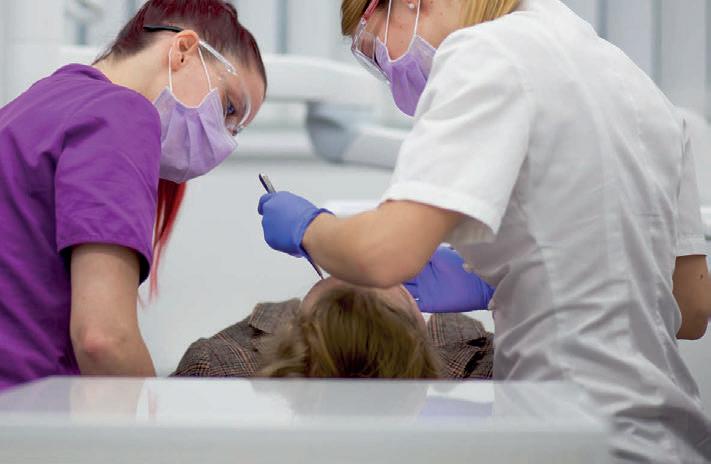
Slovene-Hungarian Anniversary
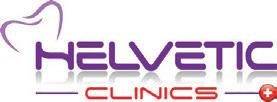


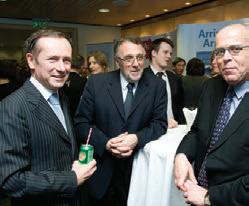
The Ambassador of the Republic of Slovenia, Ksenija Škrilec and Deputy Minister of Foreign Affairs and Trade, László Szabó welcomed guests in the Entrance Hall of the Ministry of Foreign Affairs and Trade in Budapest for the exhibition commemorating the 25th anniversary of the recognition of the Republic of Slovenia and the establishment of diplomatic relations.


New Year Presidential Reception
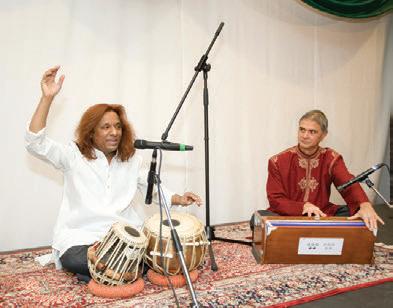
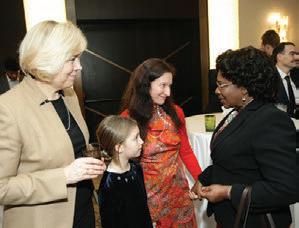




The President of the Republic of Hungary, János Áder, held his annual New Year Reception for the Diplomatic Corps. After welcoming the participating diplomats accredited to Budapest, the President expressed hope that 2017 will bring less fear and terror than the previous year. He also invited the guests to a musical performance by young Hungarian talents with “awe-inspiring virtuosity.”

Canada: 150th Anniversary




Canadian Ambassador Isabelle Poupart hosted a reception at the Embassy in early January to ring in the New Year and kick off celebrations in honor of Canada’s 150th Anniversary of Confederation. The Ambassador highlighted that the anniversary offers an ideal opportunity to highlight joint achievements by Canadians and Hungarians.
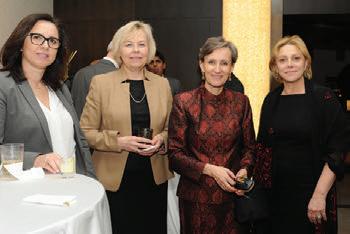


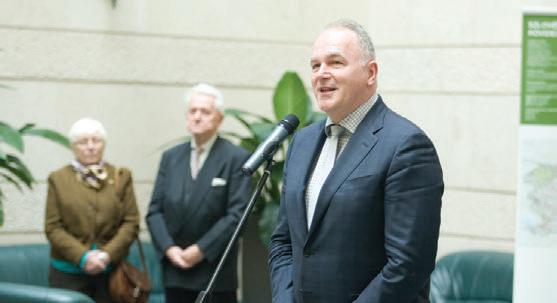
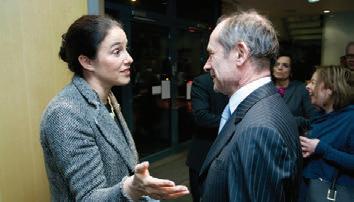
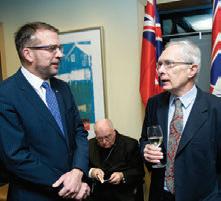


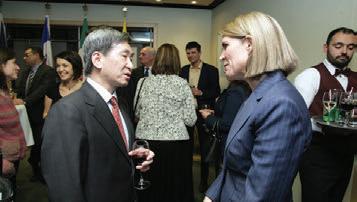
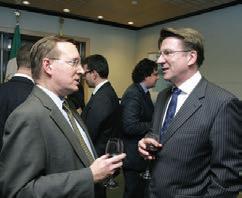
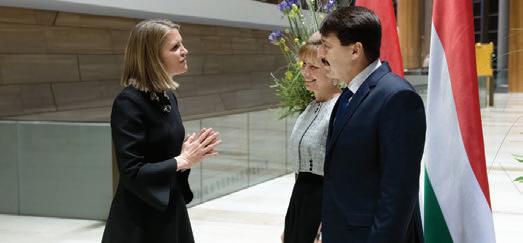
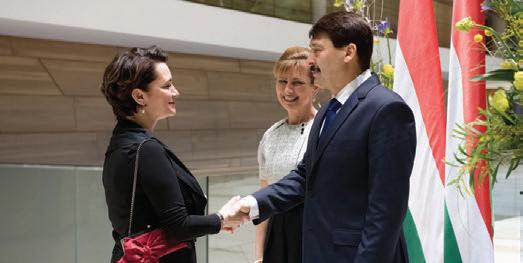
India Republic Day





To celebrate the 67th Anniversary of the Republic Day of his country, the Ambassador of the Republic of India, Rahul Chhabra and his wife invited fellow diplomats, Indians living in Hungary and other guests for a reception followed by dinner in the Grand Ball Room of the Kempinski Hotel Corvinus Budapest. The event honored the date on which the Constitution of India came into force on January 26, 1950.

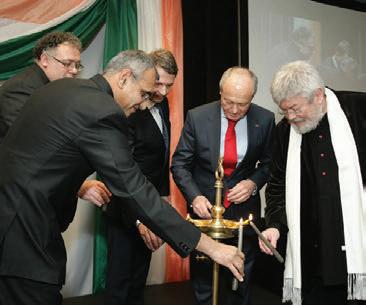

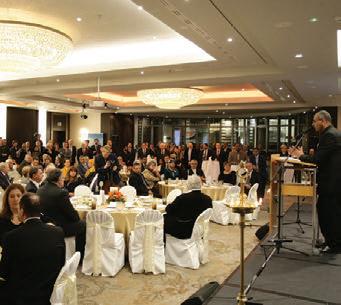
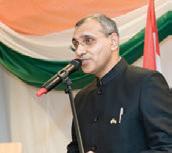
www.dteurope.com DIPLOMACY & TRADE| FEBRUARY 2017 27 photos by SZILÁRD KOSZTICSÁK/MTI, DÁVID HARANGOZÓ
SH O ON S ONE THE ART OF LILI ORSZÁG


UNTIL MARCH 26

AT THE HUNGARIAN NATIONAL GALLERY
“The walls are inside of me,” professed Lili Ország (1926–1978), a prominent figure of modern Hungarian painting, whose œuvre exhibition, of more than 300 works, opened recently. Throughout her career Ország recorded the perpetually emerging walls of her inner self with the patience and devotion of a monk. Although in spring 1944 she was saved from a train bound for Auschwitz, the fear and anxiety she felt at the time forever burnt into her mind. After graduating from the Academy of Fine Arts, Budapest, she instinctively began to search for “her own path”, and hence found her inner walls as a theme. Virtually unmatched by any other artist in Hungarian painting, she rendered her pictorial confessions in the tone of classical surrealism. Indeed, in the mid-1950s she made the greatest masterpieces of Hungarian surrealism. Lili Ország’s path took her from the walls of a ghetto to the Wailing Wall in Jerusalem. The stages of her artistic development can be traced from the individual walls she painted at the academy, through the city walls and the Western Wall of Jerusalem, to the walls of “her Labyrinth”a series of more than fifty compositions, which had not been displayed in this completeness, until now. www.mng.hu

ADHD

FEBRUARY 12 AT MÜPA
Björk may have moved to England, but Iceland's music scene is as lively as ever. In the capital of Reykjavik alone, there are five big jazz bands. There is also a range of occasional experimental groups in the city, which is how the four-member AdHd began, first getting together at a blues festival in 2008. From the very start, they found they shared an affinity in terms of their musical tastes and creative attitudes, deciding then and there that they would stay together. The group was organized on democratic lines: everyone equal, with no band leader despite a big age difference between the oldest and youngest members. At the 2008 festival, they played a range of old classics but have since only included their own songs in their repertoire. The members of AdHd place great emphasis on defining their own sound, which is closest to the genres of retro and jazz-rock. The often melancholy themes regularly veer towards free jazz, with compositions typically taking unpredictable turns. While their melodies sometimes lean towards the ECM style, the use of electric guitars’ and bass guitars’ echo effects recall the mood of old British jazz-rock. The group has released five albums to date, all on their own label. When not in the studio, they are constantly touring. With every new recording, fans can feel the benefits of the band's togetherness and constant practice. AdHd presumably refers to the constant activity of its founders, the name is derived from the medical condition, Attention Deficit Hyperactivity Disorder. As far as AdHd's music is concerned, that is nothing but a sign of good health. www.mupa.hu
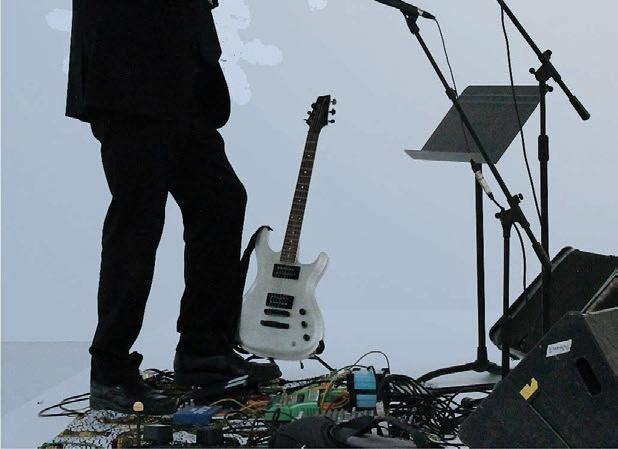
THE CHAMPION

UNTIL MID APRIL AT MILLENÁRIS, PAVILION D
Learn what you are a champion of by visiting this brand new interactive exhibition featuring cutting edge technologies, impressive images and playful tests. “Becoming a champion is everyone’s dream. (...) When one wins, it is never by chance, he or she must have invested a lot of effort in it. The victory can never be taken away. It will escort that person all through life – with its advantages and disadvantages,” says Hungarian water polo Olympic champion Tibor Benedek, main patron of this unique exhibition that premiers in Budapest before kicking off an international tour. ‘The Champion’ will introduce the general public to the world of sports with high definition photos, slow motion recordings and other visual effects. One unique feature of the exhibition is that visitors can monitor their own capabilities helping, for instance, parents in choosing a sport discipline for their children. www.thechampion.hu
MOH MM MMM N H S CH H M
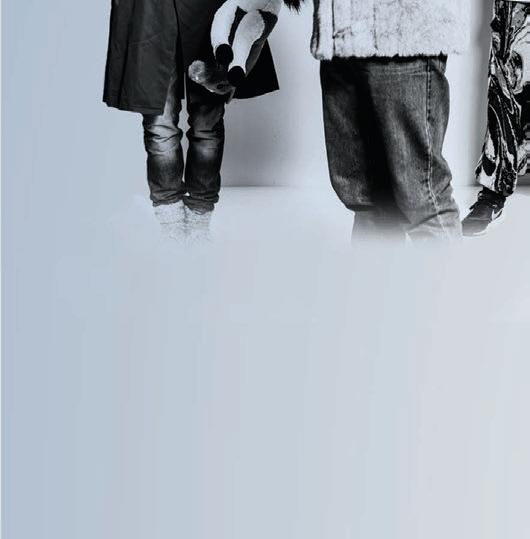
FEBRUARY 11 AT TRAFÓ
Mohammad (MMMD) is a Greek trio that has been forging their deep monolithic sound for the past 6 years, bringing together low frequencies, inter-modulations, dark textures, and distant folk nuances through custom made instruments and software. Prolific in their output with 6 releases to date, their sonic arsenal is equally deployed live, a ceremonial experience in physical sound that evokes a wide emotional palette.
Rhys Chatham is a composer and multi-instrumentalist from Manhattan, currently living in Paris, who fuses avant-garde minimalism with the electric crunch of punk rock. Chatham's instrumentation ranges from the seminal composition Guitar Trio, composed in 1977 for 3 electric guitars, electric bass and drums, to the epoch evening-length work for 100 electric guitars, An Angel Moves Too Fast to See, composed in 1989... all the way to Chatham's recent composition for 200 electric guitars, A Crimson Grail, last performed in New York at the Lincoln Center Outdoor Summer Festival in 2009. Chatham spent most of the 90s playing the trumpet, releasing works on labels as diverse as Ninja Tune, The Wire Editions and Virgin Records and later Northern-Spy Records. Adding flute and electric guitar to the mix, Chatham is currently touring as a solo performer, playing versions of his recently released LP, A Pythagorean Dream, from Foom Records. www.trafo.hu
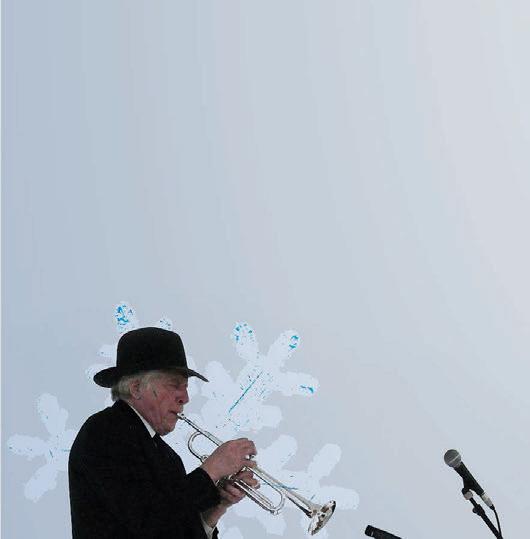
UC CHO S CONCE
7 AT AKVÁRIUM KLUB
FEBRUARY


Armed with the belief that positive music can change the world, Lucky Chops is on a mission to bring life back into the music industry. The band is well known for spontaneity and dance vibe. One would never tell they only play brass instruments. The intensity of the band’s energy is fueled by its desire to inspire others. Lucky Chops became famous thanks to a random spectator, who shot the band’s street performance and shared it with world on internet. The band suddenly became a viral sensation and its members became popular performers in New York’s streets and underground. The hard work and dedication put in by each of the six members has been recognized by fans across the globe. www.livenation.hu
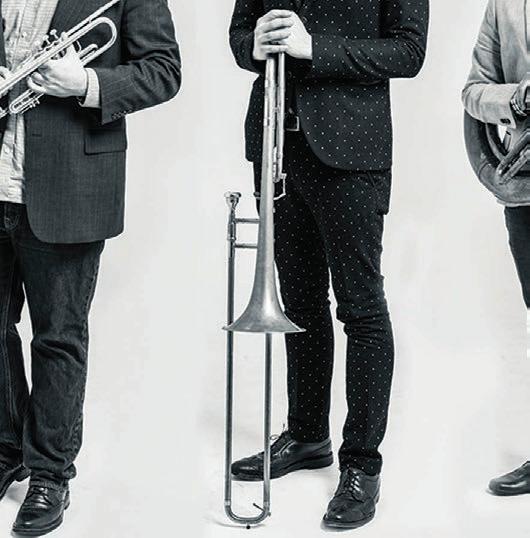
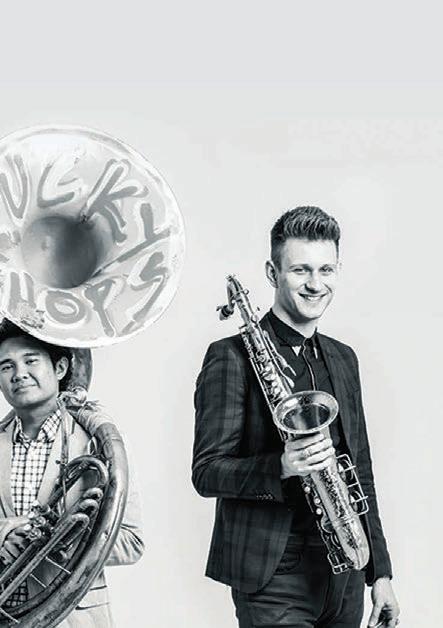
BUDAPEST BOAT SHOW 2017
FEBRUARY 23-26 AT HUNGEXPO BUDAPEST FAIR CENTER
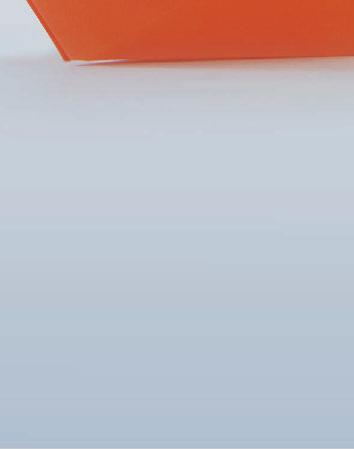
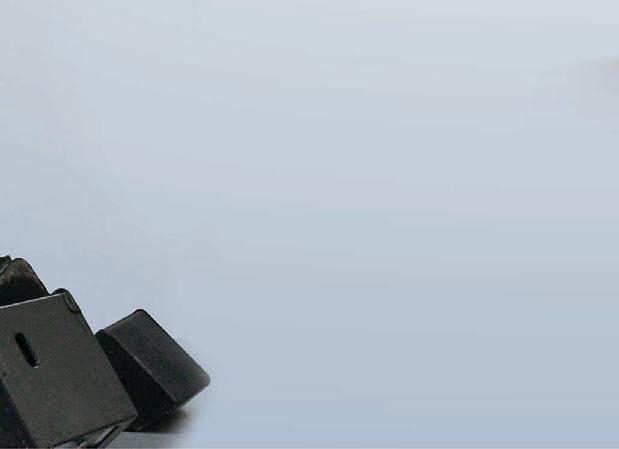



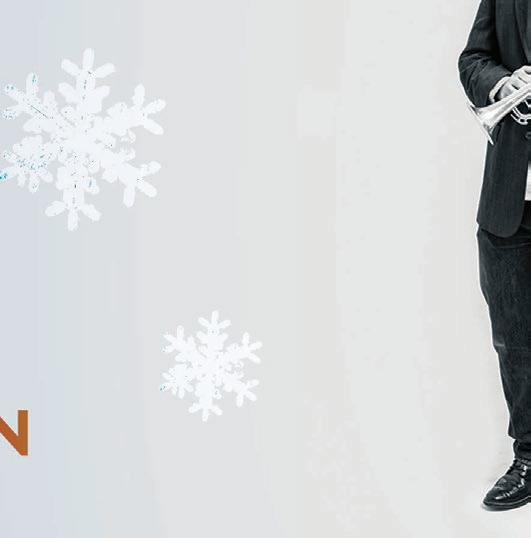
This is the greatest Hungarian boat exhibition; the opening event of the sailing, boating and water sport season. The annual exhibition attracted 60.000 people last year. During the four days of this year’s show, up to 80 exhibitors will present their sail, electronic and motor boats, countless accessories, sail brands and services, along with the latest developments in boat engineering and boating accessories. The main theme of the exhibition in 2017 is leisure shipping. www.hungexpo.hu
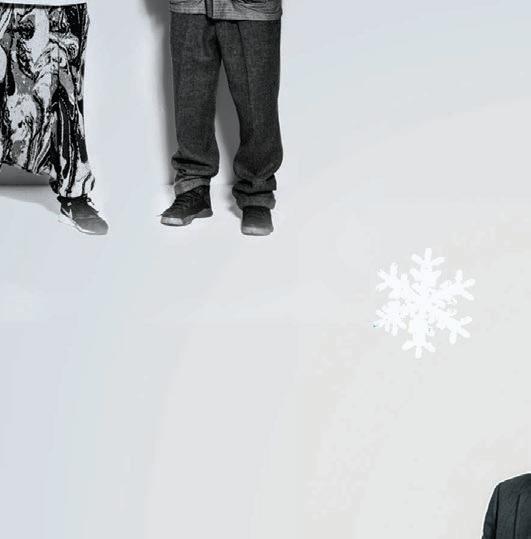
FEBRUARY 2017 |DIPLOMACY & TRADE www.dteurope.com 28 photos by LILI ORSZÁG, COURTESY PICTURES
US S M CH OF HE US S


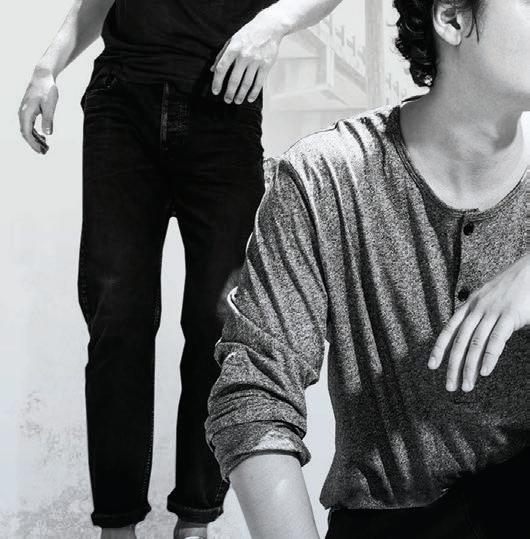

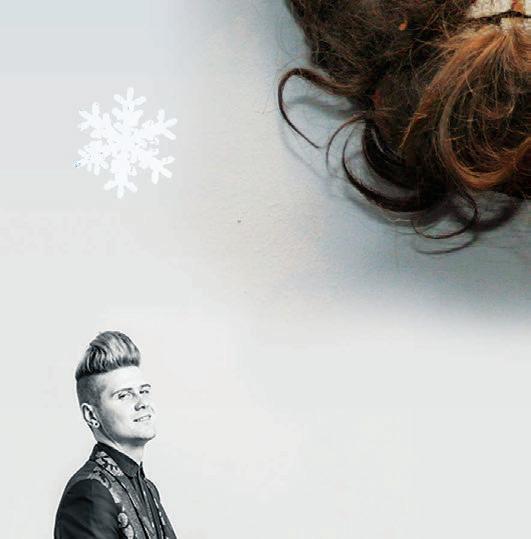
UNTIL FEBRUARY 23-28 IN MOHÁCS, 160 KM SOUTH OF BUDAPEST


Busójárás, a pagan Hungarian heritage, is the symbolic ‘burying’ of winter and the welcoming of spring. The annual, six-day fest involves folk music, dance and parades featuring the Busós, that is, people wearing traditional masks and sheepskin vests or jackets as costumes resembling monsters from Hungarian folk tale heritage. They usually carry large wooden noisemakers or cowbells, and make quite a racket. As a highlight of the march, the Busós make their way to the bank of the River Danube where they set afloat a coffin, containing a Busó costume. On the very last day of the festival, they burn another coffin on the main square of the town. Concerning the festival’s roots in legends, many soldiers and residents allegedly escaped to Mohács Island after the defeat of the Hungarian army in 1526. Here, they decided to drive the invading Turks away from their new home. As they dressed up in Busó costumes and masks, the Turks ran away in panic and fear. Busójárás has gone through changes in past years, losing some of these traditional elements. Yet, it has managed to preserve its basic symbolism. “The municipality of Mohács does everything to preserve these traditions for future generations, and not to let the festival turn into some wacky old bazaar,” organizers say. www.mohacsibusojaras.hu


LOVE AND OTHER DEMONS

FEBRUARY 5 AND 8 AT THE OPERA HOUSE, IN ORIGINAL LANGUAGES, WITH HUNGARIAN AND ENGLISH SUBTITLES
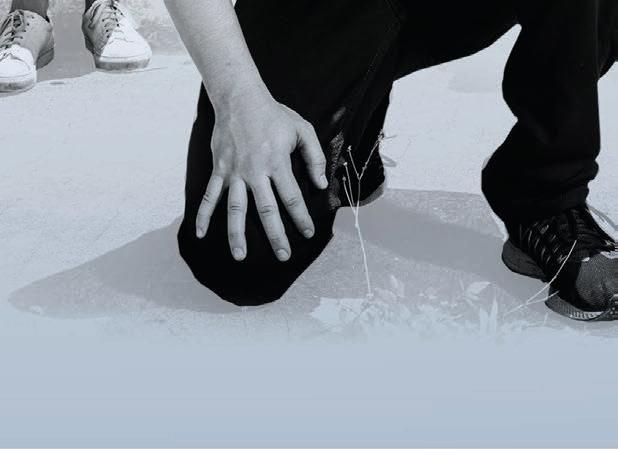





Peter Eötvös's fifth opera was commissioned by the Glyndebourne Festival and composed to Kornél Hamvai's multilingual libretto (constructed with elements of Yoruba, Latin and Spanish, in addition to the English) based on Gabriel García Márquez's novella of the same title. “This fantasy world helps me to concentrate on the music, rather than focus too much on the plot. This is my first opera about love, and also my first quasi-belcanto piece that allows the singers to show off the beauty of their voices,” said the composer. In other words, it has all the makings of an exciting theatrical experience, including a story full of operatic elements (religious intolerance, demonic possession and forbidden love), and Eötvös himself states that this is his most melodic mu ic i e critic a e ca ed it ma ica nd it a ein ta ed i iu urc rete t e Romanian theater director renowned across Europe, whose productions are characterized by confident handling of the acting and by powerful imagery. www.opera.hu
LUKAS GRAHAM CONCERT
MARCH 19 AT PAPP LÁSZLÓ
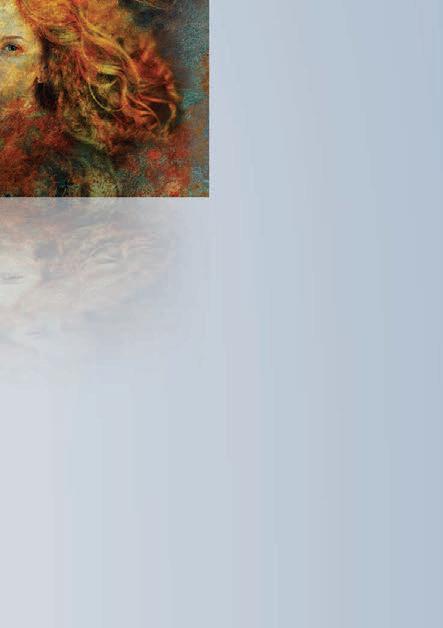
BUDAPEST SPORTARENA
Lukas Graham, whose hit single '7 Years' just went multiplatinum all over the world, will embark on an expansive headlining tour early next year. The tour kicks off in February 2017 in the UK, where the band has just finished a small run of sold out shows and will crisscross Europe through mid-April, making stops in Ireland, Belgium, Holland, Germany, Austria, Hungary, Poland, France, Switzerland, Italy, Spain, Portugal and more along the way. The upcoming tour will see the Danish foursome graduate to theaters four to five times larger than the clubs they recently performed in during their sold-out Spring US headline tour. www.livenation.hu


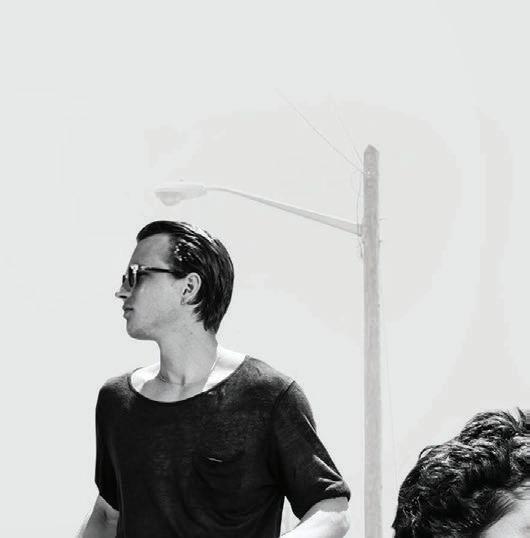
29 photos by DÁVID HARANGOZÓ, COURTESY PICTURES www.dteurope.com DIPLOMACY & TRADE| FEBRUARY 2017
gastronomy
february
DID YOU KNOW?
• FURMINT is the grape responsible for Hungary’s legendary dessert wines from the Tokaj region, which presents some of the world’s greatest vineyards. However, this grape is perfectly capable of producing a variety of styles ranging from bone dry to extremely sweet wines afflicted by noble rot. Therefore, vintners from Tokaj have started to reintroduce their classic grape lately, producing top-quality dry wines, which feature the style and persona of big, oak-fermented and aged wines such as a white Burgundy.
• The name FURMINT is taken from the word "froment" for the wheatgold color of the wine it produces. While it is possible that it is native to Hungary, the grape was likely brought to Hungary in the 13th century. Luckily, the Carpathian Basin proved to be the most ideal home for this variety, which is resistant against winter freezes and illnesses, and it can stand both the strong sunlight and rainy but warm autumns. There are variable types, but white is dominant.

• By tradition, the harvest of FURMINT starts on Oct 28. During the long ripening period, the thin skinned berries concentrate a very high level of sugars, making them particularly susceptible to 'Botrytis', the noble rot. These grapes possess excellent acidity.

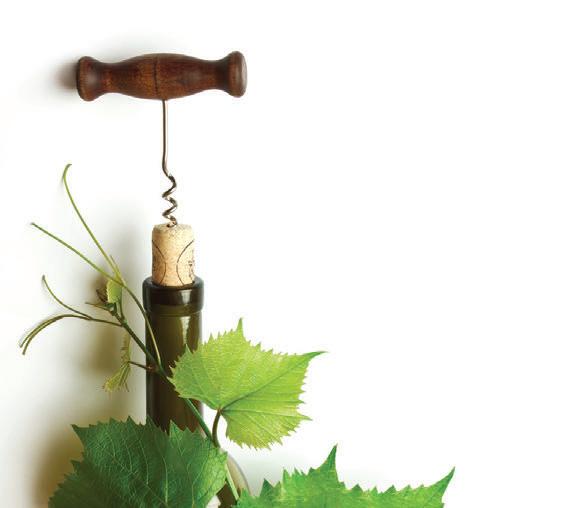
• Furmint is rarely seen outside of Hungary, except for Germany and those countries surrounding the Hungarian borders. Within Hungary, Furmint is also cultivated in Somló, but mainly in the Tokaj region.

Furmint February is a campaign running in Hungary with the aim of getting people more familiar with this specific white grape variety. Wine tasting, special dinners and furmint tasting packages are offered to wine lovers countrywide, following the main tasting event to be held on February 2 at Budapest’s Vajdahunyad castle, with the presence of some 90 wine cellars and winemakers. Furmint is a hidden treasure. While the world seems to be awash with Chardonnay, Furmint also has every potential to attract serious consumer interest with its wide spectrum of flavors. This is the motto of a series of events entitled ‘Furmint February,’ brainchild of Dániel Kézdy. This year’s celebration is the 8th being held in a variety of ways throughout the country.
UNFORGETTABLE VALENTINE'S DINNER AT BARAKA


Price for the degustation menu HUF 24,900 / person
BARAKA RESTAURANT - 1051 BUDAPEST DOROTTYA STREET 6. +36 1 200 0817 reservations@barakarestaurant.hu www.barakarestaurant.hu
Baraka has carefully created a sensual tasting menu for you to celebrate an unforgettable Valentine's day with your special someone. The seductive Baraka is the perfect setting to explore creative French-Asian dishes of fresh oysters, blue lobster, melt in your mouth foie gras, silky bluefin tuna, succulent veal, passionfruit, and of course, chocolate. You can enjoy this gourmet event with an exquisite wine pairing, or Baraka’s new artisan cocktail "sidecar" experience. Create a romantic gastronomic memory together...
VINCE BUDAPEST 2017
This year's edition of the three-day annual wine event organized by VinCE Magazine will kick off on March 17. The event that traditionally presents the world’s most respected wine celebrities is a paradise for wine lovers and for professionals it is a must. The event, traditionally organized at Budapest’s Grand Hotel Corinthia will feature 1,000 different types of wine from 160 exhibitors this year. Besides displaying an awesome cornucopia of wines, the exhibition also offers seated tastings – master classes – and interactive workshops where wine lovers may sip both wine and knowledge, while wineries receive up-to-date information and efficient assistance. The 2017 edition will feature Fiona Beckett, a leading expert on matching wine and food, and Jean-Baptiste Lécaillon, chef de caves at Maison Roederer who will present the favorite sparkling wines of the high society. www.vincebudapest.hu
HUNGARY’S FINE PERFORMANCE AT THE 30TH BOCUSE D’OR

Among the 24 participating countries selected for the grand finale of the Bocuse d’Or, Hungary wins 4th place and two special prizes.

When Hungarian chef Tamás Széll and his team won the European final of Bocuse d’Or last year, they qualified to take part in the World Final in Lyon, France on January 24-25. Following a year of practice and rehearsals involving much abnegation and extreme concentration, the team was ready for the very intense, two-day competition - an event that revealed the new stars of gastronomy worldwide and also marked the 30th anniversary of this unique contest that was created by Paul Bocuse, the founder of haute cuisine. Performing live in front of thousands of people that included some 300 enthusiastic Hungarian supporters, Tamás Széll and his team finished 4th, following Iceland winner of the Bronze Bocuse, Norway, the Silver medal winner and the USA winner of the Bocuse d’Or, the most prestigious reward in the world of gastronomy.
OTHER SPECIAL PRIZES
PRIZE FOR THE BEST COMMIS
Benjamin Vakanas, France
SPECIAL VEGETAL PLATE PRIZE
France
SPECIAL PLATE PRIZE
Hungary
PRIZE FOR THE BEST PROMOTION
CAMPAIGN
Australia
PRIZE FOR THE BEST POSTER
Hungary

FEBRUARY 2017 |DIPLOMACY & TRADE www.dteurope.com
30
photos by SHUTTERSTOCK.COM, PIXABAY.COM, FURMINT PHOTO, LAURA NAGY/PRISMA, ZSOLT BATÁR, 123RF.COM FURMINT
Valentine’s Day IN ARAZ R EST AU RA NT H–1074 Budapest, Dohány utca 42–44. | Table reservation: +36 1 815 1100 | araz@araz.hu | www.araz.hu 14th February 2017 at 7pm Romantic four-course dinner with live music
HUF + 10 % service charge Professional photographer prepares abiding memories. 127,5x86_Valentine'sday_CHB2017.indd 1 23/01/17 12:47
9490
7TH PRESTIGE AWARD CEREMONY
The professional and media jury of Prestige Reserve Club handed out its Prestige Award to recognize the most prestigious winery of the year 2016. Following previous years’ renowned winners stv n e sy in 2010 and 201 y rgy őrinc in 2011, Ferenc Takler in 2012, István Jásdi in 2014 and the Heimann Family Winery in 2015), the 2016 trophy, a statue of the proud Bacchus (work of scul tor a s r went to is n kő ineyard and Winery. The jury considered the following criteria: professional prestige, performance, reputation, authenticity and customer perception of the winery, the excellence and recognition of its wines, brand positioning, awareness and acceptance, business success and market position, distribution and sales channels.
The Prestige Award jury also recognizes other, winerelated businesses that play important role in sector and perform with excellence. In 2016, four new categories were introduced: ‘best wine restaurant’, ‘best wine hotel’, ‘best wine marketing’ and ‘best wine event’. The winners in the first two categories are St. Andrea Wine & Gourmet Bar and Bock Hotel Ermitage, while the ‘best wine marketing’ title went to BalatonBor, and Borjour Magnum was named ‘best wine event’.
Founder of the Prestige Reserve Club and Prestige Award, László Doszpod praised the winners’ performance.


is n kő inery owes its fa e to the hard work of the estate manager, László Mészáros, who has led the co any for ore than twenty years is n kő became a pioneer, rethinking the quality and style of aszú in the 90’s. As a result, the wines of the winery are now available in 40 countries. The St. Andrea Wine & Gourmet Bar is successful despite or perhaps because its selection of wines is based on a single winery’s portfolio. They interpret ‘open minded Hungarian flavors’ in a detailed, innovative and interesting way under the hands of chef, Ádám Barna. The restaurant, managed by Miklós Lizsicsár,
Winners of the Prestige Award, founded by László Doszpod and the Prestige Reserve Club, were named for the seventh time in 2016. The award ceremony again took place at Kárpátia Restaurant.
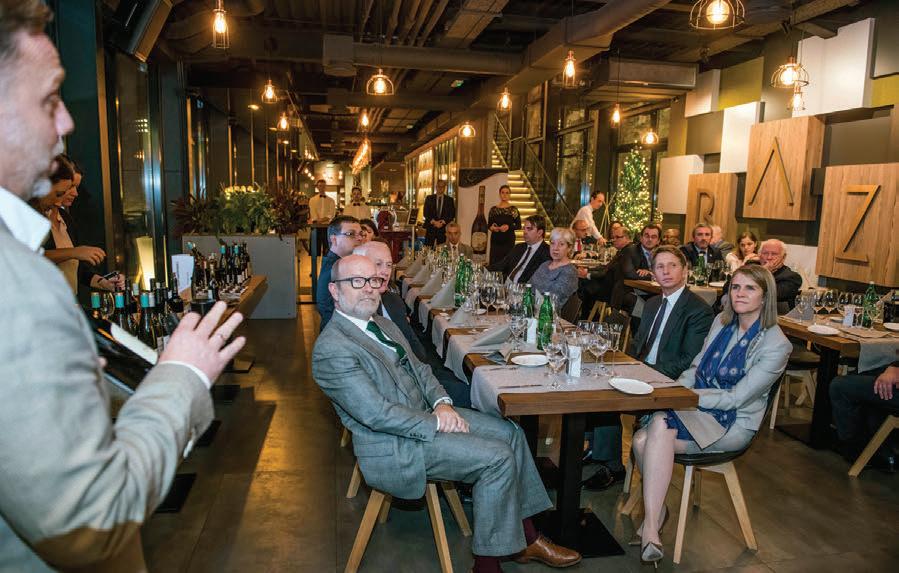
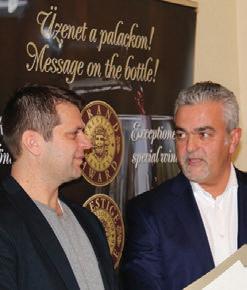
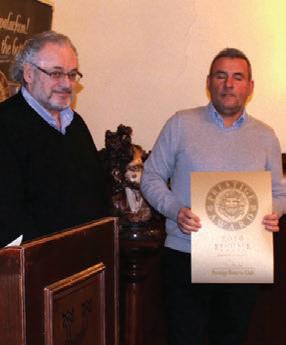
features a warm, buzzing atmosphere and extremely polite service. The image of Bock Hotel Ermitage is closely related to Bock Winery. It offers a good restaurant too, making this combination extremely popular. High quality wine and gastronomy events also contribute to this success. The project named ‘BalatonBor’ was created by Balatoni Kör (Balaton Circle), and it has been a successful initiative as a regional brand and community product from the start. Gábor Kardos, Bence Laposa and Tamás Kovács implemented the concept of multi-level branded wines that feature a uniform image and meet a selection of criteria to be named BalatonBor (BalatonWine). Today, some 21 wineries produce Balatonbor and Hegybor (Hill Wine) is also available, produced by 13 different wineries. Borjour, launched in 2009, is the brainchild of Sebestyén Nagy, Gábor Tóth and Sára Megyeri. It embraces nearly the whole spectrum of high quality wine events in Budapest with its Mini, Classic and Magnum genres.”
During the award ceremony, Budapest Week Publishing, represented by Publisher Peter Freed and Editor-in-chief Réka Alíz Francisck, presented communication packages to the awardees.
Members of the jury:
András Csizmadia PhD, András Török, Attila Fiáth, ttila r s gnes Herc eg gnes eth saba Harmath, Dániel Ercsey, Emese Domián, Ferenc Baji, Ferenc Takler, Gabriella Mészáros PhD, Gábor Bányai, Gábriel István Nyulasi, Gábor Kapuvári, bor oh ly ianni nnoni y rgy őrinc Ph Hedvig Tallián, Imre Tompa, Ildikó Káli, István Jásdi, István Szepesy, József Kling, József Matyók, József Kosárka, Kálmán Kozma, László Doszpod, Levente Ruck, Mátyás Szik, Mihály Fabók, Miklós Niszkács, Péter Freed, Richárd Németh, Rita Bérczes, Robert Smyth, Sándor Darin, Sándor Ember, Sebestyén Nagy, Sue Tolson, Szilárd Pelyhe, Tamás Freund, Tamás Mezei, Zoltán Heimann, Zoltán Kertai, Zoltán Sánta, Zsófia Bozzai
TOGETHER IN WINE
FIRST THE DIPLOMATS’ HARVEST, NOW THE DIPLOMATS’ WINE!
The Ministry of Agriculture held its now traditional diplomats’ harvest at the Hajós-Baja Koch Winery in 2016. The ambassadors picked so much Chardonnay that Minister Sándor Fazekas proposed making a special wine from it.

The 2016 diplomats’ wine, or rather Csaba Koch’s Chardonnay with the fancy name
Together in Wine, made its debut at the National Wines of Excellence Program’s traditional Advent wine preview in front of the ambassadors accredited to Hungary. The President of the National Wine Expert Commission (OBB), András Horkay
International Wine Academic, presented the wines, including the diplomatic wine made from the grapes harvested by ambassadors in September, to the elegation heads in the rkert a r restaurant The latest diplomats’ harvest was not just a representative event; the ambassadors picked grapes from the Hajós-Baja estate’s best Chardonnay vines for nearly two hours, resulting in more than a thousand kilos of fruit in their baskets and then the press. Csaba Koch produced the wine with special care from selected grapes and bottled it at the start of December following brief maturation in oak. This slightly buttery, fragrant Chardonnay will not go on sale commercially, but will primarily play a representative role at the Koch Winery’s special tasting events.
“I really like Csaba Koch’s wines and I hope that the grapes we picked will produce a wine as good as the rest of his wines”, Former French ambassador Roland Galharague said during the September harvest. The praise of the wine superpower’s representative counts for a lot, especially relating to a wine region like Hajós-Baja, little known outside Hungary. Many diplomats, including the then US ambassador Colleen Bell, didn’t only valiantly pull their weight in the vineyard, but also purchased Csaba Koch’s award-winning (both nationally and
internationally) Kadarka, his 2013 late-harvest Chardonnay and the president of the wine region’s ill ny och in rt inery s flagshi wine san d Minister Sándor Fazekas, who also participated in the harvest, pointed out that “Hungarian wine-making is experiencing a period of quality renaissance” and that the wonderful wines from the 2016 vintage could strengthen Hungary’s image in the world. “The increasingly high-quality Hungarian wines have already become an effective diplomatic tool; strengthening friendly relationships between countries while also being the precursors of common economic successes,” he emphasized.


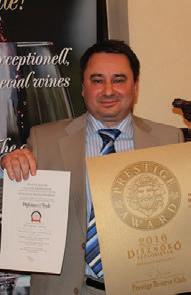
31 www.dteurope.com DIPLOMACY & TRADE| FEBRUARY 2017 wine photos by PRESTIGE RESERVE CLUB, CSABA PELSŐCZY
CHAMPION THE MATCH






















































































































































 Peter Freed PUBLISHER
Peter Freed PUBLISHER



 Noémi Bruzák, Szilárd Koszticsák, Zsolt Szigetváry
Noémi Bruzák, Szilárd Koszticsák, Zsolt Szigetváry
























































































































































































































